An official website of the United States government
The .gov means it’s official. Federal government websites often end in .gov or .mil. Before sharing sensitive information, make sure you’re on a federal government site.
The site is secure. The https:// ensures that you are connecting to the official website and that any information you provide is encrypted and transmitted securely.
- Publications
- Account settings
Preview improvements coming to the PMC website in October 2024. Learn More or Try it out now .
- Advanced Search
- Journal List
- Springer Nature - PMC COVID-19 Collection


A review of the global climate change impacts, adaptation, and sustainable mitigation measures
Kashif abbass.
1 School of Economics and Management, Nanjing University of Science and Technology, Nanjing, 210094 People’s Republic of China
Muhammad Zeeshan Qasim
2 Jiangsu Key Laboratory of Chemical Pollution Control and Resources Reuse, School of Environmental and Biological Engineering, Nanjing University of Science and Technology, Xiaolingwei 200, Nanjing, 210094 People’s Republic of China
Huaming Song
Muntasir murshed.
3 School of Business and Economics, North South University, Dhaka, 1229 Bangladesh
4 Department of Journalism, Media and Communications, Daffodil International University, Dhaka, Bangladesh
Haider Mahmood
5 Department of Finance, College of Business Administration, Prince Sattam Bin Abdulaziz University, 173, Alkharj, 11942 Saudi Arabia
Ijaz Younis
Associated data.
Data sources and relevant links are provided in the paper to access data.
Climate change is a long-lasting change in the weather arrays across tropics to polls. It is a global threat that has embarked on to put stress on various sectors. This study is aimed to conceptually engineer how climate variability is deteriorating the sustainability of diverse sectors worldwide. Specifically, the agricultural sector’s vulnerability is a globally concerning scenario, as sufficient production and food supplies are threatened due to irreversible weather fluctuations. In turn, it is challenging the global feeding patterns, particularly in countries with agriculture as an integral part of their economy and total productivity. Climate change has also put the integrity and survival of many species at stake due to shifts in optimum temperature ranges, thereby accelerating biodiversity loss by progressively changing the ecosystem structures. Climate variations increase the likelihood of particular food and waterborne and vector-borne diseases, and a recent example is a coronavirus pandemic. Climate change also accelerates the enigma of antimicrobial resistance, another threat to human health due to the increasing incidence of resistant pathogenic infections. Besides, the global tourism industry is devastated as climate change impacts unfavorable tourism spots. The methodology investigates hypothetical scenarios of climate variability and attempts to describe the quality of evidence to facilitate readers’ careful, critical engagement. Secondary data is used to identify sustainability issues such as environmental, social, and economic viability. To better understand the problem, gathered the information in this report from various media outlets, research agencies, policy papers, newspapers, and other sources. This review is a sectorial assessment of climate change mitigation and adaptation approaches worldwide in the aforementioned sectors and the associated economic costs. According to the findings, government involvement is necessary for the country’s long-term development through strict accountability of resources and regulations implemented in the past to generate cutting-edge climate policy. Therefore, mitigating the impacts of climate change must be of the utmost importance, and hence, this global threat requires global commitment to address its dreadful implications to ensure global sustenance.
Introduction
Worldwide observed and anticipated climatic changes for the twenty-first century and global warming are significant global changes that have been encountered during the past 65 years. Climate change (CC) is an inter-governmental complex challenge globally with its influence over various components of the ecological, environmental, socio-political, and socio-economic disciplines (Adger et al. 2005 ; Leal Filho et al. 2021 ; Feliciano et al. 2022 ). Climate change involves heightened temperatures across numerous worlds (Battisti and Naylor 2009 ; Schuurmans 2021 ; Weisheimer and Palmer 2005 ; Yadav et al. 2015 ). With the onset of the industrial revolution, the problem of earth climate was amplified manifold (Leppänen et al. 2014 ). It is reported that the immediate attention and due steps might increase the probability of overcoming its devastating impacts. It is not plausible to interpret the exact consequences of climate change (CC) on a sectoral basis (Izaguirre et al. 2021 ; Jurgilevich et al. 2017 ), which is evident by the emerging level of recognition plus the inclusion of climatic uncertainties at both local and national level of policymaking (Ayers et al. 2014 ).
Climate change is characterized based on the comprehensive long-haul temperature and precipitation trends and other components such as pressure and humidity level in the surrounding environment. Besides, the irregular weather patterns, retreating of global ice sheets, and the corresponding elevated sea level rise are among the most renowned international and domestic effects of climate change (Lipczynska-Kochany 2018 ; Michel et al. 2021 ; Murshed and Dao 2020 ). Before the industrial revolution, natural sources, including volcanoes, forest fires, and seismic activities, were regarded as the distinct sources of greenhouse gases (GHGs) such as CO 2 , CH 4 , N 2 O, and H 2 O into the atmosphere (Murshed et al. 2020 ; Hussain et al. 2020 ; Sovacool et al. 2021 ; Usman and Balsalobre-Lorente 2022 ; Murshed 2022 ). United Nations Framework Convention on Climate Change (UNFCCC) struck a major agreement to tackle climate change and accelerate and intensify the actions and investments required for a sustainable low-carbon future at Conference of the Parties (COP-21) in Paris on December 12, 2015. The Paris Agreement expands on the Convention by bringing all nations together for the first time in a single cause to undertake ambitious measures to prevent climate change and adapt to its impacts, with increased funding to assist developing countries in doing so. As so, it marks a turning point in the global climate fight. The core goal of the Paris Agreement is to improve the global response to the threat of climate change by keeping the global temperature rise this century well below 2 °C over pre-industrial levels and to pursue efforts to limit the temperature increase to 1.5° C (Sharma et al. 2020 ; Sharif et al. 2020 ; Chien et al. 2021 .
Furthermore, the agreement aspires to strengthen nations’ ability to deal with the effects of climate change and align financing flows with low GHG emissions and climate-resilient paths (Shahbaz et al. 2019 ; Anwar et al. 2021 ; Usman et al. 2022a ). To achieve these lofty goals, adequate financial resources must be mobilized and provided, as well as a new technology framework and expanded capacity building, allowing developing countries and the most vulnerable countries to act under their respective national objectives. The agreement also establishes a more transparent action and support mechanism. All Parties are required by the Paris Agreement to do their best through “nationally determined contributions” (NDCs) and to strengthen these efforts in the coming years (Balsalobre-Lorente et al. 2020 ). It includes obligations that all Parties regularly report on their emissions and implementation activities. A global stock-take will be conducted every five years to review collective progress toward the agreement’s goal and inform the Parties’ future individual actions. The Paris Agreement became available for signature on April 22, 2016, Earth Day, at the United Nations Headquarters in New York. On November 4, 2016, it went into effect 30 days after the so-called double threshold was met (ratification by 55 nations accounting for at least 55% of world emissions). More countries have ratified and continue to ratify the agreement since then, bringing 125 Parties in early 2017. To fully operationalize the Paris Agreement, a work program was initiated in Paris to define mechanisms, processes, and recommendations on a wide range of concerns (Murshed et al. 2021 ). Since 2016, Parties have collaborated in subsidiary bodies (APA, SBSTA, and SBI) and numerous formed entities. The Conference of the Parties functioning as the meeting of the Parties to the Paris Agreement (CMA) convened for the first time in November 2016 in Marrakesh in conjunction with COP22 and made its first two resolutions. The work plan is scheduled to be finished by 2018. Some mitigation and adaptation strategies to reduce the emission in the prospective of Paris agreement are following firstly, a long-term goal of keeping the increase in global average temperature to well below 2 °C above pre-industrial levels, secondly, to aim to limit the rise to 1.5 °C, since this would significantly reduce risks and the impacts of climate change, thirdly, on the need for global emissions to peak as soon as possible, recognizing that this will take longer for developing countries, lastly, to undertake rapid reductions after that under the best available science, to achieve a balance between emissions and removals in the second half of the century. On the other side, some adaptation strategies are; strengthening societies’ ability to deal with the effects of climate change and to continue & expand international assistance for developing nations’ adaptation.
However, anthropogenic activities are currently regarded as most accountable for CC (Murshed et al. 2022 ). Apart from the industrial revolution, other anthropogenic activities include excessive agricultural operations, which further involve the high use of fuel-based mechanization, burning of agricultural residues, burning fossil fuels, deforestation, national and domestic transportation sectors, etc. (Huang et al. 2016 ). Consequently, these anthropogenic activities lead to climatic catastrophes, damaging local and global infrastructure, human health, and total productivity. Energy consumption has mounted GHGs levels concerning warming temperatures as most of the energy production in developing countries comes from fossil fuels (Balsalobre-Lorente et al. 2022 ; Usman et al. 2022b ; Abbass et al. 2021a ; Ishikawa-Ishiwata and Furuya 2022 ).
This review aims to highlight the effects of climate change in a socio-scientific aspect by analyzing the existing literature on various sectorial pieces of evidence globally that influence the environment. Although this review provides a thorough examination of climate change and its severe affected sectors that pose a grave danger for global agriculture, biodiversity, health, economy, forestry, and tourism, and to purpose some practical prophylactic measures and mitigation strategies to be adapted as sound substitutes to survive from climate change (CC) impacts. The societal implications of irregular weather patterns and other effects of climate changes are discussed in detail. Some numerous sustainable mitigation measures and adaptation practices and techniques at the global level are discussed in this review with an in-depth focus on its economic, social, and environmental aspects. Methods of data collection section are included in the supplementary information.
Review methodology
Related study and its objectives.
Today, we live an ordinary life in the beautiful digital, globalized world where climate change has a decisive role. What happens in one country has a massive influence on geographically far apart countries, which points to the current crisis known as COVID-19 (Sarkar et al. 2021 ). The most dangerous disease like COVID-19 has affected the world’s climate changes and economic conditions (Abbass et al. 2022 ; Pirasteh-Anosheh et al. 2021 ). The purpose of the present study is to review the status of research on the subject, which is based on “Global Climate Change Impacts, adaptation, and sustainable mitigation measures” by systematically reviewing past published and unpublished research work. Furthermore, the current study seeks to comment on research on the same topic and suggest future research on the same topic. Specifically, the present study aims: The first one is, organize publications to make them easy and quick to find. Secondly, to explore issues in this area, propose an outline of research for future work. The third aim of the study is to synthesize the previous literature on climate change, various sectors, and their mitigation measurement. Lastly , classify the articles according to the different methods and procedures that have been adopted.
Review methodology for reviewers
This review-based article followed systematic literature review techniques that have proved the literature review as a rigorous framework (Benita 2021 ; Tranfield et al. 2003 ). Moreover, we illustrate in Fig. 1 the search method that we have started for this research. First, finalized the research theme to search literature (Cooper et al. 2018 ). Second, used numerous research databases to search related articles and download from the database (Web of Science, Google Scholar, Scopus Index Journals, Emerald, Elsevier Science Direct, Springer, and Sciverse). We focused on various articles, with research articles, feedback pieces, short notes, debates, and review articles published in scholarly journals. Reports used to search for multiple keywords such as “Climate Change,” “Mitigation and Adaptation,” “Department of Agriculture and Human Health,” “Department of Biodiversity and Forestry,” etc.; in summary, keyword list and full text have been made. Initially, the search for keywords yielded a large amount of literature.

Methodology search for finalized articles for investigations.
Source : constructed by authors
Since 2020, it has been impossible to review all the articles found; some restrictions have been set for the literature exhibition. The study searched 95 articles on a different database mentioned above based on the nature of the study. It excluded 40 irrelevant papers due to copied from a previous search after readings tiles, abstract and full pieces. The criteria for inclusion were: (i) articles focused on “Global Climate Change Impacts, adaptation, and sustainable mitigation measures,” and (ii) the search key terms related to study requirements. The complete procedure yielded 55 articles for our study. We repeat our search on the “Web of Science and Google Scholars” database to enhance the search results and check the referenced articles.
In this study, 55 articles are reviewed systematically and analyzed for research topics and other aspects, such as the methods, contexts, and theories used in these studies. Furthermore, this study analyzes closely related areas to provide unique research opportunities in the future. The study also discussed future direction opportunities and research questions by understanding the research findings climate changes and other affected sectors. The reviewed paper framework analysis process is outlined in Fig. 2 .

Framework of the analysis Process.
Natural disasters and climate change’s socio-economic consequences
Natural and environmental disasters can be highly variable from year to year; some years pass with very few deaths before a significant disaster event claims many lives (Symanski et al. 2021 ). Approximately 60,000 people globally died from natural disasters each year on average over the past decade (Ritchie and Roser 2014 ; Wiranata and Simbolon 2021 ). So, according to the report, around 0.1% of global deaths. Annual variability in the number and share of deaths from natural disasters in recent decades are shown in Fig. 3 . The number of fatalities can be meager—sometimes less than 10,000, and as few as 0.01% of all deaths. But shock events have a devastating impact: the 1983–1985 famine and drought in Ethiopia; the 2004 Indian Ocean earthquake and tsunami; Cyclone Nargis, which struck Myanmar in 2008; and the 2010 Port-au-Prince earthquake in Haiti and now recent example is COVID-19 pandemic (Erman et al. 2021 ). These events pushed global disaster deaths to over 200,000—more than 0.4% of deaths in these years. Low-frequency, high-impact events such as earthquakes and tsunamis are not preventable, but such high losses of human life are. Historical evidence shows that earlier disaster detection, more robust infrastructure, emergency preparedness, and response programmers have substantially reduced disaster deaths worldwide. Low-income is also the most vulnerable to disasters; improving living conditions, facilities, and response services in these areas would be critical in reducing natural disaster deaths in the coming decades.

Global deaths from natural disasters, 1978 to 2020.
Source EMDAT ( 2020 )
The interior regions of the continent are likely to be impacted by rising temperatures (Dimri et al. 2018 ; Goes et al. 2020 ; Mannig et al. 2018 ; Schuurmans 2021 ). Weather patterns change due to the shortage of natural resources (water), increase in glacier melting, and rising mercury are likely to cause extinction to many planted species (Gampe et al. 2016 ; Mihiretu et al. 2021 ; Shaffril et al. 2018 ).On the other hand, the coastal ecosystem is on the verge of devastation (Perera et al. 2018 ; Phillips 2018 ). The temperature rises, insect disease outbreaks, health-related problems, and seasonal and lifestyle changes are persistent, with a strong probability of these patterns continuing in the future (Abbass et al. 2021c ; Hussain et al. 2018 ). At the global level, a shortage of good infrastructure and insufficient adaptive capacity are hammering the most (IPCC 2013 ). In addition to the above concerns, a lack of environmental education and knowledge, outdated consumer behavior, a scarcity of incentives, a lack of legislation, and the government’s lack of commitment to climate change contribute to the general public’s concerns. By 2050, a 2 to 3% rise in mercury and a drastic shift in rainfall patterns may have serious consequences (Huang et al. 2022 ; Gorst et al. 2018 ). Natural and environmental calamities caused huge losses globally, such as decreased agriculture outputs, rehabilitation of the system, and rebuilding necessary technologies (Ali and Erenstein 2017 ; Ramankutty et al. 2018 ; Yu et al. 2021 ) (Table (Table1). 1 ). Furthermore, in the last 3 or 4 years, the world has been plagued by smog-related eye and skin diseases, as well as a rise in road accidents due to poor visibility.
Main natural danger statistics for 1985–2020 at the global level
Source: EM-DAT ( 2020 )
Climate change and agriculture
Global agriculture is the ultimate sector responsible for 30–40% of all greenhouse emissions, which makes it a leading industry predominantly contributing to climate warming and significantly impacted by it (Grieg; Mishra et al. 2021 ; Ortiz et al. 2021 ; Thornton and Lipper 2014 ). Numerous agro-environmental and climatic factors that have a dominant influence on agriculture productivity (Pautasso et al. 2012 ) are significantly impacted in response to precipitation extremes including floods, forest fires, and droughts (Huang 2004 ). Besides, the immense dependency on exhaustible resources also fuels the fire and leads global agriculture to become prone to devastation. Godfray et al. ( 2010 ) mentioned that decline in agriculture challenges the farmer’s quality of life and thus a significant factor to poverty as the food and water supplies are critically impacted by CC (Ortiz et al. 2021 ; Rosenzweig et al. 2014 ). As an essential part of the economic systems, especially in developing countries, agricultural systems affect the overall economy and potentially the well-being of households (Schlenker and Roberts 2009 ). According to the report published by the Intergovernmental Panel on Climate Change (IPCC), atmospheric concentrations of greenhouse gases, i.e., CH 4, CO 2 , and N 2 O, are increased in the air to extraordinary levels over the last few centuries (Usman and Makhdum 2021 ; Stocker et al. 2013 ). Climate change is the composite outcome of two different factors. The first is the natural causes, and the second is the anthropogenic actions (Karami 2012 ). It is also forecasted that the world may experience a typical rise in temperature stretching from 1 to 3.7 °C at the end of this century (Pachauri et al. 2014 ). The world’s crop production is also highly vulnerable to these global temperature-changing trends as raised temperatures will pose severe negative impacts on crop growth (Reidsma et al. 2009 ). Some of the recent modeling about the fate of global agriculture is briefly described below.
Decline in cereal productivity
Crop productivity will also be affected dramatically in the next few decades due to variations in integral abiotic factors such as temperature, solar radiation, precipitation, and CO 2 . These all factors are included in various regulatory instruments like progress and growth, weather-tempted changes, pest invasions (Cammell and Knight 1992 ), accompanying disease snags (Fand et al. 2012 ), water supplies (Panda et al. 2003 ), high prices of agro-products in world’s agriculture industry, and preeminent quantity of fertilizer consumption. Lobell and field ( 2007 ) claimed that from 1962 to 2002, wheat crop output had condensed significantly due to rising temperatures. Therefore, during 1980–2011, the common wheat productivity trends endorsed extreme temperature events confirmed by Gourdji et al. ( 2013 ) around South Asia, South America, and Central Asia. Various other studies (Asseng, Cao, Zhang, and Ludwig 2009 ; Asseng et al. 2013 ; García et al. 2015 ; Ortiz et al. 2021 ) also proved that wheat output is negatively affected by the rising temperatures and also caused adverse effects on biomass productivity (Calderini et al. 1999 ; Sadras and Slafer 2012 ). Hereafter, the rice crop is also influenced by the high temperatures at night. These difficulties will worsen because the temperature will be rising further in the future owing to CC (Tebaldi et al. 2006 ). Another research conducted in China revealed that a 4.6% of rice production per 1 °C has happened connected with the advancement in night temperatures (Tao et al. 2006 ). Moreover, the average night temperature growth also affected rice indicia cultivar’s output pragmatically during 25 years in the Philippines (Peng et al. 2004 ). It is anticipated that the increase in world average temperature will also cause a substantial reduction in yield (Hatfield et al. 2011 ; Lobell and Gourdji 2012 ). In the southern hemisphere, Parry et al. ( 2007 ) noted a rise of 1–4 °C in average daily temperatures at the end of spring season unti the middle of summers, and this raised temperature reduced crop output by cutting down the time length for phenophases eventually reduce the yield (Hatfield and Prueger 2015 ; R. Ortiz 2008 ). Also, world climate models have recommended that humid and subtropical regions expect to be plentiful prey to the upcoming heat strokes (Battisti and Naylor 2009 ). Grain production is the amalgamation of two constituents: the average weight and the grain output/m 2 , however, in crop production. Crop output is mainly accredited to the grain quantity (Araus et al. 2008 ; Gambín and Borrás 2010 ). In the times of grain set, yield resources are mainly strewn between hitherto defined components, i.e., grain usual weight and grain output, which presents a trade-off between them (Gambín and Borrás 2010 ) beside disparities in per grain integration (B. L. Gambín et al. 2006 ). In addition to this, the maize crop is also susceptible to raised temperatures, principally in the flowering stage (Edreira and Otegui 2013 ). In reality, the lower grain number is associated with insufficient acclimatization due to intense photosynthesis and higher respiration and the high-temperature effect on the reproduction phenomena (Edreira and Otegui 2013 ). During the flowering phase, maize visible to heat (30–36 °C) seemed less anthesis-silking intermissions (Edreira et al. 2011 ). Another research by Dupuis and Dumas ( 1990 ) proved that a drop in spikelet when directly visible to high temperatures above 35 °C in vitro pollination. Abnormalities in kernel number claimed by Vega et al. ( 2001 ) is related to conceded plant development during a flowering phase that is linked with the active ear growth phase and categorized as a critical phase for approximation of kernel number during silking (Otegui and Bonhomme 1998 ).
The retort of rice output to high temperature presents disparities in flowering patterns, and seed set lessens and lessens grain weight (Qasim et al. 2020 ; Qasim, Hammad, Maqsood, Tariq, & Chawla). During the daytime, heat directly impacts flowers which lessens the thesis period and quickens the earlier peak flowering (Tao et al. 2006 ). Antagonistic effect of higher daytime temperature d on pollen sprouting proposed seed set decay, whereas, seed set was lengthily reduced than could be explicated by pollen growing at high temperatures 40◦C (Matsui et al. 2001 ).
The decline in wheat output is linked with higher temperatures, confirmed in numerous studies (Semenov 2009 ; Stone and Nicolas 1994 ). High temperatures fast-track the arrangements of plant expansion (Blum et al. 2001 ), diminution photosynthetic process (Salvucci and Crafts‐Brandner 2004 ), and also considerably affect the reproductive operations (Farooq et al. 2011 ).
The destructive impacts of CC induced weather extremes to deteriorate the integrity of crops (Chaudhary et al. 2011 ), e.g., Spartan cold and extreme fog cause falling and discoloration of betel leaves (Rosenzweig et al. 2001 ), giving them a somehow reddish appearance, squeezing of lemon leaves (Pautasso et al. 2012 ), as well as root rot of pineapple, have reported (Vedwan and Rhoades 2001 ). Henceforth, in tackling the disruptive effects of CC, several short-term and long-term management approaches are the crucial need of time (Fig. 4 ). Moreover, various studies (Chaudhary et al. 2011 ; Patz et al. 2005 ; Pautasso et al. 2012 ) have demonstrated adapting trends such as ameliorating crop diversity can yield better adaptability towards CC.

Schematic description of potential impacts of climate change on the agriculture sector and the appropriate mitigation and adaptation measures to overcome its impact.
Climate change impacts on biodiversity
Global biodiversity is among the severe victims of CC because it is the fastest emerging cause of species loss. Studies demonstrated that the massive scale species dynamics are considerably associated with diverse climatic events (Abraham and Chain 1988 ; Manes et al. 2021 ; A. M. D. Ortiz et al. 2021 ). Both the pace and magnitude of CC are altering the compatible habitat ranges for living entities of marine, freshwater, and terrestrial regions. Alterations in general climate regimes influence the integrity of ecosystems in numerous ways, such as variation in the relative abundance of species, range shifts, changes in activity timing, and microhabitat use (Bates et al. 2014 ). The geographic distribution of any species often depends upon its ability to tolerate environmental stresses, biological interactions, and dispersal constraints. Hence, instead of the CC, the local species must only accept, adapt, move, or face extinction (Berg et al. 2010 ). So, the best performer species have a better survival capacity for adjusting to new ecosystems or a decreased perseverance to survive where they are already situated (Bates et al. 2014 ). An important aspect here is the inadequate habitat connectivity and access to microclimates, also crucial in raising the exposure to climate warming and extreme heatwave episodes. For example, the carbon sequestration rates are undergoing fluctuations due to climate-driven expansion in the range of global mangroves (Cavanaugh et al. 2014 ).
Similarly, the loss of kelp-forest ecosystems in various regions and its occupancy by the seaweed turfs has set the track for elevated herbivory by the high influx of tropical fish populations. Not only this, the increased water temperatures have exacerbated the conditions far away from the physiological tolerance level of the kelp communities (Vergés et al. 2016 ; Wernberg et al. 2016 ). Another pertinent danger is the devastation of keystone species, which even has more pervasive effects on the entire communities in that habitat (Zarnetske et al. 2012 ). It is particularly important as CC does not specify specific populations or communities. Eventually, this CC-induced redistribution of species may deteriorate carbon storage and the net ecosystem productivity (Weed et al. 2013 ). Among the typical disruptions, the prominent ones include impacts on marine and terrestrial productivity, marine community assembly, and the extended invasion of toxic cyanobacteria bloom (Fossheim et al. 2015 ).
The CC-impacted species extinction is widely reported in the literature (Beesley et al. 2019 ; Urban 2015 ), and the predictions of demise until the twenty-first century are dreadful (Abbass et al. 2019 ; Pereira et al. 2013 ). In a few cases, northward shifting of species may not be formidable as it allows mountain-dwelling species to find optimum climates. However, the migrant species may be trapped in isolated and incompatible habitats due to losing topography and range (Dullinger et al. 2012 ). For example, a study indicated that the American pika has been extirpated or intensely diminished in some regions, primarily attributed to the CC-impacted extinction or at least local extirpation (Stewart et al. 2015 ). Besides, the anticipation of persistent responses to the impacts of CC often requires data records of several decades to rigorously analyze the critical pre and post CC patterns at species and ecosystem levels (Manes et al. 2021 ; Testa et al. 2018 ).
Nonetheless, the availability of such long-term data records is rare; hence, attempts are needed to focus on these profound aspects. Biodiversity is also vulnerable to the other associated impacts of CC, such as rising temperatures, droughts, and certain invasive pest species. For instance, a study revealed the changes in the composition of plankton communities attributed to rising temperatures. Henceforth, alterations in such aquatic producer communities, i.e., diatoms and calcareous plants, can ultimately lead to variation in the recycling of biological carbon. Moreover, such changes are characterized as a potential contributor to CO 2 differences between the Pleistocene glacial and interglacial periods (Kohfeld et al. 2005 ).
Climate change implications on human health
It is an understood corporality that human health is a significant victim of CC (Costello et al. 2009 ). According to the WHO, CC might be responsible for 250,000 additional deaths per year during 2030–2050 (Watts et al. 2015 ). These deaths are attributed to extreme weather-induced mortality and morbidity and the global expansion of vector-borne diseases (Lemery et al. 2021; Yang and Usman 2021 ; Meierrieks 2021 ; UNEP 2017 ). Here, some of the emerging health issues pertinent to this global problem are briefly described.
Climate change and antimicrobial resistance with corresponding economic costs
Antimicrobial resistance (AMR) is an up-surging complex global health challenge (Garner et al. 2019 ; Lemery et al. 2021 ). Health professionals across the globe are extremely worried due to this phenomenon that has critical potential to reverse almost all the progress that has been achieved so far in the health discipline (Gosling and Arnell 2016 ). A massive amount of antibiotics is produced by many pharmaceutical industries worldwide, and the pathogenic microorganisms are gradually developing resistance to them, which can be comprehended how strongly this aspect can shake the foundations of national and global economies (UNEP 2017 ). This statement is supported by the fact that AMR is not developing in a particular region or country. Instead, it is flourishing in every continent of the world (WHO 2018 ). This plague is heavily pushing humanity to the post-antibiotic era, in which currently antibiotic-susceptible pathogens will once again lead to certain endemics and pandemics after being resistant(WHO 2018 ). Undesirably, if this statement would become a factuality, there might emerge certain risks in undertaking sophisticated interventions such as chemotherapy, joint replacement cases, and organ transplantation (Su et al. 2018 ). Presently, the amplification of drug resistance cases has made common illnesses like pneumonia, post-surgical infections, HIV/AIDS, tuberculosis, malaria, etc., too difficult and costly to be treated or cure well (WHO 2018 ). From a simple example, it can be assumed how easily antibiotic-resistant strains can be transmitted from one person to another and ultimately travel across the boundaries (Berendonk et al. 2015 ). Talking about the second- and third-generation classes of antibiotics, e.g., most renowned generations of cephalosporin antibiotics that are more expensive, broad-spectrum, more toxic, and usually require more extended periods whenever prescribed to patients (Lemery et al. 2021 ; Pärnänen et al. 2019 ). This scenario has also revealed that the abundance of resistant strains of pathogens was also higher in the Southern part (WHO 2018 ). As southern parts are generally warmer than their counterparts, it is evident from this example how CC-induced global warming can augment the spread of antibiotic-resistant strains within the biosphere, eventually putting additional economic burden in the face of developing new and costlier antibiotics. The ARG exchange to susceptible bacteria through one of the potential mechanisms, transformation, transduction, and conjugation; Selection pressure can be caused by certain antibiotics, metals or pesticides, etc., as shown in Fig. 5 .

A typical interaction between the susceptible and resistant strains.
Source: Elsayed et al. ( 2021 ); Karkman et al. ( 2018 )
Certain studies highlighted that conventional urban wastewater treatment plants are typical hotspots where most bacterial strains exchange genetic material through horizontal gene transfer (Fig. 5 ). Although at present, the extent of risks associated with the antibiotic resistance found in wastewater is complicated; environmental scientists and engineers have particular concerns about the potential impacts of these antibiotic resistance genes on human health (Ashbolt 2015 ). At most undesirable and worst case, these antibiotic-resistant genes containing bacteria can make their way to enter into the environment (Pruden et al. 2013 ), irrigation water used for crops and public water supplies and ultimately become a part of food chains and food webs (Ma et al. 2019 ; D. Wu et al. 2019 ). This problem has been reported manifold in several countries (Hendriksen et al. 2019 ), where wastewater as a means of irrigated water is quite common.
Climate change and vector borne-diseases
Temperature is a fundamental factor for the sustenance of living entities regardless of an ecosystem. So, a specific living being, especially a pathogen, requires a sophisticated temperature range to exist on earth. The second essential component of CC is precipitation, which also impacts numerous infectious agents’ transport and dissemination patterns. Global rising temperature is a significant cause of many species extinction. On the one hand, this changing environmental temperature may be causing species extinction, and on the other, this warming temperature might favor the thriving of some new organisms. Here, it was evident that some pathogens may also upraise once non-evident or reported (Patz et al. 2000 ). This concept can be exemplified through certain pathogenic strains of microorganisms that how the likelihood of various diseases increases in response to climate warming-induced environmental changes (Table (Table2 2 ).
Examples of how various environmental changes affect various infectious diseases in humans
Source: Aron and Patz ( 2001 )
A recent example is an outburst of coronavirus (COVID-19) in the Republic of China, causing pneumonia and severe acute respiratory complications (Cui et al. 2021 ; Song et al. 2021 ). The large family of viruses is harbored in numerous animals, bats, and snakes in particular (livescience.com) with the subsequent transfer into human beings. Hence, it is worth noting that the thriving of numerous vectors involved in spreading various diseases is influenced by Climate change (Ogden 2018 ; Santos et al. 2021 ).
Psychological impacts of climate change
Climate change (CC) is responsible for the rapid dissemination and exaggeration of certain epidemics and pandemics. In addition to the vast apparent impacts of climate change on health, forestry, agriculture, etc., it may also have psychological implications on vulnerable societies. It can be exemplified through the recent outburst of (COVID-19) in various countries around the world (Pal 2021 ). Besides, the victims of this viral infection have made healthy beings scarier and terrified. In the wake of such epidemics, people with common colds or fever are also frightened and must pass specific regulatory protocols. Living in such situations continuously terrifies the public and makes the stress familiar, which eventually makes them psychologically weak (npr.org).
CC boosts the extent of anxiety, distress, and other issues in public, pushing them to develop various mental-related problems. Besides, frequent exposure to extreme climatic catastrophes such as geological disasters also imprints post-traumatic disorder, and their ubiquitous occurrence paves the way to developing chronic psychological dysfunction. Moreover, repetitive listening from media also causes an increase in the person’s stress level (Association 2020 ). Similarly, communities living in flood-prone areas constantly live in extreme fear of drowning and die by floods. In addition to human lives, the flood-induced destruction of physical infrastructure is a specific reason for putting pressure on these communities (Ogden 2018 ). For instance, Ogden ( 2018 ) comprehensively denoted that Katrina’s Hurricane augmented the mental health issues in the victim communities.
Climate change impacts on the forestry sector
Forests are the global regulators of the world’s climate (FAO 2018 ) and have an indispensable role in regulating global carbon and nitrogen cycles (Rehman et al. 2021 ; Reichstein and Carvalhais 2019 ). Hence, disturbances in forest ecology affect the micro and macro-climates (Ellison et al. 2017 ). Climate warming, in return, has profound impacts on the growth and productivity of transboundary forests by influencing the temperature and precipitation patterns, etc. As CC induces specific changes in the typical structure and functions of ecosystems (Zhang et al. 2017 ) as well impacts forest health, climate change also has several devastating consequences such as forest fires, droughts, pest outbreaks (EPA 2018 ), and last but not the least is the livelihoods of forest-dependent communities. The rising frequency and intensity of another CC product, i.e., droughts, pose plenty of challenges to the well-being of global forests (Diffenbaugh et al. 2017 ), which is further projected to increase soon (Hartmann et al. 2018 ; Lehner et al. 2017 ; Rehman et al. 2021 ). Hence, CC induces storms, with more significant impacts also put extra pressure on the survival of the global forests (Martínez-Alvarado et al. 2018 ), significantly since their influences are augmented during higher winter precipitations with corresponding wetter soils causing weak root anchorage of trees (Brázdil et al. 2018 ). Surging temperature regimes causes alterations in usual precipitation patterns, which is a significant hurdle for the survival of temperate forests (Allen et al. 2010 ; Flannigan et al. 2013 ), letting them encounter severe stress and disturbances which adversely affects the local tree species (Hubbart et al. 2016 ; Millar and Stephenson 2015 ; Rehman et al. 2021 ).
Climate change impacts on forest-dependent communities
Forests are the fundamental livelihood resource for about 1.6 billion people worldwide; out of them, 350 million are distinguished with relatively higher reliance (Bank 2008 ). Agro-forestry-dependent communities comprise 1.2 billion, and 60 million indigenous people solely rely on forests and their products to sustain their lives (Sunderlin et al. 2005 ). For example, in the entire African continent, more than 2/3rd of inhabitants depend on forest resources and woodlands for their alimonies, e.g., food, fuelwood and grazing (Wasiq and Ahmad 2004 ). The livings of these people are more intensely affected by the climatic disruptions making their lives harder (Brown et al. 2014 ). On the one hand, forest communities are incredibly vulnerable to CC due to their livelihoods, cultural and spiritual ties as well as socio-ecological connections, and on the other, they are not familiar with the term “climate change.” (Rahman and Alam 2016 ). Among the destructive impacts of temperature and rainfall, disruption of the agroforestry crops with resultant downscale growth and yield (Macchi et al. 2008 ). Cruz ( 2015 ) ascribed that forest-dependent smallholder farmers in the Philippines face the enigma of delayed fruiting, more severe damages by insect and pest incidences due to unfavorable temperature regimes, and changed rainfall patterns.
Among these series of challenges to forest communities, their well-being is also distinctly vulnerable to CC. Though the detailed climate change impacts on human health have been comprehensively mentioned in the previous section, some studies have listed a few more devastating effects on the prosperity of forest-dependent communities. For instance, the Himalayan people have been experiencing frequent skin-borne diseases such as malaria and other skin diseases due to increasing mosquitoes, wild boar as well, and new wasps species, particularly in higher altitudes that were almost non-existent before last 5–10 years (Xu et al. 2008 ). Similarly, people living at high altitudes in Bangladesh have experienced frequent mosquito-borne calamities (Fardous; Sharma 2012 ). In addition, the pace of other waterborne diseases such as infectious diarrhea, cholera, pathogenic induced abdominal complications and dengue has also been boosted in other distinguished regions of Bangladesh (Cell 2009 ; Gunter et al. 2008 ).
Pest outbreak
Upscaling hotter climate may positively affect the mobile organisms with shorter generation times because they can scurry from harsh conditions than the immobile species (Fettig et al. 2013 ; Schoene and Bernier 2012 ) and are also relatively more capable of adapting to new environments (Jactel et al. 2019 ). It reveals that insects adapt quickly to global warming due to their mobility advantages. Due to past outbreaks, the trees (forests) are relatively more susceptible victims (Kurz et al. 2008 ). Before CC, the influence of factors mentioned earlier, i.e., droughts and storms, was existent and made the forests susceptible to insect pest interventions; however, the global forests remain steadfast, assiduous, and green (Jactel et al. 2019 ). The typical reasons could be the insect herbivores were regulated by several tree defenses and pressures of predation (Wilkinson and Sherratt 2016 ). As climate greatly influences these phenomena, the global forests cannot be so sedulous against such challenges (Jactel et al. 2019 ). Table Table3 3 demonstrates some of the particular considerations with practical examples that are essential while mitigating the impacts of CC in the forestry sector.
Essential considerations while mitigating the climate change impacts on the forestry sector
Source : Fischer ( 2019 )
Climate change impacts on tourism
Tourism is a commercial activity that has roots in multi-dimensions and an efficient tool with adequate job generation potential, revenue creation, earning of spectacular foreign exchange, enhancement in cross-cultural promulgation and cooperation, a business tool for entrepreneurs and eventually for the country’s national development (Arshad et al. 2018 ; Scott 2021 ). Among a plethora of other disciplines, the tourism industry is also a distinct victim of climate warming (Gössling et al. 2012 ; Hall et al. 2015 ) as the climate is among the essential resources that enable tourism in particular regions as most preferred locations. Different places at different times of the year attract tourists both within and across the countries depending upon the feasibility and compatibility of particular weather patterns. Hence, the massive variations in these weather patterns resulting from CC will eventually lead to monumental challenges to the local economy in that specific area’s particular and national economy (Bujosa et al. 2015 ). For instance, the Intergovernmental Panel on Climate Change (IPCC) report demonstrated that the global tourism industry had faced a considerable decline in the duration of ski season, including the loss of some ski areas and the dramatic shifts in tourist destinations’ climate warming.
Furthermore, different studies (Neuvonen et al. 2015 ; Scott et al. 2004 ) indicated that various currently perfect tourist spots, e.g., coastal areas, splendid islands, and ski resorts, will suffer consequences of CC. It is also worth noting that the quality and potential of administrative management potential to cope with the influence of CC on the tourism industry is of crucial significance, which renders specific strengths of resiliency to numerous destinations to withstand against it (Füssel and Hildén 2014 ). Similarly, in the partial or complete absence of adequate socio-economic and socio-political capital, the high-demanding tourist sites scurry towards the verge of vulnerability. The susceptibility of tourism is based on different components such as the extent of exposure, sensitivity, life-supporting sectors, and capacity assessment factors (Füssel and Hildén 2014 ). It is obvious corporality that sectors such as health, food, ecosystems, human habitat, infrastructure, water availability, and the accessibility of a particular region are prone to CC. Henceforth, the sensitivity of these critical sectors to CC and, in return, the adaptive measures are a hallmark in determining the composite vulnerability of climate warming (Ionescu et al. 2009 ).
Moreover, the dependence on imported food items, poor hygienic conditions, and inadequate health professionals are dominant aspects affecting the local terrestrial and aquatic biodiversity. Meanwhile, the greater dependency on ecosystem services and its products also makes a destination more fragile to become a prey of CC (Rizvi et al. 2015 ). Some significant non-climatic factors are important indicators of a particular ecosystem’s typical health and functioning, e.g., resource richness and abundance portray the picture of ecosystem stability. Similarly, the species abundance is also a productive tool that ensures that the ecosystem has a higher buffering capacity, which is terrific in terms of resiliency (Roscher et al. 2013 ).
Climate change impacts on the economic sector
Climate plays a significant role in overall productivity and economic growth. Due to its increasingly global existence and its effect on economic growth, CC has become one of the major concerns of both local and international environmental policymakers (Ferreira et al. 2020 ; Gleditsch 2021 ; Abbass et al. 2021b ; Lamperti et al. 2021 ). The adverse effects of CC on the overall productivity factor of the agricultural sector are therefore significant for understanding the creation of local adaptation policies and the composition of productive climate policy contracts. Previous studies on CC in the world have already forecasted its effects on the agricultural sector. Researchers have found that global CC will impact the agricultural sector in different world regions. The study of the impacts of CC on various agrarian activities in other demographic areas and the development of relative strategies to respond to effects has become a focal point for researchers (Chandioet al. 2020 ; Gleditsch 2021 ; Mosavi et al. 2020 ).
With the rapid growth of global warming since the 1980s, the temperature has started increasing globally, which resulted in the incredible transformation of rain and evaporation in the countries. The agricultural development of many countries has been reliant, delicate, and susceptible to CC for a long time, and it is on the development of agriculture total factor productivity (ATFP) influence different crops and yields of farmers (Alhassan 2021 ; Wu 2020 ).
Food security and natural disasters are increasing rapidly in the world. Several major climatic/natural disasters have impacted local crop production in the countries concerned. The effects of these natural disasters have been poorly controlled by the development of the economies and populations and may affect human life as well. One example is China, which is among the world’s most affected countries, vulnerable to natural disasters due to its large population, harsh environmental conditions, rapid CC, low environmental stability, and disaster power. According to the January 2016 statistical survey, China experienced an economic loss of 298.3 billion Yuan, and about 137 million Chinese people were severely affected by various natural disasters (Xie et al. 2018 ).
Mitigation and adaptation strategies of climate changes
Adaptation and mitigation are the crucial factors to address the response to CC (Jahanzad et al. 2020 ). Researchers define mitigation on climate changes, and on the other hand, adaptation directly impacts climate changes like floods. To some extent, mitigation reduces or moderates greenhouse gas emission, and it becomes a critical issue both economically and environmentally (Botzen et al. 2021 ; Jahanzad et al. 2020 ; Kongsager 2018 ; Smit et al. 2000 ; Vale et al. 2021 ; Usman et al. 2021 ; Verheyen 2005 ).
Researchers have deep concern about the adaptation and mitigation methodologies in sectoral and geographical contexts. Agriculture, industry, forestry, transport, and land use are the main sectors to adapt and mitigate policies(Kärkkäinen et al. 2020 ; Waheed et al. 2021 ). Adaptation and mitigation require particular concern both at the national and international levels. The world has faced a significant problem of climate change in the last decades, and adaptation to these effects is compulsory for economic and social development. To adapt and mitigate against CC, one should develop policies and strategies at the international level (Hussain et al. 2020 ). Figure 6 depicts the list of current studies on sectoral impacts of CC with adaptation and mitigation measures globally.

Sectoral impacts of climate change with adaptation and mitigation measures.
Conclusion and future perspectives
Specific socio-agricultural, socio-economic, and physical systems are the cornerstone of psychological well-being, and the alteration in these systems by CC will have disastrous impacts. Climate variability, alongside other anthropogenic and natural stressors, influences human and environmental health sustainability. Food security is another concerning scenario that may lead to compromised food quality, higher food prices, and inadequate food distribution systems. Global forests are challenged by different climatic factors such as storms, droughts, flash floods, and intense precipitation. On the other hand, their anthropogenic wiping is aggrandizing their existence. Undoubtedly, the vulnerability scale of the world’s regions differs; however, appropriate mitigation and adaptation measures can aid the decision-making bodies in developing effective policies to tackle its impacts. Presently, modern life on earth has tailored to consistent climatic patterns, and accordingly, adapting to such considerable variations is of paramount importance. Because the faster changes in climate will make it harder to survive and adjust, this globally-raising enigma calls for immediate attention at every scale ranging from elementary community level to international level. Still, much effort, research, and dedication are required, which is the most critical time. Some policy implications can help us to mitigate the consequences of climate change, especially the most affected sectors like the agriculture sector;
Warming might lengthen the season in frost-prone growing regions (temperate and arctic zones), allowing for longer-maturing seasonal cultivars with better yields (Pfadenhauer 2020 ; Bonacci 2019 ). Extending the planting season may allow additional crops each year; when warming leads to frequent warmer months highs over critical thresholds, a split season with a brief summer fallow may be conceivable for short-period crops such as wheat barley, cereals, and many other vegetable crops. The capacity to prolong the planting season in tropical and subtropical places where the harvest season is constrained by precipitation or agriculture farming occurs after the year may be more limited and dependent on how precipitation patterns vary (Wu et al. 2017 ).
The genetic component is comprehensive for many yields, but it is restricted like kiwi fruit for a few. Ali et al. ( 2017 ) investigated how new crops will react to climatic changes (also stated in Mall et al. 2017 ). Hot temperature, drought, insect resistance; salt tolerance; and overall crop production and product quality increases would all be advantageous (Akkari 2016 ). Genetic mapping and engineering can introduce a greater spectrum of features. The adoption of genetically altered cultivars has been slowed, particularly in the early forecasts owing to the complexity in ensuring features are expediently expressed throughout the entire plant, customer concerns, economic profitability, and regulatory impediments (Wirehn 2018 ; Davidson et al. 2016 ).
To get the full benefit of the CO 2 would certainly require additional nitrogen and other fertilizers. Nitrogen not consumed by the plants may be excreted into groundwater, discharged into water surface, or emitted from the land, soil nitrous oxide when large doses of fertilizer are sprayed. Increased nitrogen levels in groundwater sources have been related to human chronic illnesses and impact marine ecosystems. Cultivation, grain drying, and other field activities have all been examined in depth in the studies (Barua et al. 2018 ).
- The technological and socio-economic adaptation
The policy consequence of the causative conclusion is that as a source of alternative energy, biofuel production is one of the routes that explain oil price volatility separate from international macroeconomic factors. Even though biofuel production has just begun in a few sample nations, there is still a tremendous worldwide need for feedstock to satisfy industrial expansion in China and the USA, which explains the food price relationship to the global oil price. Essentially, oil-exporting countries may create incentives in their economies to increase food production. It may accomplish by giving farmers financing, seedlings, fertilizers, and farming equipment. Because of the declining global oil price and, as a result, their earnings from oil export, oil-producing nations may be unable to subsidize food imports even in the near term. As a result, these countries can boost the agricultural value chain for export. It may be accomplished through R&D and adding value to their food products to increase income by correcting exchange rate misalignment and adverse trade terms. These nations may also diversify their economies away from oil, as dependence on oil exports alone is no longer economically viable given the extreme volatility of global oil prices. Finally, resource-rich and oil-exporting countries can convert to non-food renewable energy sources such as solar, hydro, coal, wind, wave, and tidal energy. By doing so, both world food and oil supplies would be maintained rather than harmed.
IRENA’s modeling work shows that, if a comprehensive policy framework is in place, efforts toward decarbonizing the energy future will benefit economic activity, jobs (outweighing losses in the fossil fuel industry), and welfare. Countries with weak domestic supply chains and a large reliance on fossil fuel income, in particular, must undertake structural reforms to capitalize on the opportunities inherent in the energy transition. Governments continue to give major policy assistance to extract fossil fuels, including tax incentives, financing, direct infrastructure expenditures, exemptions from environmental regulations, and other measures. The majority of major oil and gas producing countries intend to increase output. Some countries intend to cut coal output, while others plan to maintain or expand it. While some nations are beginning to explore and execute policies aimed at a just and equitable transition away from fossil fuel production, these efforts have yet to impact major producing countries’ plans and goals. Verifiable and comparable data on fossil fuel output and assistance from governments and industries are critical to closing the production gap. Governments could increase openness by declaring their production intentions in their climate obligations under the Paris Agreement.
It is firmly believed that achieving the Paris Agreement commitments is doubtlful without undergoing renewable energy transition across the globe (Murshed 2020 ; Zhao et al. 2022 ). Policy instruments play the most important role in determining the degree of investment in renewable energy technology. This study examines the efficacy of various policy strategies in the renewable energy industry of multiple nations. Although its impact is more visible in established renewable energy markets, a renewable portfolio standard is also a useful policy instrument. The cost of producing renewable energy is still greater than other traditional energy sources. Furthermore, government incentives in the R&D sector can foster innovation in this field, resulting in cost reductions in the renewable energy industry. These nations may export their technologies and share their policy experiences by forming networks among their renewable energy-focused organizations. All policy measures aim to reduce production costs while increasing the proportion of renewables to a country’s energy system. Meanwhile, long-term contracts with renewable energy providers, government commitment and control, and the establishment of long-term goals can assist developing nations in deploying renewable energy technology in their energy sector.
Author contribution
KA: Writing the original manuscript, data collection, data analysis, Study design, Formal analysis, Visualization, Revised draft, Writing-review, and editing. MZQ: Writing the original manuscript, data collection, data analysis, Writing-review, and editing. HS: Contribution to the contextualization of the theme, Conceptualization, Validation, Supervision, literature review, Revised drapt, and writing review and editing. MM: Writing review and editing, compiling the literature review, language editing. HM: Writing review and editing, compiling the literature review, language editing. IY: Contribution to the contextualization of the theme, literature review, and writing review and editing.
Availability of data and material
Declarations.
Not applicable.
The authors declare no competing interests.
Publisher's Note
Springer Nature remains neutral with regard to jurisdictional claims in published maps and institutional affiliations.
Contributor Information
Kashif Abbass, Email: nc.ude.tsujn@ssabbafihsak .
Muhammad Zeeshan Qasim, Email: moc.kooltuo@888misaqnahseez .
Huaming Song, Email: nc.ude.tsujn@gnimauh .
Muntasir Murshed, Email: [email protected] .
Haider Mahmood, Email: moc.liamtoh@doomhamrediah .
Ijaz Younis, Email: nc.ude.tsujn@sinuoyzaji .
- Abbass K, Begum H, Alam ASA, Awang AH, Abdelsalam MK, Egdair IMM, Wahid R (2022) Fresh Insight through a Keynesian Theory Approach to Investigate the Economic Impact of the COVID-19 Pandemic in Pakistan. Sustain 14(3):1054
- Abbass K, Niazi AAK, Qazi TF, Basit A, Song H (2021a) The aftermath of COVID-19 pandemic period: barriers in implementation of social distancing at workplace. Library Hi Tech
- Abbass K, Song H, Khan F, Begum H, Asif M (2021b) Fresh insight through the VAR approach to investigate the effects of fiscal policy on environmental pollution in Pakistan. Environ Scie Poll Res 1–14 [ PubMed ]
- Abbass K, Song H, Shah SM, Aziz B. Determinants of Stock Return for Non-Financial Sector: Evidence from Energy Sector of Pakistan. J Bus Fin Aff. 2019; 8 (370):2167–0234. [ Google Scholar ]
- Abbass K, Tanveer A, Huaming S, Khatiya AA (2021c) Impact of financial resources utilization on firm performance: a case of SMEs working in Pakistan
- Abraham E, Chain E. An enzyme from bacteria able to destroy penicillin. 1940. Rev Infect Dis. 1988; 10 (4):677. [ PubMed ] [ Google Scholar ]
- Adger WN, Arnell NW, Tompkins EL. Successful adaptation to climate change across scales. Glob Environ Chang. 2005; 15 (2):77–86. doi: 10.1016/j.gloenvcha.2004.12.005. [ CrossRef ] [ Google Scholar ]
- Akkari C, Bryant CR. The co-construction approach as approach to developing adaptation strategies in the face of climate change and variability: A conceptual framework. Agricultural Research. 2016; 5 (2):162–173. doi: 10.1007/s40003-016-0208-8. [ CrossRef ] [ Google Scholar ]
- Alhassan H (2021) The effect of agricultural total factor productivity on environmental degradation in sub-Saharan Africa. Sci Afr 12:e00740
- Ali A, Erenstein O. Assessing farmer use of climate change adaptation practices and impacts on food security and poverty in Pakistan. Clim Risk Manag. 2017; 16 :183–194. doi: 10.1016/j.crm.2016.12.001. [ CrossRef ] [ Google Scholar ]
- Allen CD, Macalady AK, Chenchouni H, Bachelet D, McDowell N, Vennetier M, Hogg ET. A global overview of drought and heat-induced tree mortality reveals emerging climate change risks for forests. For Ecol Manag. 2010; 259 (4):660–684. doi: 10.1016/j.foreco.2009.09.001. [ CrossRef ] [ Google Scholar ]
- Anwar A, Sinha A, Sharif A, Siddique M, Irshad S, Anwar W, Malik S (2021) The nexus between urbanization, renewable energy consumption, financial development, and CO2 emissions: evidence from selected Asian countries. Environ Dev Sust. 10.1007/s10668-021-01716-2
- Araus JL, Slafer GA, Royo C, Serret MD. Breeding for yield potential and stress adaptation in cereals. Crit Rev Plant Sci. 2008; 27 (6):377–412. doi: 10.1080/07352680802467736. [ CrossRef ] [ Google Scholar ]
- Aron JL, Patz J (2001) Ecosystem change and public health: a global perspective: JHU Press
- Arshad MI, Iqbal MA, Shahbaz M. Pakistan tourism industry and challenges: a review. Asia Pacific Journal of Tourism Research. 2018; 23 (2):121–132. doi: 10.1080/10941665.2017.1410192. [ CrossRef ] [ Google Scholar ]
- Ashbolt NJ. Microbial contamination of drinking water and human health from community water systems. Current Environmental Health Reports. 2015; 2 (1):95–106. doi: 10.1007/s40572-014-0037-5. [ PMC free article ] [ PubMed ] [ CrossRef ] [ Google Scholar ]
- Asseng S, Cao W, Zhang W, Ludwig F (2009) Crop physiology, modelling and climate change: impact and adaptation strategies. Crop Physiol 511–543
- Asseng S, Ewert F, Rosenzweig C, Jones JW, Hatfield JL, Ruane AC, Cammarano D. Uncertainty in simulating wheat yields under climate change. Nat Clim Chang. 2013; 3 (9):827–832. doi: 10.1038/nclimate1916. [ CrossRef ] [ Google Scholar ]
- Association A (2020) Climate change is threatening mental health, American Psychological Association, “Kirsten Weir, . from < https://www.apa.org/monitor/2016/07-08/climate-change >, Accessed on 26 Jan 2020.
- Ayers J, Huq S, Wright H, Faisal A, Hussain S. Mainstreaming climate change adaptation into development in Bangladesh. Clim Dev. 2014; 6 :293–305. doi: 10.1080/17565529.2014.977761. [ CrossRef ] [ Google Scholar ]
- Balsalobre-Lorente D, Driha OM, Bekun FV, Sinha A, Adedoyin FF (2020) Consequences of COVID-19 on the social isolation of the Chinese economy: accounting for the role of reduction in carbon emissions. Air Qual Atmos Health 13(12):1439–1451
- Balsalobre-Lorente D, Ibáñez-Luzón L, Usman M, Shahbaz M. The environmental Kuznets curve, based on the economic complexity, and the pollution haven hypothesis in PIIGS countries. Renew Energy. 2022; 185 :1441–1455. doi: 10.1016/j.renene.2021.10.059. [ CrossRef ] [ Google Scholar ]
- Bank W (2008) Forests sourcebook: practical guidance for sustaining forests in development cooperation: World Bank
- Barua S, Valenzuela E (2018) Climate change impacts on global agricultural trade patterns: evidence from the past 50 years. In Proceedings of the Sixth International Conference on Sustainable Development (pp. 26–28)
- Bates AE, Pecl GT, Frusher S, Hobday AJ, Wernberg T, Smale DA, Colwell RK. Defining and observing stages of climate-mediated range shifts in marine systems. Glob Environ Chang. 2014; 26 :27–38. doi: 10.1016/j.gloenvcha.2014.03.009. [ CrossRef ] [ Google Scholar ]
- Battisti DS, Naylor RL. Historical warnings of future food insecurity with unprecedented seasonal heat. Science. 2009; 323 (5911):240–244. doi: 10.1126/science.1164363. [ PubMed ] [ CrossRef ] [ Google Scholar ]
- Beesley L, Close PG, Gwinn DC, Long M, Moroz M, Koster WM, Storer T. Flow-mediated movement of freshwater catfish, Tandanus bostocki, in a regulated semi-urban river, to inform environmental water releases. Ecol Freshw Fish. 2019; 28 (3):434–445. doi: 10.1111/eff.12466. [ CrossRef ] [ Google Scholar ]
- Benita F (2021) Human mobility behavior in COVID-19: A systematic literature review and bibliometric analysis. Sustain Cities Soc 70:102916 [ PMC free article ] [ PubMed ]
- Berendonk TU, Manaia CM, Merlin C, Fatta-Kassinos D, Cytryn E, Walsh F, Pons M-N. Tackling antibiotic resistance: the environmental framework. Nat Rev Microbiol. 2015; 13 (5):310–317. doi: 10.1038/nrmicro3439. [ PubMed ] [ CrossRef ] [ Google Scholar ]
- Berg MP, Kiers ET, Driessen G, Van DerHEIJDEN M, Kooi BW, Kuenen F, Ellers J. Adapt or disperse: understanding species persistence in a changing world. Glob Change Biol. 2010; 16 (2):587–598. doi: 10.1111/j.1365-2486.2009.02014.x. [ CrossRef ] [ Google Scholar ]
- Blum A, Klueva N, Nguyen H. Wheat cellular thermotolerance is related to yield under heat stress. Euphytica. 2001; 117 (2):117–123. doi: 10.1023/A:1004083305905. [ CrossRef ] [ Google Scholar ]
- Bonacci O. Air temperature and precipitation analyses on a small Mediterranean island: the case of the remote island of Lastovo (Adriatic Sea, Croatia) Acta Hydrotechnica. 2019; 32 (57):135–150. doi: 10.15292/acta.hydro.2019.10. [ CrossRef ] [ Google Scholar ]
- Botzen W, Duijndam S, van Beukering P (2021) Lessons for climate policy from behavioral biases towards COVID-19 and climate change risks. World Dev 137:105214 [ PMC free article ] [ PubMed ]
- Brázdil R, Stucki P, Szabó P, Řezníčková L, Dolák L, Dobrovolný P, Suchánková S. Windstorms and forest disturbances in the Czech Lands: 1801–2015. Agric for Meteorol. 2018; 250 :47–63. doi: 10.1016/j.agrformet.2017.11.036. [ CrossRef ] [ Google Scholar ]
- Brown HCP, Smit B, Somorin OA, Sonwa DJ, Nkem JN. Climate change and forest communities: prospects for building institutional adaptive capacity in the Congo Basin forests. Ambio. 2014; 43 (6):759–769. doi: 10.1007/s13280-014-0493-z. [ PMC free article ] [ PubMed ] [ CrossRef ] [ Google Scholar ]
- Bujosa A, Riera A, Torres CM. Valuing tourism demand attributes to guide climate change adaptation measures efficiently: the case of the Spanish domestic travel market. Tour Manage. 2015; 47 :233–239. doi: 10.1016/j.tourman.2014.09.023. [ CrossRef ] [ Google Scholar ]
- Calderini D, Abeledo L, Savin R, Slafer GA. Effect of temperature and carpel size during pre-anthesis on potential grain weight in wheat. J Agric Sci. 1999; 132 (4):453–459. doi: 10.1017/S0021859699006504. [ CrossRef ] [ Google Scholar ]
- Cammell M, Knight J. Effects of climatic change on the population dynamics of crop pests. Adv Ecol Res. 1992; 22 :117–162. doi: 10.1016/S0065-2504(08)60135-X. [ CrossRef ] [ Google Scholar ]
- Cavanaugh KC, Kellner JR, Forde AJ, Gruner DS, Parker JD, Rodriguez W, Feller IC. Poleward expansion of mangroves is a threshold response to decreased frequency of extreme cold events. Proc Natl Acad Sci. 2014; 111 (2):723–727. doi: 10.1073/pnas.1315800111. [ PMC free article ] [ PubMed ] [ CrossRef ] [ Google Scholar ]
- Cell CC (2009) Climate change and health impacts in Bangladesh. Clima Chang Cell DoE MoEF
- Chandio AA, Jiang Y, Rehman A, Rauf A (2020) Short and long-run impacts of climate change on agriculture: an empirical evidence from China. Int J Clim Chang Strat Manag
- Chaudhary P, Rai S, Wangdi S, Mao A, Rehman N, Chettri S, Bawa KS (2011) Consistency of local perceptions of climate change in the Kangchenjunga Himalaya landscape. Curr Sci 504–513
- Chien F, Anwar A, Hsu CC, Sharif A, Razzaq A, Sinha A (2021) The role of information and communication technology in encountering environmental degradation: proposing an SDG framework for the BRICS countries. Technol Soc 65:101587
- Cooper C, Booth A, Varley-Campbell J, Britten N, Garside R. Defining the process to literature searching in systematic reviews: a literature review of guidance and supporting studies. BMC Med Res Methodol. 2018; 18 (1):1–14. doi: 10.1186/s12874-018-0545-3. [ PMC free article ] [ PubMed ] [ CrossRef ] [ Google Scholar ]
- Costello A, Abbas M, Allen A, Ball S, Bell S, Bellamy R, Kett M. Managing the health effects of climate change: lancet and University College London Institute for Global Health Commission. The Lancet. 2009; 373 (9676):1693–1733. doi: 10.1016/S0140-6736(09)60935-1. [ PubMed ] [ CrossRef ] [ Google Scholar ]
- Cruz DLA (2015) Mother Figured. University of Chicago Press. Retrieved from, 10.7208/9780226315072
- Cui W, Ouyang T, Qiu Y, Cui D (2021) Literature Review of the Implications of Exercise Rehabilitation Strategies for SARS Patients on the Recovery of COVID-19 Patients. Paper presented at the Healthcare [ PMC free article ] [ PubMed ]
- Davidson D. Gaps in agricultural climate adaptation research. Nat Clim Chang. 2016; 6 (5):433–435. doi: 10.1038/nclimate3007. [ CrossRef ] [ Google Scholar ]
- Diffenbaugh NS, Singh D, Mankin JS, Horton DE, Swain DL, Touma D, Tsiang M. Quantifying the influence of global warming on unprecedented extreme climate events. Proc Natl Acad Sci. 2017; 114 (19):4881–4886. doi: 10.1073/pnas.1618082114. [ PMC free article ] [ PubMed ] [ CrossRef ] [ Google Scholar ]
- Dimri A, Kumar D, Choudhary A, Maharana P. Future changes over the Himalayas: mean temperature. Global Planet Change. 2018; 162 :235–251. doi: 10.1016/j.gloplacha.2018.01.014. [ CrossRef ] [ Google Scholar ]
- Dullinger S, Gattringer A, Thuiller W, Moser D, Zimmermann N, Guisan A. Extinction debt of high-mountain plants under twenty-first-century climate change. Nat Clim Chang: Nature Publishing Group; 2012. [ Google Scholar ]
- Dupuis I, Dumas C. Influence of temperature stress on in vitro fertilization and heat shock protein synthesis in maize (Zea mays L.) reproductive tissues. Plant Physiol. 1990; 94 (2):665–670. doi: 10.1104/pp.94.2.665. [ PMC free article ] [ PubMed ] [ CrossRef ] [ Google Scholar ]
- Edreira JR, Otegui ME. Heat stress in temperate and tropical maize hybrids: a novel approach for assessing sources of kernel loss in field conditions. Field Crop Res. 2013; 142 :58–67. doi: 10.1016/j.fcr.2012.11.009. [ CrossRef ] [ Google Scholar ]
- Edreira JR, Carpici EB, Sammarro D, Otegui M. Heat stress effects around flowering on kernel set of temperate and tropical maize hybrids. Field Crop Res. 2011; 123 (2):62–73. doi: 10.1016/j.fcr.2011.04.015. [ CrossRef ] [ Google Scholar ]
- Ellison D, Morris CE, Locatelli B, Sheil D, Cohen J, Murdiyarso D, Pokorny J. Trees, forests and water: Cool insights for a hot world. Glob Environ Chang. 2017; 43 :51–61. doi: 10.1016/j.gloenvcha.2017.01.002. [ CrossRef ] [ Google Scholar ]
- Elsayed ZM, Eldehna WM, Abdel-Aziz MM, El Hassab MA, Elkaeed EB, Al-Warhi T, Mohammed ER. Development of novel isatin–nicotinohydrazide hybrids with potent activity against susceptible/resistant Mycobacterium tuberculosis and bronchitis causing–bacteria. J Enzyme Inhib Med Chem. 2021; 36 (1):384–393. doi: 10.1080/14756366.2020.1868450. [ PMC free article ] [ PubMed ] [ CrossRef ] [ Google Scholar ]
- EM-DAT (2020) EMDAT: OFDA/CRED International Disaster Database, Université catholique de Louvain – Brussels – Belgium. from http://www.emdat.be
- EPA U (2018) United States Environmental Protection Agency, EPA Year in Review
- Erman A, De Vries Robbe SA, Thies SF, Kabir K, Maruo M (2021) Gender Dimensions of Disaster Risk and Resilience
- Fand BB, Kamble AL, Kumar M. Will climate change pose serious threat to crop pest management: a critical review. Int J Sci Res Publ. 2012; 2 (11):1–14. [ Google Scholar ]
- FAO (2018).The State of the World’s Forests 2018 - Forest Pathways to Sustainable Development.
- Fardous S Perception of climate change in Kaptai National Park. Rural Livelihoods and Protected Landscape: Co-Management in the Wetlands and Forests of Bangladesh, 186–204
- Farooq M, Bramley H, Palta JA, Siddique KH. Heat stress in wheat during reproductive and grain-filling phases. Crit Rev Plant Sci. 2011; 30 (6):491–507. doi: 10.1080/07352689.2011.615687. [ CrossRef ] [ Google Scholar ]
- Feliciano D, Recha J, Ambaw G, MacSween K, Solomon D, Wollenberg E (2022) Assessment of agricultural emissions, climate change mitigation and adaptation practices in Ethiopia. Clim Policy 1–18
- Ferreira JJ, Fernandes CI, Ferreira FA (2020) Technology transfer, climate change mitigation, and environmental patent impact on sustainability and economic growth: a comparison of European countries. Technol Forecast Soc Change 150:119770
- Fettig CJ, Reid ML, Bentz BJ, Sevanto S, Spittlehouse DL, Wang T. Changing climates, changing forests: a western North American perspective. J Forest. 2013; 111 (3):214–228. doi: 10.5849/jof.12-085. [ CrossRef ] [ Google Scholar ]
- Fischer AP. Characterizing behavioral adaptation to climate change in temperate forests. Landsc Urban Plan. 2019; 188 :72–79. doi: 10.1016/j.landurbplan.2018.09.024. [ CrossRef ] [ Google Scholar ]
- Flannigan M, Cantin AS, De Groot WJ, Wotton M, Newbery A, Gowman LM. Global wildland fire season severity in the 21st century. For Ecol Manage. 2013; 294 :54–61. doi: 10.1016/j.foreco.2012.10.022. [ CrossRef ] [ Google Scholar ]
- Fossheim M, Primicerio R, Johannesen E, Ingvaldsen RB, Aschan MM, Dolgov AV. Recent warming leads to a rapid borealization of fish communities in the Arctic. Nat Clim Chang. 2015; 5 (7):673–677. doi: 10.1038/nclimate2647. [ CrossRef ] [ Google Scholar ]
- Füssel HM, Hildén M (2014) How is uncertainty addressed in the knowledge base for national adaptation planning? Adapting to an Uncertain Climate (pp. 41–66): Springer
- Gambín BL, Borrás L, Otegui ME. Source–sink relations and kernel weight differences in maize temperate hybrids. Field Crop Res. 2006; 95 (2–3):316–326. doi: 10.1016/j.fcr.2005.04.002. [ CrossRef ] [ Google Scholar ]
- Gambín B, Borrás L. Resource distribution and the trade-off between seed number and seed weight: a comparison across crop species. Annals of Applied Biology. 2010; 156 (1):91–102. doi: 10.1111/j.1744-7348.2009.00367.x. [ CrossRef ] [ Google Scholar ]
- Gampe D, Nikulin G, Ludwig R. Using an ensemble of regional climate models to assess climate change impacts on water scarcity in European river basins. Sci Total Environ. 2016; 573 :1503–1518. doi: 10.1016/j.scitotenv.2016.08.053. [ PubMed ] [ CrossRef ] [ Google Scholar ]
- García GA, Dreccer MF, Miralles DJ, Serrago RA. High night temperatures during grain number determination reduce wheat and barley grain yield: a field study. Glob Change Biol. 2015; 21 (11):4153–4164. doi: 10.1111/gcb.13009. [ PubMed ] [ CrossRef ] [ Google Scholar ]
- Garner E, Inyang M, Garvey E, Parks J, Glover C, Grimaldi A, Edwards MA. Impact of blending for direct potable reuse on premise plumbing microbial ecology and regrowth of opportunistic pathogens and antibiotic resistant bacteria. Water Res. 2019; 151 :75–86. doi: 10.1016/j.watres.2018.12.003. [ PubMed ] [ CrossRef ] [ Google Scholar ]
- Gleditsch NP (2021) This time is different! Or is it? NeoMalthusians and environmental optimists in the age of climate change. J Peace Res 0022343320969785
- Godfray HCJ, Beddington JR, Crute IR, Haddad L, Lawrence D, Muir JF, Toulmin C. Food security: the challenge of feeding 9 billion people. Science. 2010; 327 (5967):812–818. doi: 10.1126/science.1185383. [ PubMed ] [ CrossRef ] [ Google Scholar ]
- Goes S, Hasterok D, Schutt DL, Klöcking M (2020) Continental lithospheric temperatures: A review. Phys Earth Planet Inter 106509
- Gorst A, Dehlavi A, Groom B. Crop productivity and adaptation to climate change in Pakistan. Environ Dev Econ. 2018; 23 (6):679–701. doi: 10.1017/S1355770X18000232. [ CrossRef ] [ Google Scholar ]
- Gosling SN, Arnell NW. A global assessment of the impact of climate change on water scarcity. Clim Change. 2016; 134 (3):371–385. doi: 10.1007/s10584-013-0853-x. [ CrossRef ] [ Google Scholar ]
- Gössling S, Scott D, Hall CM, Ceron J-P, Dubois G. Consumer behaviour and demand response of tourists to climate change. Ann Tour Res. 2012; 39 (1):36–58. doi: 10.1016/j.annals.2011.11.002. [ CrossRef ] [ Google Scholar ]
- Gourdji SM, Sibley AM, Lobell DB. Global crop exposure to critical high temperatures in the reproductive period: historical trends and future projections. Environ Res Lett. 2013; 8 (2):024041. doi: 10.1088/1748-9326/8/2/024041. [ CrossRef ] [ Google Scholar ]
- Grieg E Responsible Consumption and Production
- Gunter BG, Rahman A, Rahman A (2008) How Vulnerable are Bangladesh’s Indigenous People to Climate Change? Bangladesh Development Research Center (BDRC)
- Hall CM, Amelung B, Cohen S, Eijgelaar E, Gössling S, Higham J, Scott D. On climate change skepticism and denial in tourism. J Sustain Tour. 2015; 23 (1):4–25. doi: 10.1080/09669582.2014.953544. [ CrossRef ] [ Google Scholar ]
- Hartmann H, Moura CF, Anderegg WR, Ruehr NK, Salmon Y, Allen CD, Galbraith D. Research frontiers for improving our understanding of drought-induced tree and forest mortality. New Phytol. 2018; 218 (1):15–28. doi: 10.1111/nph.15048. [ PubMed ] [ CrossRef ] [ Google Scholar ]
- Hatfield JL, Prueger JH. Temperature extremes: Effect on plant growth and development. Weather and Climate Extremes. 2015; 10 :4–10. doi: 10.1016/j.wace.2015.08.001. [ CrossRef ] [ Google Scholar ]
- Hatfield JL, Boote KJ, Kimball B, Ziska L, Izaurralde RC, Ort D, Wolfe D. Climate impacts on agriculture: implications for crop production. Agron J. 2011; 103 (2):351–370. doi: 10.2134/agronj2010.0303. [ CrossRef ] [ Google Scholar ]
- Hendriksen RS, Munk P, Njage P, Van Bunnik B, McNally L, Lukjancenko O, Kjeldgaard J. Global monitoring of antimicrobial resistance based on metagenomics analyses of urban sewage. Nat Commun. 2019; 10 (1):1124. doi: 10.1038/s41467-019-08853-3. [ PMC free article ] [ PubMed ] [ CrossRef ] [ Google Scholar ]
- Huang S (2004) Global trade patterns in fruits and vegetables. USDA-ERS Agriculture and Trade Report No. WRS-04–06
- Huang W, Gao Q-X, Cao G-L, Ma Z-Y, Zhang W-D, Chao Q-C. Effect of urban symbiosis development in China on GHG emissions reduction. Adv Clim Chang Res. 2016; 7 (4):247–252. doi: 10.1016/j.accre.2016.12.003. [ CrossRef ] [ Google Scholar ]
- Huang Y, Haseeb M, Usman M, Ozturk I (2022) Dynamic association between ICT, renewable energy, economic complexity and ecological footprint: Is there any difference between E-7 (developing) and G-7 (developed) countries? Tech Soc 68:101853
- Hubbart JA, Guyette R, Muzika R-M. More than drought: precipitation variance, excessive wetness, pathogens and the future of the western edge of the eastern deciduous forest. Sci Total Environ. 2016; 566 :463–467. doi: 10.1016/j.scitotenv.2016.05.108. [ PubMed ] [ CrossRef ] [ Google Scholar ]
- Hussain M, Butt AR, Uzma F, Ahmed R, Irshad S, Rehman A, Yousaf B. A comprehensive review of climate change impacts, adaptation, and mitigation on environmental and natural calamities in Pakistan. Environ Monit Assess. 2020; 192 (1):48. doi: 10.1007/s10661-019-7956-4. [ PubMed ] [ CrossRef ] [ Google Scholar ]
- Hussain M, Liu G, Yousaf B, Ahmed R, Uzma F, Ali MU, Butt AR. Regional and sectoral assessment on climate-change in Pakistan: social norms and indigenous perceptions on climate-change adaptation and mitigation in relation to global context. J Clean Prod. 2018; 200 :791–808. doi: 10.1016/j.jclepro.2018.07.272. [ CrossRef ] [ Google Scholar ]
- Intergov. Panel Clim Chang 33 from 10.1017/CBO9781107415324
- Ionescu C, Klein RJ, Hinkel J, Kumar KK, Klein R. Towards a formal framework of vulnerability to climate change. Environ Model Assess. 2009; 14 (1):1–16. doi: 10.1007/s10666-008-9179-x. [ CrossRef ] [ Google Scholar ]
- IPCC (2013) Summary for policymakers. Clim Chang Phys Sci Basis Contrib Work Gr I Fifth Assess Rep
- Ishikawa-Ishiwata Y, Furuya J (2022) Economic evaluation and climate change adaptation measures for rice production in vietnam using a supply and demand model: special emphasis on the Mekong River Delta region in Vietnam. In Interlocal Adaptations to Climate Change in East and Southeast Asia (pp. 45–53). Springer, Cham
- Izaguirre C, Losada I, Camus P, Vigh J, Stenek V. Climate change risk to global port operations. Nat Clim Chang. 2021; 11 (1):14–20. doi: 10.1038/s41558-020-00937-z. [ CrossRef ] [ Google Scholar ]
- Jactel H, Koricheva J, Castagneyrol B (2019) Responses of forest insect pests to climate change: not so simple. Current opinion in insect science [ PubMed ]
- Jahanzad E, Holtz BA, Zuber CA, Doll D, Brewer KM, Hogan S, Gaudin AC. Orchard recycling improves climate change adaptation and mitigation potential of almond production systems. PLoS ONE. 2020; 15 (3):e0229588. doi: 10.1371/journal.pone.0229588. [ PMC free article ] [ PubMed ] [ CrossRef ] [ Google Scholar ]
- Jurgilevich A, Räsänen A, Groundstroem F, Juhola S. A systematic review of dynamics in climate risk and vulnerability assessments. Environ Res Lett. 2017; 12 (1):013002. doi: 10.1088/1748-9326/aa5508. [ CrossRef ] [ Google Scholar ]
- Karami E (2012) Climate change, resilience and poverty in the developing world. Paper presented at the Culture, Politics and Climate change conference
- Kärkkäinen L, Lehtonen H, Helin J, Lintunen J, Peltonen-Sainio P, Regina K, . . . Packalen T (2020) Evaluation of policy instruments for supporting greenhouse gas mitigation efforts in agricultural and urban land use. Land Use Policy 99:104991
- Karkman A, Do TT, Walsh F, Virta MP. Antibiotic-resistance genes in waste water. Trends Microbiol. 2018; 26 (3):220–228. doi: 10.1016/j.tim.2017.09.005. [ PubMed ] [ CrossRef ] [ Google Scholar ]
- Kohfeld KE, Le Quéré C, Harrison SP, Anderson RF. Role of marine biology in glacial-interglacial CO2 cycles. Science. 2005; 308 (5718):74–78. doi: 10.1126/science.1105375. [ PubMed ] [ CrossRef ] [ Google Scholar ]
- Kongsager R. Linking climate change adaptation and mitigation: a review with evidence from the land-use sectors. Land. 2018; 7 (4):158. doi: 10.3390/land7040158. [ CrossRef ] [ Google Scholar ]
- Kurz WA, Dymond C, Stinson G, Rampley G, Neilson E, Carroll A, Safranyik L. Mountain pine beetle and forest carbon feedback to climate change. Nature. 2008; 452 (7190):987. doi: 10.1038/nature06777. [ PubMed ] [ CrossRef ] [ Google Scholar ]
- Lamperti F, Bosetti V, Roventini A, Tavoni M, Treibich T (2021) Three green financial policies to address climate risks. J Financial Stab 54:100875
- Leal Filho W, Azeiteiro UM, Balogun AL, Setti AFF, Mucova SA, Ayal D, . . . Oguge NO (2021) The influence of ecosystems services depletion to climate change adaptation efforts in Africa. Sci Total Environ 146414 [ PubMed ]
- Lehner F, Coats S, Stocker TF, Pendergrass AG, Sanderson BM, Raible CC, Smerdon JE. Projected drought risk in 1.5 C and 2 C warmer climates. Geophys Res Lett. 2017; 44 (14):7419–7428. doi: 10.1002/2017GL074117. [ CrossRef ] [ Google Scholar ]
- Lemery J, Knowlton K, Sorensen C (2021) Global climate change and human health: from science to practice: John Wiley & Sons
- Leppänen S, Saikkonen L, Ollikainen M (2014) Impact of Climate Change on cereal grain production in Russia: Mimeo
- Lipczynska-Kochany E. Effect of climate change on humic substances and associated impacts on the quality of surface water and groundwater: a review. Sci Total Environ. 2018; 640 :1548–1565. doi: 10.1016/j.scitotenv.2018.05.376. [ PubMed ] [ CrossRef ] [ Google Scholar ]
- livescience.com. New coronavirus may have ‘jumped’ to humans from snakes, study finds, live science,. from < https://www.livescience.com/new-coronavirus-origin-snakes.html > accessed on Jan 2020
- Lobell DB, Field CB. Global scale climate–crop yield relationships and the impacts of recent warming. Environ Res Lett. 2007; 2 (1):014002. doi: 10.1088/1748-9326/2/1/014002. [ CrossRef ] [ Google Scholar ]
- Lobell DB, Gourdji SM. The influence of climate change on global crop productivity. Plant Physiol. 2012; 160 (4):1686–1697. doi: 10.1104/pp.112.208298. [ PMC free article ] [ PubMed ] [ CrossRef ] [ Google Scholar ]
- Ma L, Li B, Zhang T. New insights into antibiotic resistome in drinking water and management perspectives: a metagenomic based study of small-sized microbes. Water Res. 2019; 152 :191–201. doi: 10.1016/j.watres.2018.12.069. [ PubMed ] [ CrossRef ] [ Google Scholar ]
- Macchi M, Oviedo G, Gotheil S, Cross K, Boedhihartono A, Wolfangel C, Howell M (2008) Indigenous and traditional peoples and climate change. International Union for the Conservation of Nature, Gland, Suiza
- Mall RK, Gupta A, Sonkar G (2017) Effect of climate change on agricultural crops. In Current developments in biotechnology and bioengineering (pp. 23–46). Elsevier
- Manes S, Costello MJ, Beckett H, Debnath A, Devenish-Nelson E, Grey KA, . . . Krause C (2021) Endemism increases species’ climate change risk in areas of global biodiversity importance. Biol Conserv 257:109070
- Mannig B, Pollinger F, Gafurov A, Vorogushyn S, Unger-Shayesteh K (2018) Impacts of climate change in Central Asia Encyclopedia of the Anthropocene (pp. 195–203): Elsevier
- Martínez-Alvarado O, Gray SL, Hart NC, Clark PA, Hodges K, Roberts MJ. Increased wind risk from sting-jet windstorms with climate change. Environ Res Lett. 2018; 13 (4):044002. doi: 10.1088/1748-9326/aaae3a. [ CrossRef ] [ Google Scholar ]
- Matsui T, Omasa K, Horie T. The difference in sterility due to high temperatures during the flowering period among japonica-rice varieties. Plant Production Science. 2001; 4 (2):90–93. doi: 10.1626/pps.4.90. [ CrossRef ] [ Google Scholar ]
- Meierrieks D (2021) Weather shocks, climate change and human health. World Dev 138:105228
- Michel D, Eriksson M, Klimes M (2021) Climate change and (in) security in transboundary river basins Handbook of Security and the Environment: Edward Elgar Publishing
- Mihiretu A, Okoyo EN, Lemma T. Awareness of climate change and its associated risks jointly explain context-specific adaptation in the Arid-tropics. Northeast Ethiopia SN Social Sciences. 2021; 1 (2):1–18. [ Google Scholar ]
- Millar CI, Stephenson NL. Temperate forest health in an era of emerging megadisturbance. Science. 2015; 349 (6250):823–826. doi: 10.1126/science.aaa9933. [ PubMed ] [ CrossRef ] [ Google Scholar ]
- Mishra A, Bruno E, Zilberman D (2021) Compound natural and human disasters: Managing drought and COVID-19 to sustain global agriculture and food sectors. Sci Total Environ 754:142210 [ PMC free article ] [ PubMed ]
- Mosavi SH, Soltani S, Khalilian S (2020) Coping with climate change in agriculture: Evidence from Hamadan-Bahar plain in Iran. Agric Water Manag 241:106332
- Murshed M (2020) An empirical analysis of the non-linear impacts of ICT-trade openness on renewable energy transition, energy efficiency, clean cooking fuel access and environmental sustainability in South Asia. Environ Sci Pollut Res 27(29):36254–36281. 10.1007/s11356-020-09497-3 [ PMC free article ] [ PubMed ]
- Murshed M. Pathways to clean cooking fuel transition in low and middle income Sub-Saharan African countries: the relevance of improving energy use efficiency. Sustainable Production and Consumption. 2022; 30 :396–412. doi: 10.1016/j.spc.2021.12.016. [ CrossRef ] [ Google Scholar ]
- Murshed M, Dao NTT. Revisiting the CO2 emission-induced EKC hypothesis in South Asia: the role of Export Quality Improvement. GeoJournal. 2020 doi: 10.1007/s10708-020-10270-9. [ CrossRef ] [ Google Scholar ]
- Murshed M, Abbass K, Rashid S. Modelling renewable energy adoption across south Asian economies: Empirical evidence from Bangladesh, India, Pakistan and Sri Lanka. Int J Finan Eco. 2021; 26 (4):5425–5450. doi: 10.1002/ijfe.2073. [ CrossRef ] [ Google Scholar ]
- Murshed M, Nurmakhanova M, Elheddad M, Ahmed R. Value addition in the services sector and its heterogeneous impacts on CO2 emissions: revisiting the EKC hypothesis for the OPEC using panel spatial estimation techniques. Environ Sci Pollut Res. 2020; 27 (31):38951–38973. doi: 10.1007/s11356-020-09593-4. [ PubMed ] [ CrossRef ] [ Google Scholar ]
- Murshed M, Nurmakhanova M, Al-Tal R, Mahmood H, Elheddad M, Ahmed R (2022) Can intra-regional trade, renewable energy use, foreign direct investments, and economic growth reduce ecological footprints in South Asia? Energy Sources, Part B: Economics, Planning, and Policy. 10.1080/15567249.2022.2038730
- Neuvonen M, Sievänen T, Fronzek S, Lahtinen I, Veijalainen N, Carter TR. Vulnerability of cross-country skiing to climate change in Finland–an interactive mapping tool. J Outdoor Recreat Tour. 2015; 11 :64–79. doi: 10.1016/j.jort.2015.06.010. [ CrossRef ] [ Google Scholar ]
- npr.org. Please Help Me.’ What people in China are saying about the outbreak on social media, npr.org, . from < https://www.npr.org/sections/goatsandsoda/2020/01/24/799000379/please-help-me-what-people-in-china-are-saying-about-the-outbreak-on-social-medi >, Accessed on 26 Jan 2020.
- Ogden LE. Climate change, pathogens, and people: the challenges of monitoring a moving target. Bioscience. 2018; 68 (10):733–739. doi: 10.1093/biosci/biy101. [ CrossRef ] [ Google Scholar ]
- Ortiz AMD, Outhwaite CL, Dalin C, Newbold T. A review of the interactions between biodiversity, agriculture, climate change, and international trade: research and policy priorities. One Earth. 2021; 4 (1):88–101. doi: 10.1016/j.oneear.2020.12.008. [ CrossRef ] [ Google Scholar ]
- Ortiz R. Crop genetic engineering under global climate change. Ann Arid Zone. 2008; 47 (3):343. [ Google Scholar ]
- Otegui MAE, Bonhomme R. Grain yield components in maize: I. Ear growth and kernel set. Field Crop Res. 1998; 56 (3):247–256. doi: 10.1016/S0378-4290(97)00093-2. [ CrossRef ] [ Google Scholar ]
- Pachauri RK, Allen MR, Barros VR, Broome J, Cramer W, Christ R, . . . Dasgupta P (2014) Climate change 2014: synthesis report. Contribution of Working Groups I, II and III to the fifth assessment report of the Intergovernmental Panel on Climate Change: Ipcc
- Pal JK. Visualizing the knowledge outburst in global research on COVID-19. Scientometrics. 2021; 126 (5):4173–4193. doi: 10.1007/s11192-021-03912-3. [ PMC free article ] [ PubMed ] [ CrossRef ] [ Google Scholar ]
- Panda R, Behera S, Kashyap P. Effective management of irrigation water for wheat under stressed conditions. Agric Water Manag. 2003; 63 (1):37–56. doi: 10.1016/S0378-3774(03)00099-4. [ CrossRef ] [ Google Scholar ]
- Pärnänen KM, Narciso-da-Rocha C, Kneis D, Berendonk TU, Cacace D, Do TT, Jaeger T. Antibiotic resistance in European wastewater treatment plants mirrors the pattern of clinical antibiotic resistance prevalence. Sci Adv. 2019; 5 (3):eaau9124. doi: 10.1126/sciadv.aau9124. [ PMC free article ] [ PubMed ] [ CrossRef ] [ Google Scholar ]
- Parry M, Parry ML, Canziani O, Palutikof J, Van der Linden P, Hanson C (2007) Climate change 2007-impacts, adaptation and vulnerability: Working group II contribution to the fourth assessment report of the IPCC (Vol. 4): Cambridge University Press
- Patz JA, Campbell-Lendrum D, Holloway T, Foley JA. Impact of regional climate change on human health. Nature. 2005; 438 (7066):310–317. doi: 10.1038/nature04188. [ PubMed ] [ CrossRef ] [ Google Scholar ]
- Patz JA, Graczyk TK, Geller N, Vittor AY. Effects of environmental change on emerging parasitic diseases. Int J Parasitol. 2000; 30 (12–13):1395–1405. doi: 10.1016/S0020-7519(00)00141-7. [ PubMed ] [ CrossRef ] [ Google Scholar ]
- Pautasso M, Döring TF, Garbelotto M, Pellis L, Jeger MJ. Impacts of climate change on plant diseases—opinions and trends. Eur J Plant Pathol. 2012; 133 (1):295–313. doi: 10.1007/s10658-012-9936-1. [ CrossRef ] [ Google Scholar ]
- Peng S, Huang J, Sheehy JE, Laza RC, Visperas RM, Zhong X, Cassman KG. Rice yields decline with higher night temperature from global warming. Proc Natl Acad Sci. 2004; 101 (27):9971–9975. doi: 10.1073/pnas.0403720101. [ PMC free article ] [ PubMed ] [ CrossRef ] [ Google Scholar ]
- Pereira HM, Ferrier S, Walters M, Geller GN, Jongman R, Scholes RJ, Cardoso A. Essential biodiversity variables. Science. 2013; 339 (6117):277–278. doi: 10.1126/science.1229931. [ PubMed ] [ CrossRef ] [ Google Scholar ]
- Perera K, De Silva K, Amarasinghe M. Potential impact of predicted sea level rise on carbon sink function of mangrove ecosystems with special reference to Negombo estuary, Sri Lanka. Global Planet Change. 2018; 161 :162–171. doi: 10.1016/j.gloplacha.2017.12.016. [ CrossRef ] [ Google Scholar ]
- Pfadenhauer JS, Klötzli FA (2020) Zonal Vegetation of the Subtropical (Warm–Temperate) Zone with Winter Rain. In Global Vegetation (pp. 455–514). Springer, Cham
- Phillips JD. Environmental gradients and complexity in coastal landscape response to sea level rise. CATENA. 2018; 169 :107–118. doi: 10.1016/j.catena.2018.05.036. [ CrossRef ] [ Google Scholar ]
- Pirasteh-Anosheh H, Parnian A, Spasiano D, Race M, Ashraf M (2021) Haloculture: A system to mitigate the negative impacts of pandemics on the environment, society and economy, emphasizing COVID-19. Environ Res 111228 [ PMC free article ] [ PubMed ]
- Pruden A, Larsson DJ, Amézquita A, Collignon P, Brandt KK, Graham DW, Snape JR. Management options for reducing the release of antibiotics and antibiotic resistance genes to the environment. Environ Health Perspect. 2013; 121 (8):878–885. doi: 10.1289/ehp.1206446. [ PMC free article ] [ PubMed ] [ CrossRef ] [ Google Scholar ]
- Qasim MZ, Hammad HM, Abbas F, Saeed S, Bakhat HF, Nasim W, Fahad S. The potential applications of picotechnology in biomedical and environmental sciences. Environ Sci Pollut Res. 2020; 27 (1):133–142. doi: 10.1007/s11356-019-06554-4. [ PubMed ] [ CrossRef ] [ Google Scholar ]
- Qasim MZ, Hammad HM, Maqsood F, Tariq T, Chawla MS Climate Change Implication on Cereal Crop Productivity
- Rahman M, Alam K. Forest dependent indigenous communities’ perception and adaptation to climate change through local knowledge in the protected area—a Bangladesh case study. Climate. 2016; 4 (1):12. doi: 10.3390/cli4010012. [ CrossRef ] [ Google Scholar ]
- Ramankutty N, Mehrabi Z, Waha K, Jarvis L, Kremen C, Herrero M, Rieseberg LH. Trends in global agricultural land use: implications for environmental health and food security. Annu Rev Plant Biol. 2018; 69 :789–815. doi: 10.1146/annurev-arplant-042817-040256. [ PubMed ] [ CrossRef ] [ Google Scholar ]
- Rehman A, Ma H, Ahmad M, Irfan M, Traore O, Chandio AA (2021) Towards environmental Sustainability: devolving the influence of carbon dioxide emission to population growth, climate change, Forestry, livestock and crops production in Pakistan. Ecol Indic 125:107460
- Reichstein M, Carvalhais N. Aspects of forest biomass in the Earth system: its role and major unknowns. Surv Geophys. 2019; 40 (4):693–707. doi: 10.1007/s10712-019-09551-x. [ CrossRef ] [ Google Scholar ]
- Reidsma P, Ewert F, Boogaard H, van Diepen K. Regional crop modelling in Europe: the impact of climatic conditions and farm characteristics on maize yields. Agric Syst. 2009; 100 (1–3):51–60. doi: 10.1016/j.agsy.2008.12.009. [ CrossRef ] [ Google Scholar ]
- Ritchie H, Roser M (2014) Natural disasters. Our World in Data
- Rizvi AR, Baig S, Verdone M. Ecosystems based adaptation: knowledge gaps in making an economic case for investing in nature based solutions for climate change. Gland, Switzerland: IUCN; 2015. p. 48. [ Google Scholar ]
- Roscher C, Fergus AJ, Petermann JS, Buchmann N, Schmid B, Schulze E-D. What happens to the sown species if a biodiversity experiment is not weeded? Basic Appl Ecol. 2013; 14 (3):187–198. doi: 10.1016/j.baae.2013.01.003. [ CrossRef ] [ Google Scholar ]
- Rosenzweig C, Elliott J, Deryng D, Ruane AC, Müller C, Arneth A, Khabarov N. Assessing agricultural risks of climate change in the 21st century in a global gridded crop model intercomparison. Proc Natl Acad Sci. 2014; 111 (9):3268–3273. doi: 10.1073/pnas.1222463110. [ PMC free article ] [ PubMed ] [ CrossRef ] [ Google Scholar ]
- Rosenzweig C, Iglesius A, Yang XB, Epstein PR, Chivian E (2001) Climate change and extreme weather events-implications for food production, plant diseases, and pests
- Sadras VO, Slafer GA. Environmental modulation of yield components in cereals: heritabilities reveal a hierarchy of phenotypic plasticities. Field Crop Res. 2012; 127 :215–224. doi: 10.1016/j.fcr.2011.11.014. [ CrossRef ] [ Google Scholar ]
- Salvucci ME, Crafts-Brandner SJ. Inhibition of photosynthesis by heat stress: the activation state of Rubisco as a limiting factor in photosynthesis. Physiol Plant. 2004; 120 (2):179–186. doi: 10.1111/j.0031-9317.2004.0173.x. [ PubMed ] [ CrossRef ] [ Google Scholar ]
- Santos WS, Gurgel-Gonçalves R, Garcez LM, Abad-Franch F. Deforestation effects on Attalea palms and their resident Rhodnius, vectors of Chagas disease, in eastern Amazonia. PLoS ONE. 2021; 16 (5):e0252071. doi: 10.1371/journal.pone.0252071. [ PMC free article ] [ PubMed ] [ CrossRef ] [ Google Scholar ]
- Sarkar P, Debnath N, Reang D (2021) Coupled human-environment system amid COVID-19 crisis: a conceptual model to understand the nexus. Sci Total Environ 753:141757 [ PMC free article ] [ PubMed ]
- Schlenker W, Roberts MJ. Nonlinear temperature effects indicate severe damages to US crop yields under climate change. Proc Natl Acad Sci. 2009; 106 (37):15594–15598. doi: 10.1073/pnas.0906865106. [ PMC free article ] [ PubMed ] [ CrossRef ] [ Google Scholar ]
- Schoene DH, Bernier PY. Adapting forestry and forests to climate change: a challenge to change the paradigm. Forest Policy Econ. 2012; 24 :12–19. doi: 10.1016/j.forpol.2011.04.007. [ CrossRef ] [ Google Scholar ]
- Schuurmans C (2021) The world heat budget: expected changes Climate Change (pp. 1–15): CRC Press
- Scott D. Sustainable Tourism and the Grand Challenge of Climate Change. Sustainability. 2021; 13 (4):1966. doi: 10.3390/su13041966. [ CrossRef ] [ Google Scholar ]
- Scott D, McBoyle G, Schwartzentruber M. Climate change and the distribution of climatic resources for tourism in North America. Climate Res. 2004; 27 (2):105–117. doi: 10.3354/cr027105. [ CrossRef ] [ Google Scholar ]
- Semenov MA. Impacts of climate change on wheat in England and Wales. J R Soc Interface. 2009; 6 (33):343–350. doi: 10.1098/rsif.2008.0285. [ PMC free article ] [ PubMed ] [ CrossRef ] [ Google Scholar ]
- Shaffril HAM, Krauss SE, Samsuddin SF. A systematic review on Asian’s farmers’ adaptation practices towards climate change. Sci Total Environ. 2018; 644 :683–695. doi: 10.1016/j.scitotenv.2018.06.349. [ PubMed ] [ CrossRef ] [ Google Scholar ]
- Shahbaz M, Balsalobre-Lorente D, Sinha A (2019) Foreign direct Investment–CO2 emissions nexus in Middle East and North African countries: Importance of biomass energy consumption. J Clean Product 217:603–614
- Sharif A, Mishra S, Sinha A, Jiao Z, Shahbaz M, Afshan S (2020) The renewable energy consumption-environmental degradation nexus in Top-10 polluted countries: Fresh insights from quantile-on-quantile regression approach. Renew Energy 150:670–690
- Sharma R. Impacts on human health of climate and land use change in the Hindu Kush-Himalayan region. Mt Res Dev. 2012; 32 (4):480–486. doi: 10.1659/MRD-JOURNAL-D-12-00068.1. [ CrossRef ] [ Google Scholar ]
- Sharma R, Sinha A, Kautish P. Examining the impacts of economic and demographic aspects on the ecological footprint in South and Southeast Asian countries. Environ Sci Pollut Res. 2020; 27 (29):36970–36982. doi: 10.1007/s11356-020-09659-3. [ PubMed ] [ CrossRef ] [ Google Scholar ]
- Smit B, Burton I, Klein RJ, Wandel J (2000) An anatomy of adaptation to climate change and variability Societal adaptation to climate variability and change (pp. 223–251): Springer
- Song Y, Fan H, Tang X, Luo Y, Liu P, Chen Y (2021) The effects of severe acute respiratory syndrome coronavirus 2 (SARS-CoV-2) on ischemic stroke and the possible underlying mechanisms. Int J Neurosci 1–20 [ PMC free article ] [ PubMed ]
- Sovacool BK, Griffiths S, Kim J, Bazilian M (2021) Climate change and industrial F-gases: a critical and systematic review of developments, sociotechnical systems and policy options for reducing synthetic greenhouse gas emissions. Renew Sustain Energy Rev 141:110759
- Stewart JA, Perrine JD, Nichols LB, Thorne JH, Millar CI, Goehring KE, Wright DH. Revisiting the past to foretell the future: summer temperature and habitat area predict pika extirpations in California. J Biogeogr. 2015; 42 (5):880–890. doi: 10.1111/jbi.12466. [ CrossRef ] [ Google Scholar ]
- Stocker T, Qin D, Plattner G, Tignor M, Allen S, Boschung J, . . . Midgley P (2013) Climate change 2013: The physical science basis. Working group I contribution to the IPCC Fifth assessment report: Cambridge: Cambridge University Press. 1535p
- Stone P, Nicolas M. Wheat cultivars vary widely in their responses of grain yield and quality to short periods of post-anthesis heat stress. Funct Plant Biol. 1994; 21 (6):887–900. doi: 10.1071/PP9940887. [ CrossRef ] [ Google Scholar ]
- Su H-C, Liu Y-S, Pan C-G, Chen J, He L-Y, Ying G-G. Persistence of antibiotic resistance genes and bacterial community changes in drinking water treatment system: from drinking water source to tap water. Sci Total Environ. 2018; 616 :453–461. doi: 10.1016/j.scitotenv.2017.10.318. [ PubMed ] [ CrossRef ] [ Google Scholar ]
- Sunderlin WD, Angelsen A, Belcher B, Burgers P, Nasi R, Santoso L, Wunder S. Livelihoods, forests, and conservation in developing countries: an overview. World Dev. 2005; 33 (9):1383–1402. doi: 10.1016/j.worlddev.2004.10.004. [ CrossRef ] [ Google Scholar ]
- Symanski E, Han HA, Han I, McDaniel M, Whitworth KW, McCurdy S, . . . Delclos GL (2021) Responding to natural and industrial disasters: partnerships and lessons learned. Disaster medicine and public health preparedness 1–4 [ PMC free article ] [ PubMed ]
- Tao F, Yokozawa M, Xu Y, Hayashi Y, Zhang Z. Climate changes and trends in phenology and yields of field crops in China, 1981–2000. Agric for Meteorol. 2006; 138 (1–4):82–92. doi: 10.1016/j.agrformet.2006.03.014. [ CrossRef ] [ Google Scholar ]
- Tebaldi C, Hayhoe K, Arblaster JM, Meehl GA. Going to the extremes. Clim Change. 2006; 79 (3–4):185–211. doi: 10.1007/s10584-006-9051-4. [ CrossRef ] [ Google Scholar ]
- Testa G, Koon E, Johannesson L, McKenna G, Anthony T, Klintmalm G, Gunby R (2018) This article has been accepted for publication and undergone full peer review but has not been through the copyediting, typesetting, pagination and proofreading process, which may lead to differences between this version and the Version of Record. Please cite this article as
- Thornton PK, Lipper L (2014) How does climate change alter agricultural strategies to support food security? (Vol. 1340): Intl Food Policy Res Inst
- Tranfield D, Denyer D, Smart P. Towards a methodology for developing evidence-informed management knowledge by means of systematic review. Br J Manag. 2003; 14 (3):207–222. doi: 10.1111/1467-8551.00375. [ CrossRef ] [ Google Scholar ]
- UNEP (2017) United nations environment programme: frontiers 2017. from https://www.unenvironment.org/news-and-stories/press-release/antimicrobial-resistance - environmental-pollution-among-biggest
- Usman M, Balsalobre-Lorente D (2022) Environmental concern in the era of industrialization: Can financial development, renewable energy and natural resources alleviate some load? Ene Policy 162:112780
- Usman M, Makhdum MSA (2021) What abates ecological footprint in BRICS-T region? Exploring the influence of renewable energy, non-renewable energy, agriculture, forest area and financial development. Renew Energy 179:12–28
- Usman M, Balsalobre-Lorente D, Jahanger A, Ahmad P. Pollution concern during globalization mode in financially resource-rich countries: Do financial development, natural resources, and renewable energy consumption matter? Rene. Energy. 2022; 183 :90–102. doi: 10.1016/j.renene.2021.10.067. [ CrossRef ] [ Google Scholar ]
- Usman M, Jahanger A, Makhdum MSA, Balsalobre-Lorente D, Bashir A (2022a) How do financial development, energy consumption, natural resources, and globalization affect Arctic countries’ economic growth and environmental quality? An advanced panel data simulation. Energy 241:122515
- Usman M, Khalid K, Mehdi MA. What determines environmental deficit in Asia? Embossing the role of renewable and non-renewable energy utilization. Renew Energy. 2021; 168 :1165–1176. doi: 10.1016/j.renene.2021.01.012. [ CrossRef ] [ Google Scholar ]
- Urban MC. Accelerating extinction risk from climate change. Science. 2015; 348 (6234):571–573. doi: 10.1126/science.aaa4984. [ PubMed ] [ CrossRef ] [ Google Scholar ]
- Vale MM, Arias PA, Ortega G, Cardoso M, Oliveira BF, Loyola R, Scarano FR (2021) Climate change and biodiversity in the Atlantic Forest: best climatic models, predicted changes and impacts, and adaptation options The Atlantic Forest (pp. 253–267): Springer
- Vedwan N, Rhoades RE. Climate change in the Western Himalayas of India: a study of local perception and response. Climate Res. 2001; 19 (2):109–117. doi: 10.3354/cr019109. [ CrossRef ] [ Google Scholar ]
- Vega CR, Andrade FH, Sadras VO, Uhart SA, Valentinuz OR. Seed number as a function of growth. A comparative study in soybean, sunflower, and maize. Crop Sci. 2001; 41 (3):748–754. doi: 10.2135/cropsci2001.413748x. [ CrossRef ] [ Google Scholar ]
- Vergés A, Doropoulos C, Malcolm HA, Skye M, Garcia-Pizá M, Marzinelli EM, Vila-Concejo A. Long-term empirical evidence of ocean warming leading to tropicalization of fish communities, increased herbivory, and loss of kelp. Proc Natl Acad Sci. 2016; 113 (48):13791–13796. doi: 10.1073/pnas.1610725113. [ PMC free article ] [ PubMed ] [ CrossRef ] [ Google Scholar ]
- Verheyen R (2005) Climate change damage and international law: prevention duties and state responsibility (Vol. 54): Martinus Nijhoff Publishers
- Waheed A, Fischer TB, Khan MI. Climate Change Policy Coherence across Policies, Plans, and Strategies in Pakistan—implications for the China-Pakistan Economic Corridor Plan. Environ Manage. 2021; 67 (5):793–810. doi: 10.1007/s00267-021-01449-y. [ PMC free article ] [ PubMed ] [ CrossRef ] [ Google Scholar ]
- Wasiq M, Ahmad M (2004) Sustaining forests: a development strategy: The World Bank
- Watts N, Adger WN, Agnolucci P, Blackstock J, Byass P, Cai W, Cooper A. Health and climate change: policy responses to protect public health. The Lancet. 2015; 386 (10006):1861–1914. doi: 10.1016/S0140-6736(15)60854-6. [ PubMed ] [ CrossRef ] [ Google Scholar ]
- Weed AS, Ayres MP, Hicke JA. Consequences of climate change for biotic disturbances in North American forests. Ecol Monogr. 2013; 83 (4):441–470. doi: 10.1890/13-0160.1. [ CrossRef ] [ Google Scholar ]
- Weisheimer A, Palmer T (2005) Changing frequency of occurrence of extreme seasonal temperatures under global warming. Geophys Res Lett 32(20)
- Wernberg T, Bennett S, Babcock RC, De Bettignies T, Cure K, Depczynski M, Hovey RK. Climate-driven regime shift of a temperate marine ecosystem. Science. 2016; 353 (6295):169–172. doi: 10.1126/science.aad8745. [ PubMed ] [ CrossRef ] [ Google Scholar ]
- WHO (2018) WHO, 2018. Antimicrobial resistance
- Wilkinson DM, Sherratt TN. Why is the world green? The interactions of top–down and bottom–up processes in terrestrial vegetation ecology. Plant Ecolog Divers. 2016; 9 (2):127–140. doi: 10.1080/17550874.2016.1178353. [ CrossRef ] [ Google Scholar ]
- Wiranata IJ, Simbolon K. Increasing awareness capacity of disaster potential as a support to achieve sustainable development goal (sdg) 13 in lampung province. Jurnal Pir: Power in International Relations. 2021; 5 (2):129–146. doi: 10.22303/pir.5.2.2021.129-146. [ CrossRef ] [ Google Scholar ]
- Wiréhn L. Nordic agriculture under climate change: a systematic review of challenges, opportunities and adaptation strategies for crop production. Land Use Policy. 2018; 77 :63–74. doi: 10.1016/j.landusepol.2018.04.059. [ CrossRef ] [ Google Scholar ]
- Wu D, Su Y, Xi H, Chen X, Xie B. Urban and agriculturally influenced water contribute differently to the spread of antibiotic resistance genes in a mega-city river network. Water Res. 2019; 158 :11–21. doi: 10.1016/j.watres.2019.03.010. [ PubMed ] [ CrossRef ] [ Google Scholar ]
- Wu HX (2020) Losing Steam?—An industry origin analysis of China’s productivity slowdown Measuring Economic Growth and Productivity (pp. 137–167): Elsevier
- Wu H, Qian H, Chen J, Huo C. Assessment of agricultural drought vulnerability in the Guanzhong Plain. China Water Resources Management. 2017; 31 (5):1557–1574. doi: 10.1007/s11269-017-1594-9. [ CrossRef ] [ Google Scholar ]
- Xie W, Huang J, Wang J, Cui Q, Robertson R, Chen K (2018) Climate change impacts on China’s agriculture: the responses from market and trade. China Econ Rev
- Xu J, Sharma R, Fang J, Xu Y. Critical linkages between land-use transition and human health in the Himalayan region. Environ Int. 2008; 34 (2):239–247. doi: 10.1016/j.envint.2007.08.004. [ PubMed ] [ CrossRef ] [ Google Scholar ]
- Yadav MK, Singh R, Singh K, Mall R, Patel C, Yadav S, Singh M. Assessment of climate change impact on productivity of different cereal crops in Varanasi. India J Agrometeorol. 2015; 17 (2):179–184. doi: 10.54386/jam.v17i2.1000. [ CrossRef ] [ Google Scholar ]
- Yang B, Usman M. Do industrialization, economic growth and globalization processes influence the ecological footprint and healthcare expenditures? Fresh insights based on the STIRPAT model for countries with the highest healthcare expenditures. Sust Prod Cons. 2021; 28 :893–910. [ Google Scholar ]
- Yu Z, Razzaq A, Rehman A, Shah A, Jameel K, Mor RS (2021) Disruption in global supply chain and socio-economic shocks: a lesson from COVID-19 for sustainable production and consumption. Oper Manag Res 1–16
- Zarnetske PL, Skelly DK, Urban MC. Biotic multipliers of climate change. Science. 2012; 336 (6088):1516–1518. doi: 10.1126/science.1222732. [ PubMed ] [ CrossRef ] [ Google Scholar ]
- Zhang M, Liu N, Harper R, Li Q, Liu K, Wei X, Liu S. A global review on hydrological responses to forest change across multiple spatial scales: importance of scale, climate, forest type and hydrological regime. J Hydrol. 2017; 546 :44–59. doi: 10.1016/j.jhydrol.2016.12.040. [ CrossRef ] [ Google Scholar ]
- Zhao J, Sinha A, Inuwa N, Wang Y, Murshed M, Abbasi KR (2022) Does Structural Transformation in Economy Impact Inequality in Renewable Energy Productivity? Implications for Sustainable Development. Renew Energy 189:853–864. 10.1016/j.renene.2022.03.050
Yale Program on Climate Change Communication
- About YPCCC
- Yale Climate Connections
- Student Employment
- For The Media
- Past Events
- YPCCC in the News
- Climate Change in the American Mind (CCAM)
- Publications
- Climate Opinion Maps
- Climate Opinion Factsheets
- Six Americas Super Short Survey (SASSY)
- Resources for Educators
- All Tools & Interactives
- Partner with YPCCC
Home / For Educators: Grades 6-12 / Climate Explained: Introductory Essays About Climate Change Topics
Climate Explained: Introductory Essays About Climate Change Topics
Filed under: backgrounders for educators ,.
Climate Explained, a part of Yale Climate Connections, is an essay collection that addresses an array of climate change questions and topics, including why it’s cold outside if global warming is real, how we know that humans are responsible for global warming, and the relationship between climate change and national security.
More Activities like this

Climate Change Basics: Five Facts, Ten Words
Backgrounders for Educators
To simplify the scientific complexity of climate change, we focus on communicating five key facts about climate change that everyone should know.

Why should we care about climate change?
Having different perspectives about global warming is natural, but the most important thing that anyone should know about climate change is why it matters.

External Resources
Looking for resources to help you and your students build a solid climate change science foundation? We’ve compiled a list of reputable, student-friendly links to help you do just that!
Subscribe to our mailing list
Please select all the ways you would like to hear from Yale Program on Climate Change Communication:
You can unsubscribe at any time by clicking the link in the footer of our emails. For information about our privacy practices, please visit our website.
We use Mailchimp as our marketing platform. By clicking below to subscribe, you acknowledge that your information will be transferred to Mailchimp for processing. Learn more about Mailchimp's privacy practices here.
Global Warming 101
Everything you wanted to know about our changing climate but were too afraid to ask.
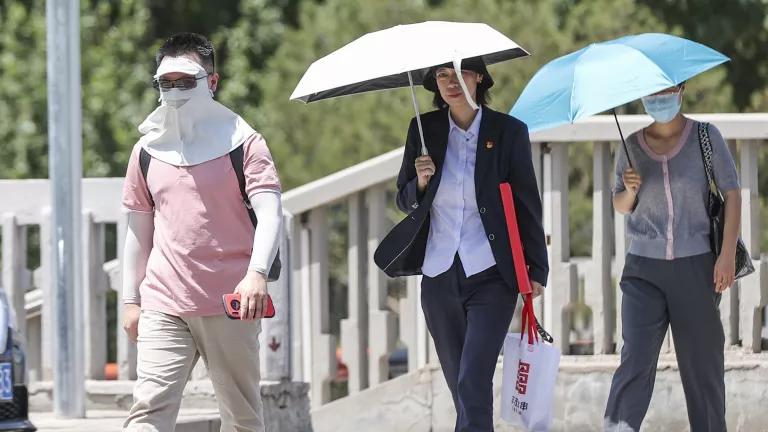
Temperatures in Beijing rose above 104 degrees Fahrenheit on July 6, 2023.
Jia Tianyong/China News Service/VCG via Getty Images

- Share this page block
What is global warming?
What causes global warming, how is global warming linked to extreme weather, what are the other effects of global warming, where does the united states stand in terms of global-warming contributors, is the united states doing anything to prevent global warming, is global warming too big a problem for me to help tackle.
A: Since the Industrial Revolution, the global annual temperature has increased in total by a little more than 1 degree Celsius, or about 2 degrees Fahrenheit. Between 1880—the year that accurate recordkeeping began—and 1980, it rose on average by 0.07 degrees Celsius (0.13 degrees Fahrenheit) every 10 years. Since 1981, however, the rate of increase has more than doubled: For the last 40 years, we’ve seen the global annual temperature rise by 0.18 degrees Celsius, or 0.32 degrees Fahrenheit, per decade.
The result? A planet that has never been hotter . Nine of the 10 warmest years since 1880 have occurred since 2005—and the 5 warmest years on record have all occurred since 2015. Climate change deniers have argued that there has been a “pause” or a “slowdown” in rising global temperatures, but numerous studies, including a 2018 paper published in the journal Environmental Research Letters , have disproved this claim. The impacts of global warming are already harming people around the world.
Now climate scientists have concluded that we must limit global warming to 1.5 degrees Celsius by 2040 if we are to avoid a future in which everyday life around the world is marked by its worst, most devastating effects: the extreme droughts, wildfires, floods, tropical storms, and other disasters that we refer to collectively as climate change . These effects are felt by all people in one way or another but are experienced most acutely by the underprivileged, the economically marginalized, and people of color, for whom climate change is often a key driver of poverty, displacement, hunger, and social unrest.
A: Global warming occurs when carbon dioxide (CO 2 ) and other air pollutants collect in the atmosphere and absorb sunlight and solar radiation that have bounced off the earth’s surface. Normally this radiation would escape into space, but these pollutants, which can last for years to centuries in the atmosphere, trap the heat and cause the planet to get hotter. These heat-trapping pollutants—specifically carbon dioxide, methane, nitrous oxide, water vapor, and synthetic fluorinated gases—are known as greenhouse gases, and their impact is called the greenhouse effect.
Though natural cycles and fluctuations have caused the earth’s climate to change several times over the last 800,000 years, our current era of global warming is directly attributable to human activity—specifically to our burning of fossil fuels such as coal, oil, gasoline, and natural gas, which results in the greenhouse effect. In the United States, the largest source of greenhouse gases is transportation (29 percent), followed closely by electricity production (28 percent) and industrial activity (22 percent). Learn about the natural and human causes of climate change .
Curbing dangerous climate change requires very deep cuts in emissions, as well as the use of alternatives to fossil fuels worldwide. The good news is that countries around the globe have formally committed—as part of the 2015 Paris Climate Agreement —to lower their emissions by setting new standards and crafting new policies to meet or even exceed those standards. The not-so-good news is that we’re not working fast enough. To avoid the worst impacts of climate change, scientists tell us that we need to reduce global carbon emissions by as much as 40 percent by 2030. For that to happen, the global community must take immediate, concrete steps: to decarbonize electricity generation by equitably transitioning from fossil fuel–based production to renewable energy sources like wind and solar; to electrify our cars and trucks; and to maximize energy efficiency in our buildings, appliances, and industries.
A: Scientists agree that the earth’s rising temperatures are fueling longer and hotter heat waves , more frequent droughts , heavier rainfall , and more powerful hurricanes .
In 2015, for example, scientists concluded that a lengthy drought in California—the state’s worst water shortage in 1,200 years —had been intensified by 15 to 20 percent by global warming. They also said the odds of similar droughts happening in the future had roughly doubled over the past century. And in 2016, the National Academies of Science, Engineering, and Medicine announced that we can now confidently attribute some extreme weather events, like heat waves, droughts, and heavy precipitation, directly to climate change.
The earth’s ocean temperatures are getting warmer, too—which means that tropical storms can pick up more energy. In other words, global warming has the ability to turn a category 3 storm into a more dangerous category 4 storm. In fact, scientists have found that the frequency of North Atlantic hurricanes has increased since the early 1980s, as has the number of storms that reach categories 4 and 5. The 2020 Atlantic hurricane season included a record-breaking 30 tropical storms, 6 major hurricanes, and 13 hurricanes altogether. With increased intensity come increased damage and death. The United States saw an unprecedented 22 weather and climate disasters that caused at least a billion dollars’ worth of damage in 2020, but, according to NOAA, 2017 was the costliest on record and among the deadliest as well: Taken together, that year's tropical storms (including Hurricanes Harvey, Irma, and Maria) caused nearly $300 billion in damage and led to more than 3,300 fatalities.
The impacts of global warming are being felt everywhere. Extreme heat waves have caused tens of thousands of deaths around the world in recent years. And in an alarming sign of events to come, Antarctica has lost nearly four trillion metric tons of ice since the 1990s. The rate of loss could speed up if we keep burning fossil fuels at our current pace, some experts say, causing sea levels to rise several meters in the next 50 to 150 years and wreaking havoc on coastal communities worldwide.
A: Each year scientists learn more about the consequences of global warming , and each year we also gain new evidence of its devastating impact on people and the planet. As the heat waves, droughts, and floods associated with climate change become more frequent and more intense, communities suffer and death tolls rise. If we’re unable to reduce our emissions, scientists believe that climate change could lead to the deaths of more than 250,000 people around the globe every year and force 100 million people into poverty by 2030.
Global warming is already taking a toll on the United States. And if we aren’t able to get a handle on our emissions, here’s just a smattering of what we can look forward to:
- Disappearing glaciers, early snowmelt, and severe droughts will cause more dramatic water shortages and continue to increase the risk of wildfires in the American West.
- Rising sea levels will lead to even more coastal flooding on the Eastern Seaboard, especially in Florida, and in other areas such as the Gulf of Mexico.
- Forests, farms, and cities will face troublesome new pests , heat waves, heavy downpours, and increased flooding . All of these can damage or destroy agriculture and fisheries.
- Disruption of habitats such as coral reefs and alpine meadows could drive many plant and animal species to extinction.
- Allergies, asthma, and infectious disease outbreaks will become more common due to increased growth of pollen-producing ragweed , higher levels of air pollution , and the spread of conditions favorable to pathogens and mosquitoes.
Though everyone is affected by climate change, not everyone is affected equally. Indigenous people, people of color, and the economically marginalized are typically hit the hardest. Inequities built into our housing , health care , and labor systems make these communities more vulnerable to the worst impacts of climate change—even though these same communities have done the least to contribute to it.
A: In recent years, China has taken the lead in global-warming pollution , producing about 26 percent of all CO2 emissions. The United States comes in second. Despite making up just 4 percent of the world’s population, our nation produces a sobering 13 percent of all global CO2 emissions—nearly as much as the European Union and India (third and fourth place) combined. And America is still number one, by far, in cumulative emissions over the past 150 years. As a top contributor to global warming, the United States has an obligation to help propel the world to a cleaner, safer, and more equitable future. Our responsibility matters to other countries, and it should matter to us, too.
A: We’ve started. But in order to avoid the worsening effects of climate change, we need to do a lot more—together with other countries—to reduce our dependence on fossil fuels and transition to clean energy sources.
Under the administration of President Donald Trump (a man who falsely referred to global warming as a “hoax”), the United States withdrew from the Paris Climate Agreement, rolled back or eliminated dozens of clean air protections, and opened up federally managed lands, including culturally sacred national monuments, to fossil fuel development. Although President Biden has pledged to get the country back on track, years of inaction during and before the Trump administration—and our increased understanding of global warming’s serious impacts—mean we must accelerate our efforts to reduce greenhouse gas emissions.
Despite the lack of cooperation from the Trump administration, local and state governments made great strides during this period through efforts like the American Cities Climate Challenge and ongoing collaborations like the Regional Greenhouse Gas Initiative . Meanwhile, industry and business leaders have been working with the public sector, creating and adopting new clean-energy technologies and increasing energy efficiency in buildings, appliances, and industrial processes.
Today the American automotive industry is finding new ways to produce cars and trucks that are more fuel efficient and is committing itself to putting more and more zero-emission electric vehicles on the road. Developers, cities, and community advocates are coming together to make sure that new affordable housing is built with efficiency in mind , reducing energy consumption and lowering electric and heating bills for residents. And renewable energy continues to surge as the costs associated with its production and distribution keep falling. In 2020 renewable energy sources such as wind and solar provided more electricity than coal for the very first time in U.S. history.
President Biden has made action on global warming a high priority. On his first day in office, he recommitted the United States to the Paris Climate Agreement, sending the world community a strong signal that we were determined to join other nations in cutting our carbon pollution to support the shared goal of preventing the average global temperature from rising more than 1.5 degrees Celsius above preindustrial levels. (Scientists say we must stay below a 2-degree increase to avoid catastrophic climate impacts.) And significantly, the president has assembled a climate team of experts and advocates who have been tasked with pursuing action both abroad and at home while furthering the cause of environmental justice and investing in nature-based solutions.
A: No! While we can’t win the fight without large-scale government action at the national level , we also can’t do it without the help of individuals who are willing to use their voices, hold government and industry leaders to account, and make changes in their daily habits.
Wondering how you can be a part of the fight against global warming? Reduce your own carbon footprint by taking a few easy steps: Make conserving energy a part of your daily routine and your decisions as a consumer. When you shop for new appliances like refrigerators, washers, and dryers, look for products with the government’s ENERGY STAR ® label; they meet a higher standard for energy efficiency than the minimum federal requirements. When you buy a car, look for one with the highest gas mileage and lowest emissions. You can also reduce your emissions by taking public transportation or carpooling when possible.
And while new federal and state standards are a step in the right direction, much more needs to be done. Voice your support of climate-friendly and climate change preparedness policies, and tell your representatives that equitably transitioning from dirty fossil fuels to clean power should be a top priority—because it’s vital to building healthy, more secure communities.
You don’t have to go it alone, either. Movements across the country are showing how climate action can build community , be led by those on the front lines of its impacts, and create a future that’s equitable and just for all .
This story was originally published on March 11, 2016 and has been updated with new information and links.
This NRDC.org story is available for online republication by news media outlets or nonprofits under these conditions: The writer(s) must be credited with a byline; you must note prominently that the story was originally published by NRDC.org and link to the original; the story cannot be edited (beyond simple things such as grammar); you can’t resell the story in any form or grant republishing rights to other outlets; you can’t republish our material wholesale or automatically—you need to select stories individually; you can’t republish the photos or graphics on our site without specific permission; you should drop us a note to let us know when you’ve used one of our stories.
Related Stories
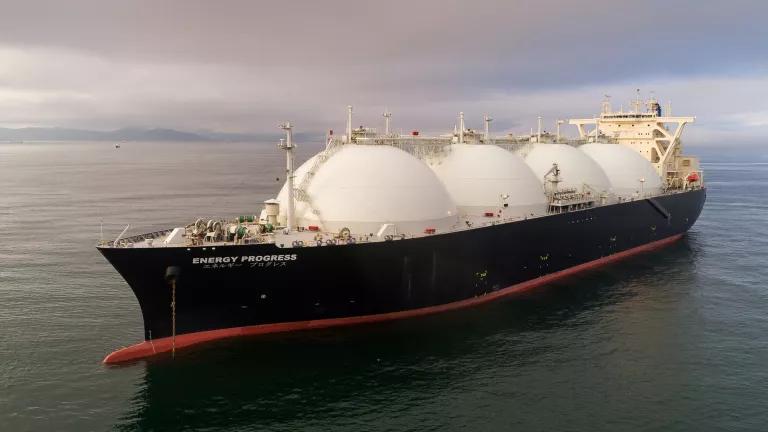
Liquefied Natural Gas 101
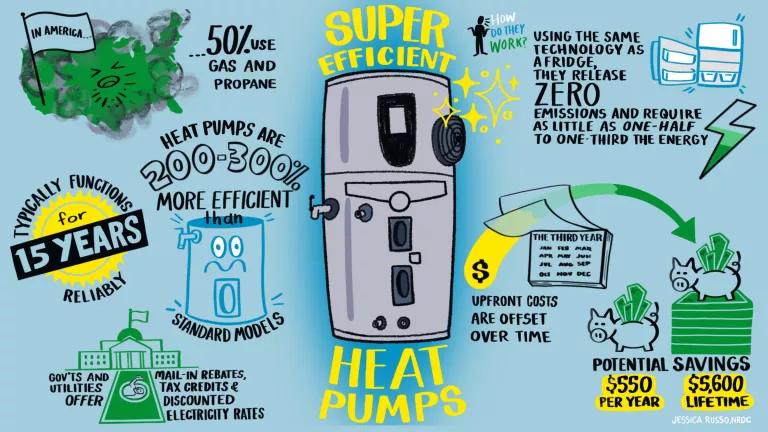
What’s the Most Energy-Efficient Water Heater?

What Do “Better” Batteries Look Like?
When you sign up, you’ll become a member of NRDC’s Activist Network. We will keep you informed with the latest alerts and progress reports.

Global Warming
About global warming, narrow the topic.
- Articles & Videos
- MLA Citation This link opens in a new window
- APA Citation This link opens in a new window

- Is the world actually getting warmer?
- What is the difference between greenhouse effect and global warming?
- What are the greenhouse gases and why are they important to us?
- Should we be concerned about global warming?
- Is the greenhouse effect a serious threat?
- Why is glacial melt a concern?
- Is ozone depletion a genuine threat?
- Discuss the effect of global warming on a particular region such as Alaska?
- Should the United States sign the United Nations' Kyoto Protocol?
- Should the Environmental Protection Agency have the authority to regulate carbon dioxide and other greenhouse gases from motor vehicles and power plants?
- Next: Library Resources >>
- Last Updated: Feb 13, 2024 3:11 PM
- URL: https://libguides.broward.edu/Global_Warming
- Climate Change - A Global Issue
- Dag Hammarskjöld Library
- Research Guides
Major Reports
- A Global Issue
- At the United Nations
- Books & Journals
- Consulting the Experts
- Keeping up to date
- Data & Statistics
- AR6 - 6th IPCC Assessment Report / Intergovernmental Panel on Climate Change The main activity of the IPCC is to, at regular intervals, provide Assessment Reports of the state of knowledge on climate change. The IPCC is now in its sixth assessment cycle, in which it is producing the Sixth Assessment Report (AR6) with contributions by its three Working Groups and a Synthesis Report, three Special Reports, and a refinement to its latest Methodology Report.

- Global Landscape of Climate Finance 2023 / Climate Policy Initiative Date: 2023 Provides information about which sources and financial instruments are driving investments, and how much climate finance is flowing globally. The report aims to provide an updated picture on how, where, and from whom finance is flowing toward low-carbon and climate-resilient actions globally, and to improve understanding of how public and private sources of finance interact.
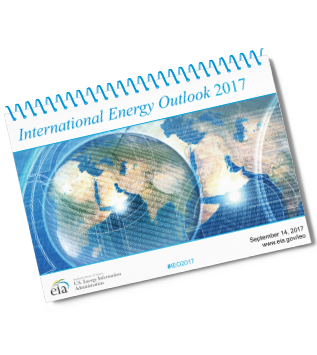
This site contains links and references to third-party databases, web sites, books and articles. It does not imply the endorsement of the content by the United Nations.
- << Previous: At the United Nations
- Next: Books & Journals >>
- Last Updated: Jan 5, 2024 5:23 PM
- URL: https://research.un.org/en/climate-change
- Climate modelling
- Extreme weather
- Health and Security
- Temperature
- China energy
- Oil and gas
- Other technologies
- China Policy
- International policy
- Other national policy
- Rest of world policy
- UN climate talks
- Country profiles
- Guest posts
- Infographics
- Media analysis
- State of the climate
- Translations
- Daily Brief
- China Briefing
- Comments Policy
- Cookies Policy
- Global emissions
- Rest of world emissions
- UK emissions
- EU emissions
- Global South Climate Database
- Newsletters
- COP21 Paris
- COP22 Marrakech
- COP24 Katowice
- COP25 Madrid
- COP26 Glasgow
- COP27 Sharm el-Sheikh
- COP28 Dubai
- Privacy Policy
- Attribution
- Geoengineering
- Food and farming
- Plants and forests
- Marine life
- Ocean acidification
- Ocean warming
- Sea level rise
- Human security
- Public health
- Public opinion
- Risk and adaptation
- Science communication
- Carbon budgets
- Climate sensitivity
- GHGs and aerosols
- Global temperature
- Negative emissions
- Rest of world temperature
- Tipping points
- UK temperature
- Thank you for subscribing
Social Channels
Search archive.

Receive a Daily or Weekly summary of the most important articles direct to your inbox, just enter your email below. By entering your email address you agree for your data to be handled in accordance with our Privacy Policy .

Roz Pidcock
Which of the many thousands of papers on climate change published each year in scientific journals are the most successful? Which ones have done the most to advance scientists’ understanding, alter the course of climate change research, or inspire future generations?
On Wednesday, Carbon Brief will reveal the results of our analysis into which scientific papers on the topic of climate change are the most “cited”. That means, how many times other scientists have mentioned them in their own published research. It’s a pretty good measure of how much impact a paper has had in the science world.
But there are other ways to measure influence. Before we reveal the figures on the most-cited research, Carbon Brief has asked climate experts what they think are the most influential papers.
We asked all the coordinating lead authors, lead authors and review editors on the last Intergovernmental Panel on Climate Change (IPCC) report to nominate three papers from any time in history. This is the exact question we posed:
What do you consider to be the three most influential papers in the field of climate change?
As you might expect from a broad mix of physical scientists, economists, social scientists and policy experts, the nominations spanned a range of topics and historical periods, capturing some of the great climate pioneers and the very latest climate economics research.
Here’s a link to our summary of who said what . But one paper clearly takes the top spot.
Winner: Manabe & Wetherald ( 1967 )
With eight nominations, a seminal paper by Syukuro Manabe and Richard. T. Wetherald published in the Journal of the Atmospheric Sciences in 1967 tops the Carbon Brief poll as the IPCC scientists’ top choice for the most influential climate change paper of all time.
Entitled, “Thermal Equilibrium of the Atmosphere with a Given Distribution of Relative Humidity”, the work was the first to represent the fundamental elements of the Earth’s climate in a computer model, and to explore what doubling carbon dioxide (CO2) would do to global temperature.
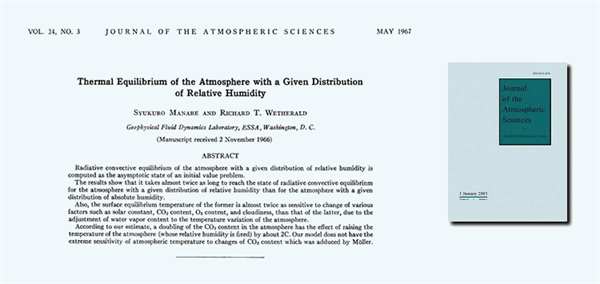
Manabe & Wetherald (1967), Journal of the Atmospheric Sciences
The Manabe & Wetherald paper is considered by many as a pioneering effort in the field of climate modelling, one that effectively opened the door to projecting future climate change. And the value of climate sensitivity is something climate scientists are still grappling with today .
Prof Piers Forster , a physical climate scientist at Leeds University and lead author of the chapter on clouds and aerosols in working group one of the last IPCC report, tells Carbon Brief:
This was really the first physically sound climate model allowing accurate predictions of climate change.
The paper’s findings have stood the test of time amazingly well, Forster says.
Its results are still valid today. Often when I’ve think I’ve done a new bit of work, I found that it had already been included in this paper.
Prof Steve Sherwood , expert in atmospheric climate dynamics at the University of New South Wales and another lead author on the clouds and aerosols chapter, says it’s a tough choice, but Manabe & Wetherald (1967) gets his vote, too. Sherwood tells Carbon Brief:
[The paper was] the first proper computation of global warming and stratospheric cooling from enhanced greenhouse gas concentrations, including atmospheric emission and water-vapour feedback.
Prof Danny Harvey , professor of climate modelling at the University of Toronto and lead author on the buildings chapter in the IPCC’s working group three report on mitigation, emphasises the Manabe & Wetherald paper’s impact on future generations of scientists. He says:
[The paper was] the first to assess the magnitude of the water vapour feedback, and was frequently cited for a good 20 years after it was published.
Tomorrow, Carbon Brief will be publishing an interview with Syukuro Manabe, alongside a special summary by Prof John Mitchell , the Met Office Hadley Centre’s chief scientist from 2002 to 2008 and director of climate science from 2008 to 2010, on why the paper still holds such significance today.
Joint second: Keeling, C.D et al. ( 1976 )
Jumping forward a decade, a classic paper by Charles Keeling and colleagues in 1976 came in joint second place in the Carbon Brief survey.
Published in the journal Tellus under the title, “Atmospheric carbon dioxide variations at Mauna Loa observatory,” the paper documented for the first time the stark rise of carbon dioxide in the atmosphere at the Mauna Loa observatory in Hawaii.
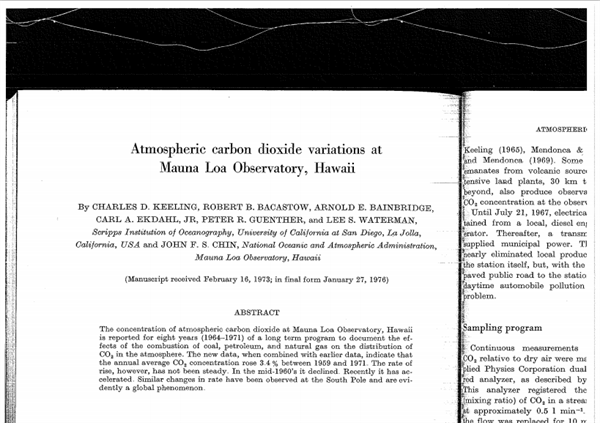
A photocopy of Keeling et al., (1976) Source: University of California, Santa Cruz
Dr Jorge Carrasco , Antarctic climate change researcher at the University of Magallanes in Chile and lead author on the cryosphere chapter in the last IPCC report, tells Carbon Brief why the research underpinning the “Keeling Curve’ was so important.
This paper revealed for the first time the observing increased of the atmospheric CO2 as the result of the combustion of carbon, petroleum and natural gas.
Prof David Stern , energy and environmental economist at the Australian National University and lead author on the Drivers, Trends and Mitigation chapter of the IPCC’s working group three report, also chooses the 1976 Keeling paper, though he notes:
This is a really tough question as there are so many dimensions to the climate problem – natural science, social science, policy etc.
With the Mauna Loa measurements continuing today , the so-called “Keeling curve” is the longest continuous record of carbon dioxide concentration in the world. Its historical significance and striking simplicity has made it one of the most iconic visualisations of climate change.
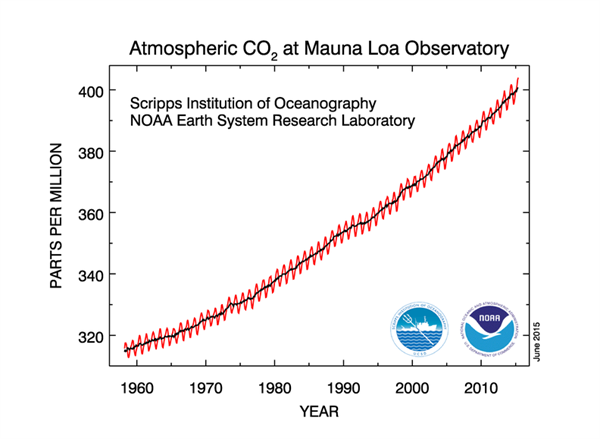
Source: US National Oceanic and Atmospheric Administration (NOAA)
Also in joint second place: Held, I.M. & Soden, B.J. ( 2006 )
Fast forwarding a few decades, in joint second place comes a paper by Isaac Held and Brian Soden published in the journal Science in 2006.
The paper, “Robust Responses of the Hydrological Cycle to Global Warming”, identified how rainfall from one place to another would be affected by climate change. Prof Sherwood, who nominated this paper as well as the winning one from Manabe and Wetherald, tells Carbon Brief why it represented an important step forward. He says:
[This paper] advanced what is known as the “wet-get-wetter, dry-get-drier” paradigm for precipitation in global warming. This mantra has been widely misunderstood and misapplied, but was the first and perhaps still the only systematic conclusion about regional precipitation and global warming based on robust physical understanding of the atmosphere.

Held & Soden (2006), Journal of Climate
Honourable mentions
Rather than choosing a single paper, quite a few academics in our survey nominated one or more of the Working Group contributions to the last IPCC report. A couple even suggested the Fifth Assessment Report in its entirety, running to several thousands of pages. The original IPCC report , published in 1990, also got mentioned.
It was clear from the results that scientists tended to pick papers related to their own field. For example, Prof Ottmar Edenhofer , chief economist at the Potsdam Institute for Climate Impact Research and co-chair of the IPCC’s Working Group Three report on mitigation, selected four papers from the last 20 years on the economics of climate change costs versus risks, recent emissions trends, the technological feasibility of strong emissions reductions and the nature of international climate cooperation.
Taking a historical perspective, a few more of the early pioneers of climate science featured in our results, too. For example, Svante Arrhenius’ famous 1896 paper on the Greenhouse Effect, entitled “On the influence of carbonic acid in the air upon the temperature of the ground”, received a couple of votes.
Prof Jonathan Wiener , environmental policy expert at Duke University in the US and lead author on the International Cooperation chapter in the IPCC’s working group three report, explains why this paper should be remembered as one of the most influential in climate policy. He says:
[This is the] classic paper showing that rising greenhouse gas concentrations lead to increasing global average surface temperature.

Svante Arrhenius (1896), Philosophical Magazine
A few decades later, a paper by Guy Callendar in 1938 linked the increase in carbon dioxide concentration over the previous 50 years to rising temperatures. Entitled, “The artificial production of carbon dioxide and its influence on temperature,” the paper marked an important step forward in climate change research, says Andrew Solow , director of the Woods Hole Marine Policy centre and lead author on the detection and attribution of climate impacts chapter in the IPCC’s working group two report. He says:
There is earlier work on the greenhouse effect, but not (to my knowledge) on the connection between increasing levels of CO2 and temperature.
Though it may feature in the climate change literature hall of fame, this paper raises a question about how to define a paper’s influence, says Forster. Rather than being celebrated among his contemporaries, Callendar’s work achieved recognition a long time after it was published. Forster says:
I would loved to have chosen Callendar (1938) as the first attribution paper that changed the world. Unfortunately, the 1938 effort of Callendar was only really recognised afterwards as being a founding publication of the field … The same comment applies to earlier Arrhenius and Tyndall efforts. They were only influential in hindsight.
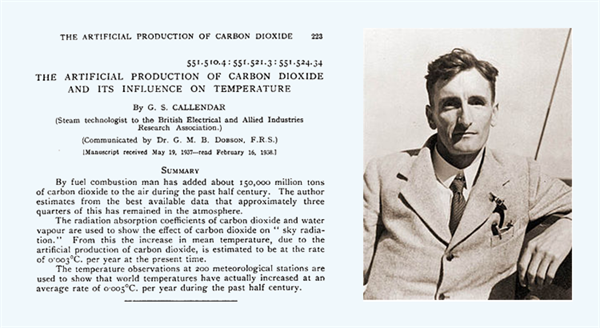
Guy Callendar and his 1938 paper in Quarterly Journal of the Royal Meteorological Society
Other honourable mentions in the Carbon Brief survey of most influential climate papers go to Norman Phillips, whose 1956 paper described the first general circulation model, William Nordhaus’s 1991 paper on the economics of the greenhouse effect, and a paper by Camile Parmesan and Gary Yohe in 2003 , considered by many to provide the first formal attribution of climate change impacts on animal and plant species.
Finally, James Hansen’s 2012 paper , “Public perception of climate change and the new climate dice”, was important in highlighting the real-world impacts of climate change, says Prof Andy Challinor , expert in climate change impacts at the University of Leeds and lead author on the food security chapter in the working group two report. He says:
[It] helped with demonstrating the strong links between extreme events this century and climate change. Result: more clarity and less hedging.
Marc Levi , a political scientist at Columbia University and lead author on the IPCC’s human security chapter, makes a wider point, telling Carbon Brief:
The importance is in showing that climate change is observable in the present.
Indeed, attribution of extreme weather continues to be at the forefront of climate science, pushing scientists’ understanding of the climate system and modern technology to their limits.
Look out for more on the latest in attribution research as Carbon Brief reports on the Our Common Futures Under Climate Change conference taking place in Paris this week.
Pinning down which climate science papers most changed the world is difficult, and we suspect climate scientists could argue about this all day. But while the question elicits a range of very personal preferences, stories and characters, one paper has clearly stood the test of time and emerged as the popular choice among today’s climate experts – Manabe and Wetherald, 1967.
Main image: Satellite image of Hurricane Katrina.
- What are the most influential climate change papers of all time?
Expert analysis direct to your inbox.
Get a round-up of all the important articles and papers selected by Carbon Brief by email. Find out more about our newsletters here .
183 Global Warming Essay Topics
NASA named July 2023 as the hottest month ever since 1880. This news cannot be ignored, and we suggest delving into this urgent issue that is reshaping our planet. In this compilation of global warming essay topics, you will find title ideas about how human activities impact the environment, what collective actions are required to battle it, and others.
🌡️ TOP 7 Global Warming Topics
🏆 best global warming essay topics, 🎓 interesting global warming essay titles, 👍 debate topics on global warming, 💡 simple global warming essay topics, 🌶️ catchy global warming topics, 📌 easy global warming essay titles, ❓ global warming research questions.
- The Problem of Global Warming and Ways of Its Solution
- Extreme Weather and Global Warming
- Al Gore’s Speech on Global Warming
- Global Warming and Ozone Depletion
- Global Warming is Not a Myth
- Climate Change and Global Warming
- Global Warming: Myth or Reality?
- Global Warming Effects on the Environment and Animals Global warming is a threat to the survival and well-being of human and animal life. This discussion aims to provide the effects of the current global warming threats.
- Global Warming and Business Ethics Business ethics is significant in promoting effective industrial activities that promote environmental conservation and reduce global warming.
- Effects of Global Warming: Essay Example According to environmentalists and other nature conservatives, Africa would be the worst hit continent by the effects of global warming despite emitting less greenhouse gases.
- Fast Fashion and Its Impacts on Global Warming Fast fashion contributes to this change in weather conditions due to its improper disposal, leading to the release of emissions into the atmosphere, thus causing global warming.
- How Global Warming Affects Wildlife Global warming is a matter of great concern since it affects humans and wildlife directly, and this issue should be addressed appropriately.
- Car Emissions and Global Warming The emissions problem that is caused by the excessive use of cars is an issue that affects most of the modern world and needs to be addressed as soon as possible to prevent further adverse impact.
- Global Warming With an Emphasis on the Arctic This paper presents the impact of global warming with a focus on the Arctic region. It also provides key solutions that can be implemented to reduce its effects.
- The Effect of Global Warming and the Future Global warming effects are the social and environmental changes brought-about by the increase in global temperatures.
- The Effect of Global Warming Global warming effects are the social and environmental changes brought about by the increase in global temperatures.
- Journal and Newspaper Collection on Global Warming This paper comments on Journal/ newspaper article on global warming from major newspapers and journals around the world
- The Issue of Unstoppable Global Warming and Its Effects Drought levels shall increase if the temperatures remain high, evaporation shall increase too, mostly at summer and fall, could worsen famine, and the danger of wildfires.
- Climate Change and Global Warming Awareness If people continue to have misconceptions about global warming, climate change will negatively impact weather, food security, and biodiversity.
- Climate Change: The Leading Cause of Global Warming The chosen issue is climate change because it is a social dilemma triggered by human activity and will need joint efforts to reduce or alleviate its adverse effects.
- It’s Not My Fault: Global Warming and Moral Responsibility The work of the American professor of ethical sciences Sinnott-Armstrong approaches the phenomenon of global warming in terms of individual and collective responsibility.
- Global Warming and Other Ecology Issues The results of global warming will always remain a topic of controversy. Most scientists will always agree and disagree on the real effects of global warming on human life.
- Global Warming Causes and Impacts This paper endeavors to delineate the history of global warming, the causality and every potential revelation towards diminution of the impacts of global warming.
- The History of Climate Change and Global Warming Issue The paper states that the history of climate change and the solutions communities opted for are critical to tackling the current global warming issue.
- Worldwide Effects of Global Warming The article conveys Trenberth’s message about the far-reaching implications of global warming on climate and the urgent need for collective action to address its consequences.
- Global Warming and Climate Change and Their Impact on Humans Climate change and global warming are significant issues with negative impacts on all aspects of human life; for example, they disrupt the food web, hurting humans and wildlife.
- Devastating Effects of Global Warming The incapacitating consequences of a changing climate have resulted in significant distress among vulnerable populations as they face various challenges.
- Endogenous Substitution Among Energy Resources and Global Warming
- Global Warming and Developing Countries: The Possibility of a Solution by Accelerating Development
- Can Nuclear Power Solve the Global Warming Problem
- The Kyoto Protocol and the Causes and Effects of Global Warming
- Anthropogenic Global Warming Hypothesis: Testing Its Robustness by Granger Causality Analysis
- Using Hydropower Help Stop Global Warming
- Global Warming and Risk of Resources War
- Environmental Issues That Impact the Tourism Industry: Global Warming Causes
- Global Warming Atmosphere Heat Gases
- The Paris Agreement: Solutions to the Issue of Global Warming
- Each Citizen Should Aim to Reduce Their Carbon Footprint to Halt Global Warming
- Atmospheric Pollution the Atmospheric Issues and Global Warming
- Combating Global Warming and Other Problems Associated With Fossil Fuels
- Global Warming and Its Effect on Human Society
- Global Warming and Its Threat to the Future of Wildlife and Its Habitat
- Anthropogenic Global Warming: Man’s Influence in the Environment Critical Thinking
- Global Warming and Planetary Dangers
- Global Warming and Endogenous Technological Change: Revisiting the Green Paradox
- The Global Warming Potential Paradox: Implications for the Design of Climate Policy
- Does Increased Carbon Dioxide Emissions Cause Global Warming
- Global Warming: Cause and Mitigation
- America Should Take the Lead in Stopping Global Warming
- Deforestation: Global Warming and Percent Grass
- Are Global Warming and Economic Growth Compatible? Evidence From Five OPEC Countries
- Did Global Warming and Climate Change Cause the Degradation of Lake Chad, Africa’s Most Important ‘Ecological Catastrophe’
- Global Warming and Crop Production in Africa Many people are aware of the current and future negative effects of global warming. Global warming will cause severe reductions in the crop in Africa, particularly in Ethiopia.
- Consequences of Global Warming Although the opinions about the causes of climate change are diverse, the effects of human activities and natural elements are similar and lead to global warming.
- Global Warming: “Hopeful Lessons From the Battle to Save Rainforests” The “Hopeful lessons from the battle to save rainforests” video proposes several solutions to deforestation and global warming.
- Devastating Effects of Global Warming Global warming presents a considerable threat by having an enormous influence on humanity’s social, economic, and physical state.
- Global Warming and Economics Discussion The article discusses that at the international level, the carbon tax is not always conducive to climate change regulation.
- Global Warming: The Importance of Addressing the Climate Crisis The paper states that global warming has many consequences. Multiple scientific discoveries emphasize the importance of addressing the climate crisis urgently.
- Examining the Potential of Digital Earth Services in Connection to Global Warming In this work, the primary characteristics of global warming will be discussed with the implementation of digital Earth tools, examining the data from these sources.
- Greenhouse Effect as a Cause of Global Warming The report serves an informative function and is designed to explore the nature of global warming through the greenhouse effect.
- Global Warming in Relation to Human Population Size The density of the world population in the future is a crucial component of climate policy to safeguard the vulnerable future generation.
- Iron Fertilization: Solving Global Warming The discussion in this paper considers some of the international as well as maritime laws that deal with the application of iron fertilization as a method of mitigating global warming.
- How Car Emissions Affect Global Warming This paper examines the concept of global warming with a focal point on the emissions of gases by cars and other automobiles.
- Carbon Emission Effects and Global Warming Laws In this essay, we are going to look at recent laws and policies that can deal with the effects of carbon emission and global warming in general.
- Economic Model for Global Warming The adoption of various economic models is a superior strategy that appears promising and capable of guiding policymakers and nations to tackle the predicament of climate change.
- Global Warming From a Social Studies Perspective The inability to find a balance between human needs and the consequences of their realization for the environment leads to conflict resulting in global warming.
- Climate and Social Change in Global Warming Crisis People in the community should be encouraged to change their behaviors and make better personal choices to mitigate the global warming crisis.
- Global Warming and Climate Change Climate change is caused by greenhouse gas emissions resulting from human activities, mainly through the energy and transport sectors.
- Global Warming, Climate Change and Ozone Depletion Global warming refers to an increase in the Earth’s average temperature that is characterized by rising global surface temperatures and the accumulation of pollutants in the atmosphere.
- Climate Change Skepticism in Relation to Global Warming The researcher has used the most appropriate research design that enables her to take a closer look at climate change skepticism.
- The Issue of Global Warming in the Community To effectively mitigate the effects of global warming in the community, the team will be made up of three experts in different disciplines closely related to the environment.
- Global Warming: Do Human Activities Threaten to Change Climate? The greenhouse gases that cause global warming can only be present in the atmosphere if they are emitted and their emission can only come out of the activities of human beings.
- Global Warming and Mitigation Strategies The paper outlines causes of global warming and possible impact on human beings. There is also an evaluation of strategies applied in realization of environmental sustainability.
- Global Warming: Is It Caused by Nature or Mankind? The greenhouse effect is a term that describes an increase of the average global temperature and is often associated with global.
- Controversy About Global Warming: Skepticism and Reality There are two different points of view on global change. Skeptics believe that global warming is a natural process. Another thinks that it is the result of an exclusive human activity.
- Global Warming: Harmful Impact on the Polar Bears The natural existence of Polar bears directly depends on the global warming process due to numerous reasons. Global warming fosters the spread of poisoned substances.
- Global Warming: Issue Analysis Global warming is a term commonly used to describe the consequences of man- made pollutants overloading the naturally-occurring greenhouse gases causing an increase of the average global temperature.
- Oil and Gas Industry Response to Global Warming Global warming is a contemporary serious threat to our planet for the combustion of oil, coal, and natural gas contributes in changing the atmospheric balance of carbon dioxide.
- Global Warming: Causes and Solutions Climate change has started to develop since the 20th century and is still in a progressive state of continuation. The true causes of the greenhouse effect are still open to discussion.
- Global Warming and the Effect on Plant Diversity
- Global Warming and Its Effects on Coastal Cities
- Weakening Dust Storm Intensity in Arid Central Asia Due to Global Warming Over the Past 160 Years
- Can Earth End Because of Global Warming?
- Global Warming and Its Effect on the Marine Ecosystem
- The Greenhouse Effect and Its Relationship to Global Warming
- Global Warming and the Need for Energy-Efficient Lighting
- Global Agricultural Trade Pattern in a Warming World: Regional Realities
- Global Warming and Its Effect on Earth’s Surface, Oceans
- Accounting for Global Warming Risks: Resource Management Under Event Uncertainty
- Global Warming and Its Effect on Natural Disasters
- The Global Warming Phenomenon: Is It Real or Not
- Global Warming and Its Effect on the Quality of Life on Earth
- Global Warming and Its Effects on the Human Body
- Global Warming and Electricity Demand: A Study of California
- Global Warming and Climate Change: Melting the Marine Life
- The Multiple Climate Change Indicators of Global Warming
- Adaptation Behaviors Across Ecosystems Under Global Warming: A Spatial Micro-Econometric Model of the Rural Economy in South America
- Global Warming and Extreme Events: Rethinking the Timing and Intensity of Environmental Policy
- Global Warming and the Changes of Temperature on Earth
- Counteracting Global Warming With Artificial Leaves
- Global Warming and Ice Age
- What Role Can Nuclear Power Play in Mitigating Global Warming
- Global Warming and Climate Change: Impacts on Hurricanes and Cyclones Worldwide
- The Long Term Effects of Global Warming and Climate Change
- The Kyoto Protocol: First Framework for Fighting Global Warming The UN Conference, held in Kyoto, in 1997 focussed on creating an international agreement to fight global warming, by reducing greenhouse gases in developed countries.
- Global Warming: Causes, Factors and Effects The main factors that have been attributed to the resulting global warming are the green house gas effects, differences in the solar and also volcanoes.
- Global Warming as Not a New-Fangled Issue Analytical research and an explanatory research have been seen to be helpful in many ways in order to increase the awareness that an audience has about the issues as global warming.
- The Global Warming Crisis and Ways of its Solution The question of global warming has been a subject of discussion in a number of publications that attempt to describe what is happening and to suggest ways that we might help make a change
- Global Warming: Causes and Consequences Global warming is the result of high levels of greenhouse gases (carbon dioxide, water vapor, methane, and ozone) in the earth’s atmosphere.
- Issue of the Global Warming Global warming is an issue of growing concern, with the consequences of climatic change being felt in different parts of the world.
- Global Warming: Solving a Social Problem Global warming may be a cause of the cooling in some parts of the world. Global warming can slow down ocean heat transport which becomes the reason for cooling in some regions.
- Global Warming and Its Various Consequences The slowly overheating planet may carry a wide variety of repercussions for humanity as one of the species living on its surface.
- Global Warming Leads Climate Change This paper aims to research scholarly literature in order to prove that the human race is largely responsible for global warming and climate change rather than considering it to be a natural course of existence.
- The Paris Accord: Macroeconomics and Global Warming The 21st century has been characterized by the unstoppable emergence of industries due to diverse demands of the ever-increasing world population.
- Virtue Ethics: Altering Testimony on Global Warming The paper discusses an important issue of censorship in regards to the Center for Disease Control and Prevention testimony on global warming.
- Global Warming and Its Health Implications This paper reports on the possible effects of global warming on health, complexities associated with it and the significant general implication of the same around the globe.
- Global Warming and Its Threats: Debates As human civilization continues to expand it brings with it an ever-increasing demand for resources such as food, raw materials, and space.
- Global Warming Challenges Solving in General Electric Environmental solutions that favor the growth of the company rather than social responsibility drive the decisions and policies of the company.
- The Issue of Global Warming Investigating the issue of global warming keenly would increase the understanding on whether it is a naturally occurring phenomenon or one that has been caused by human activities.
- Global Warming Problems due to Economic Growth This paper investigates if it is possible to deal with global warming by reducing CO2 emissions and energy consumption without any threats to economic development.
- Global Warming and the Free Rider Problem This paper will examine the issue of global warming from an economic standpoint, as well as cover the free rider problem and how it affects the fight against global warming.
- Iron Seeding Oceans: Global Warming Solution The principle behind iron seeding is the reduction of carbon dioxide through photosynthesis. One of the major raw materials needed in photosynthesis is carbon dioxide.
- Biodiversity, Global Warming, Environmental Conservation Several pertinent issues manifest themselves in the discussion of nature. These issues include biodiversity, global warming, and environmental conservation.
- The Problem of Global Warming and Its Effects Global warming is a problem that concerns everyone, and it is necessary to take action personally in order to prevent the development of the problem.
- Global Warming as a Humanity’s Fault World leaders were forced to hold discussions in Kigali, Rwanda, in late 2016 to establish a deal addressing mechanisms to be adopted to curb global warming.
- The Concept of Global Warming and Its Impacts The notion of global warming implies a complex environmental procedure, which evolves as a natural consequence of the harmful greenhouse gas emissions.
- The Seriousness of Global Warming One of the most troubling ecological issues of the contemporary world is global warming. It is defined as an increase of global average surface temperature at an alarming rate.
- Global Warming: Car Emissions Effects The paper will answer the question on how the car emissions affect the global warming. It has been noted that in the UK, cause various health problems to the people.
- Car Emission Effects on Global Warming Car emissions are expected to aid policy makers in national governments, automobile manufacturers, fuel industry CEOs and city planners.
- Environmental Studies of Global Warming: Cause and Mitigation Natural climate changes occur in cycles in world, and they are caused by natural interaction with different forces, whereas human activities cause anthropogenic climate changes.
- Environmental Studies: The Global Warming Holocaust Global climate change is a social issue that has captured the imagination of the world’s population. This issue is discussed in mass media and social media platforms.
- Concept of Global Warming Human pollution is changing the climate of our earth and has increased global warming in the past half century.
- Causes and Effects of Global Warming on the Environment The Global Warming is a process which points out an increase of approximate temperature in different spots of Earth. Causes and effects of global warming bear in present days an equivocal character.
- Climate Change and the Future of Research on Global Warming According to Feygina, Jost, and Goldsmith
- Global Warming Affects Polar Bears
- Global Warming and How It Will Affect Soil Carbon
- Will Global Warming Lead to Mass Extinction of the World’s Species
- Global Warming and Changes in Marine Ecosystems: Economic Consequences and Adjustment Issues
- Global Warming and Decreased Crop Production
- Global Warming and Its Effect on Our Environment
- Eliciting Public Preference for Nuclear Energy Against the Backdrop of Global Warming
- Could Slowing the Effects of Global Warming Save Our World
- Waste Prevention and Its Effects on Global Warming
- Global Warming and Its Effect on Ecosystems by Stimulating
- Global Warming: Polar Bears Are Endangered
- Global Warming and Its Effects on Water Storage Systems
- Global Warming and Its Effect on Earth’s Atmosphere
- Counterarguing Coleman’s Allegations That Global Warming Is a Scam
- Acid Rain, Global Warming, and Air Quality
- The Three Reasons Why Public Transportation Won’t Solve the Global Warming Problem
- U.S. Climate Report Says Global Warming Impact Already Severe by Darryl Fears
- The Past, Present, and Future of Global Warming and Climate Change
- Global Warming: Could Things Get Better Before They Get Worse
- Global Warming and Electricity Demand in the Rapidly Growing City of Delhi: A Semi-parametric Variable Coefficient Approach
- Global Warming Effects: Scientific Consensus on Temperature Changes
- Environment: Global Warming and Current Carbon Dioxide
- Will Biofuels Solve Global Warming?
- Are Global Warming and Economic Growth Compatible?
- Can Subsidizing Alternative Energy Technology Development Lead to Faster Global Warming?
- How Global Warming Is Changing the World?
- What Is the Economics of Hurricanes and Implications of Global Warming?
- How Global Warming Can Trigger Infectious Diseases Development?
- What Are the Economic Fundamentals of Global Warming?
- How Much More Rain Will Global Warming Bring?
- What Are the National Contributions to Observed Global Warming?
- What Are the Biological Consequences of Global Warming?
- What Is the “Damages Function” for Global Warming?
- How Effective Are Public Policies Against Global Warming?
- How Does Global Warming Benefit the Small in Aquatic Ecosystems?
- What Are the Alternative Mechanisms to Control Global Warming?
- What Is the Planetary Emergency of Global Warming and What We Can Do About It?
- What Is the Spatial Economic Impact of Global Warming?
- What Are the Effects of Global Warming and Urbanization in Cities?
- What Are the Public Perceptions of Global Warming Issues?
- Do People “Personally Experience” Global Warming?
- What Are the Robust Responses of the Hydrological Cycle to Global Warming?
- What Is the Status and Prospects of Renewable Energy for Combating Global Warming?
- How Warm Days Increase Belief in Global Warming?
- Can China Contribute More to the Fight Against Global Warming?
- Can Advances in Science and Technology Prevent Global Warming?
- How the Public Engages With Global Warming?
- What We Think About When We Try Not To Think About Global Warming?
Cite this post
- Chicago (N-B)
- Chicago (A-D)
StudyCorgi. (2021, September 9). 183 Global Warming Essay Topics. https://studycorgi.com/ideas/global-warming-essay-topics/
"183 Global Warming Essay Topics." StudyCorgi , 9 Sept. 2021, studycorgi.com/ideas/global-warming-essay-topics/.
StudyCorgi . (2021) '183 Global Warming Essay Topics'. 9 September.
1. StudyCorgi . "183 Global Warming Essay Topics." September 9, 2021. https://studycorgi.com/ideas/global-warming-essay-topics/.
Bibliography
StudyCorgi . "183 Global Warming Essay Topics." September 9, 2021. https://studycorgi.com/ideas/global-warming-essay-topics/.
StudyCorgi . 2021. "183 Global Warming Essay Topics." September 9, 2021. https://studycorgi.com/ideas/global-warming-essay-topics/.
These essay examples and topics on Global Warming were carefully selected by the StudyCorgi editorial team. They meet our highest standards in terms of grammar, punctuation, style, and fact accuracy. Please ensure you properly reference the materials if you’re using them to write your assignment.
This essay topic collection was updated on January 21, 2024 .
197 Global Warming Essay Titles & Examples
A global warming essay is a popular assignment in schools and colleges. Over here, our experts came up with 191 amazing titles that you can use for practice or inspiration.
☀Top 10 Global Warming Essay Topics
📝 global warming essay structure, 🏆 best global warming research topic, 🥇 most interesting titles for global warming, 💡 good essay topics on global warming, 📌 simple & easy global warming essay titles, ❓ global warming essay questions.
- The impact of global warming on physical geography.
- The benefits and limitations of solar power.
- Contribution of deforestation to climate change.
- How successful are international climate agreements?
- Comparing the average carbon footprint across different countries.
- How individuals can fight against global warming.
- Largest contributors to the greenhouse effect.
- What are the causes of global warming?
- Changes in the sea climate over the last 20 years.
- The impact of global warming on weather patterns.
If you study science, journalism, or politics, chances are that you will need to write a global warming essay at some point.
While finding things to write about shouldn’t be an issue, your paper must be structured well to receive an excellent mark. The following step-by-step process will help you to organize ideas and ensure that your essay on global warming flows logically.
1️⃣ Choose the right topic
If your instructor didn’t provide a list of possible topics to write about, you would need to do this yourself.
Ideally, the focus of your paper should be rather narrow, as this will allow you to demonstrate your analytical and critical thinking skills. For example, you could write about global warming causes and effects or comment on national policies that aim to prevent environmental damage.
Make sure that there are plenty of resources on your chosen subject and that it sounds interesting to you. Otherwise, the writing process will be more difficult.
2️⃣ Find sample papers on global warming, climate change, and related problems
There are plenty of example essays available on the Internet, so this shouldn’t take too long. While reading other people’s work, note how they structured key points. Write down any global warming essay titles that seem interesting, and then brainstorm to find an ideal name for your piece.
3️⃣ Create a list of key points based on your thoughts and research
Once you have a title, finding resources online is easy. Be careful to select scholarly resources, such as articles from academic journals, books, and official reports.
The information contained in news articles may be biased, so try to refrain from relying on them. As you read, write out the main ideas related to your subject and any thoughts and responses you have.
4️⃣ Organize your points into a proper global warming essay outline
The introduction should have some background information. Reserve your main arguments for the body of the paper. Each paragraph should begin with one key idea, followed by an explanation and examples. The information in the next paragraph should be connected to or follow logically from the arguments you present. This will help you to create a logical flow.
5️⃣ Write a strong global warming essay thesis
A thesis statement should reflect the focus of the work and be clear and succinct. If you are struggling with this part, ask a friend to read your outline and suggest what the main idea should be.
You can also check essay samples to see how other students structured their thesis. As you write the paper, return to your thesis to see if the content fits in with it. Do not include too much irrelevant information, as this will cost you marks.
6️⃣ Create a neat conclusion
The purpose of a global warming essay conclusion is to tie together all of your points and offer the reader a proper closure. For this reason, you should write a plan for your conclusion after you’ve mapped the rest of the paper.
Repeat your thesis statement at the beginning of the final paragraph and then offer more details by returning to the main arguments. Do not include any new resources of information in the end, as this will make your paper look unfinished!
Following the steps described above will assist you in writing an excellent, well-organized student essay on global warming! Before you begin working on your paper, check our samples – they will help you to make great global warming essay titles!
- Effects of Global Warming on Human Health The increasing global temperatures cause the level of water in the seas to rise due to the melting of sea ice and glaciers.
- Global Warming Advantages: A New Look at the Phenomenon Global warming will become a threat to it, and will save a lot of money that may involve in clearing and keeping the ice blocks off the roads.
- Global Warming and Human Impact: Pros and Cons These points include the movement of gases in the atmosphere as a result of certain human activities, the increase of the temperature because of greenhouse gas emissions, and the rise of the oceans’ level that […]
- Global Warming: Causes, Effects, Solutions When carbon dioxide emissions are released to the air, they remain in the atmosphere for over 100 years, and with time causing the temperature on the earth to increase, which results to global warming.
- Global Warming and Effects Within 50 Years Global warming by few Scientists is often known as “climate change” the reason being is that according to the global warming is not the warming of earth it basically is the misbalance in climate.
- Global Warming as Serious Threat to Humanity One of the most critical aspects of global warming is the inability of populations to predict, manage, and decrease natural disruptions due to their inconsistency and poor cooperation between available resources.
- Global Warming Causes, Effects and Solutions This paper is an in-depth evaluation of the facts surrounding global warming, and it seeks to establish the causes and effects of the phenomenon, and proposes solutions for mitigating the effects of global warming.
- Global Warming and Increase of Global Temperature Global warming refers to the rise in the normal temperature of the earth’s near-surface atmosphere and water bodies ever since the middle of the twentieth century and its predictable continuation.
- Global Warming: Facts and Arguments In fact, the argument is that human activities are not substantial to cause global warming. They believe that changing human economic activities to reduce the impact of global warming is very expensive and is not […]
- Causes and Effects of Global Warming The following discussion comprises of the effects of the global warming as well as the mitigating measures to be put in place.
- ‘The Global Warming Myth’ by David Bellamy The argument against the occurrence of global warming, as highlighted by Bellamy who depicts it to be more of a myth in the general public instead of a reality, is based on the dubious nature […]
- Global Warming in the “Soylent Green” Movie The future of humanity and of the entire universe is determined, most significantly, by the power of man, which can be made use for the growth or the destruction of the world.
- Global Warming and Melting of Polar Ice Sheets The collaboration of the different scientists allowed them to make the claim that due to global warming, there is an average increase in temperatures in recent decades.
- The Great Global Warming Swindle: Different Views on the Issue According to the film, the main aim of the scientific organizations is to get funding for the research of this problem and attract additional attention to global warming, while in reality, the climate is changing […]
- Climate Change – Global Warming For instance, in the last one century, scientists have directly linked the concentration of these gases in the atmosphere with the increase in temperature of the earth.
- The Global Warming Debate: Is It Real? Regardless of the side that has the truth, it is very important to treat the issue of global warming with utmost attention given the potential it has for causing misery on the planet.
- An Analysis of the Global Warming Phenomenon Based on the First Law of Thermodynamics In addition, this energy must be equal in magnitude to that leaving the earth’s atmosphere since the earth is an open system. Therefore, the overall energy in the universe must be equal to the energy […]
- Is Global Warming Good or Bad? In my opinion, global warming causes adverse effects that outweighs the positives and therefore, efforts should be invested to manage it through mitigation in order to lessen greenhouse gases emissions, adapting to its effects and […]
- A World Without Ice: Effects of Global Warming on Polar Regions The impacts of global warming in the Polar Regions are so clear and have severe repercussions that they led to the institution of the International Polar Year. Global warming is leading to a reduction of […]
- The Global Warming Problem and Solution Therefore, it is essential to make radical decisions, first of all, to reduce the use of fossil fuels such as oil, carbon, and natural gas. One of the ways of struggle is to protest in […]
- Global Warming: Speculation and Biased Information For example, people or organizations that deny the extent or existence of global warming may finance the creation and dissemination of incorrect information.
- The Dangers of Global Warming: Environmental and Economic Collapse Global warming is caused by the so-called ‘Greenhouse effect’, when gases in Earth’s atmosphere, such as water vapor or methane, let the Sun’s light enter the planet but keep some of its heat in.
- Aspects of Global Warming Global warming refers to the steadily increasing temperature of the Earth, while climate change is how global warming changes the weather and climate of the planet.
- Global Warming: Moral and Political Challenge That is, if the politicians were to advocate the preservation of the environment, they would encourage businesses completely to adopt alternative methods and careful usage of resources.
- Climate Change: Global Warming Intensity Average temperatures on Earth are rising faster than at any time in the past 2,000 years, and the last five of them have been the hottest in the history of meteorological observations since 1850.
- Global Warming and Climate Change: Annotated Bibliography The author shows the tragedy of the situation with climate change by the example of birds that arrived too early from the South, as the buds begin to bloom, although it is still icy.
- Challenges to Global Warming Control The fourth Conference of the Parties (COP) in Buenos Aires, in Argentina, saw US join over 150 nations in signing the Kyoto Protocol.
- Global Warming Challenges and Potential Solutions Some of the recent encounters exemplifying the presence of global warming include the aspects of climate change which resulted in wildfires in forests such as those witnessed in the Amazon Rainforest alongside other evidence of […]
- Global Warming and Role of International Actors The issue of preserving the environment and resisting global warming seems to be the most relevant for discussion in the context of international politics.
- Effects of Global Warming on Marine Life Global warming has adverse effects on the marine life. It has led to the extinction of some of the animals and living things and has been necessitated by human activities.
- Energy Sector and Effects of Global Warming In an interview that was conducted with some of the experts in this field, one of the respondents stated that “the government has the financial capacity to support the growth and development of renewable energy […]
- Global Warming: Separation of CO2 The process of CO2 absorption has diverse advantages and disadvantages. The proper combination of solvent, packing, and conditions will reduce the costs of absorption of CO2.
- Contributions of Methane to Global Warming This is because the amount of methane produced by ruminant animals is proportional to the ratio of nutrients that are available in the animal feeds.
- Global Warming and Health & Emergency Sectors It is important to stress that ambulance service work in various communities is based on the quality of medical supplies and work of qualified specialists being the members of emergency team.
- Sylvain Fleury: Global Warming Heats up Need for Malaria Vaccine The central thesis of the author, Sylvain Fleury, is that global warming is one of the major, if not the major, causes of this high spread rage of infectious diseases.
- Global Warming: Cause and Mitigation However, most researchers agree that global warming is in fact taking place, based on three main pieces of evidence: the average temperature increase, the sea level increase, and the melting of glaciers.
- Global Warming: Negative Effects to the Environment The effect was the greening of the environment and its transformation into habitable zones for humans The second system has been a consequence of the first, storage.
- Phenomenon of the Global Warming and the Increase in the Temperatures of the Earth’s Global warming is the increase in the temperatures of the earth’s air surface and the subsequent increase in the water levels that is, oceans and sea levels increase.
- Effects on Society From Global Warming In future books on history, the last decades of 20th century are going to be referred to as the time of ‘environmental/politically correct craze’, because during the course of this historical period, the enforces of […]
- GIS Project: Global Warming and Its Causes For the GIS project, it is necessary to study the main aspects and problems of global warming and the way it affects the geographic presentation of the planet.
- False Solution to the Problem and Global Warming: Nice Weather It is a false solution to the problem we face, and here, now, I propose a brand new form of action that may very well revolutionize the manner with which the issues at hand are […]
- Global Warming Problem Overview: Significantly Changing the Climate Patterns The government is not in a position to come up with specific costs that are attached to the extent of environmental pollution neither are the polluters aware about the costs that are attached to the […]
- Al Gore and Global Warming: Hurricane Katrina Was Avoidable The essay seeks to explore the roles played by the 21 irrefutable laws of leadership in the tragedy The terrible and devastating incidences of hurricane Katrina still linger in the minds of Americans and the […]
- Global Warming: Reality or Hoax? The scope of this concern can be evident in the fact that the position on global warming was an issue in the US presidential election, and still an issue of dispute between the leading parties […]
- Global Warming Positive Aspects A sustained increase in the surface temperatures of land will lead to the melting of the Arctic Ice. This will lead to the formation of a new trade route that will cut the cost of […]
- Global Warming: Physical and Economic Impacts In a bid to mitigate possible risks to the ecosystem as well as humankind due to the aftermath of global warming, a majority of the countries have thus far implemented various policies designed in such […]
- Global Change Biology in Terms of Global Warming A risk assessment method showed that the current population could persist for at least 2000 years at hatchling sex ratios of up to 75% male.
- Global Warming and Environmental Refugees Moreover, since environmental refugees have to leave their homelands, the developed countries are responsible for their relocation; thus, have to provide refugees with all the necessary financial and emotional support to ease their adaptation process […]
- Global Warming Issues Review and Environmental Sustainability Whether it is the melt down of Arctic ice, the damage of the Ozone layer, extra pollution in developing countries; all sums up to one thing in common and that is global warming.
- The Global Warming in the Future Problem Studies in the UK have found that warming could increase rainfall by more than 20 percent during the winter by the 2080’s and decrease it by the same amount during summer months in the southern […]
- The Inconvenient Truth About Global Warming The film illustrates to a great degree how it was the greed of the oil and gas tycoons that have led to the dismantling of the electric car idea, but that they were not alone […]
- North American Response to Global Warming The evident facts can be found in places changes in the rate of polar Warming in places like the melting glaciers in Montana as well as the declining marshes in the Chesapeake Bay, the bleaching […]
- Global Warming: Ways to Help End Global Warming An innovative understanding of global warming has included it in the agenda of firms and governments. 5 trillion dollars are shouldering the responsibility of collecting and distributing information on the firms’ exposure to carbon emission-related […]
- Global Warming-The Early Signs of Warning The main factor leading to this decrease in the average annual range of temperatures is an increase in the minimum temperatures; this however has not been accompanied by a commensurate increase in the average maximum […]
- The Influence of Global Warming and Pollution on the Environment This essay is going to address global warming from a psychological point of view with an emphasis on the psychological and social reasons that make it important to tackle this problem which is threatening the […]
- How Global Warming Has an Effect on Wildlife? According to one of the most detailed ecological studies of climate change, global warming is already directly affecting the lives of animals and plants living in various habitats across the world.
- Global Warming Concepts Analysis In a grim and powerful assessment of the future of the planet, the leading international network of climate scientists has concluded for the first time that global warming is ” unequivocal”.
- Global and Regional Responsibility in Conditions of Global Warming Global sustainability in relation to global warming is a term that has increasingly been in usage by people in various sectors of society and is seen as extremely crucial to saving the environment.
- Global Warming: Causes and Impact on Health, Environment and the Biodiversity Global warming is defined in simple terms as the increase in the average temperature of the Earth’s surface including the air and oceans in recent decades and if the causes of global warming are not […]
- Global Warming: “An Inconvenient Truth” by D. Guggenheim It is natural to feel overwhelmed by the intricacies and complexities of the many environmental problems confronting society and by the belief that an individual is at the mercy of all the variables that threaten […]
- Business vs. Global Warming: Discussion The temperature of the globe is rising and its consequences are knocking at the door of humanity. High temperature will increase the rate of evaporation of vast water reservoirs in sea, oceans, and rivers.
- Global Warming Effects and Impact In this case we find that political leaders and business men have put this factor into consideration, whereby debates have come up to discuss on the ways of curbing this global warming by holding seminars […]
- Atmospheric Pollution and Global Warming Green forests help in soaking the suspended particles in the air and thus clean the air for all of us to breathe.
- Global Warming: Causes and Consequences Other definitions of global warming are “the increase in the average temperature of the Earth’s near-surface air and oceans since the mid-twentieth century and its projected continuation”.
- Global Warming. “An Inconvenient Truth” Documentary Al Gore discusses the political and economic of global warming and the main causes of the government’s apathy towards this problem.
- Medical Anthropology: Global Warming and Health According to Singer and Baer, corporate globalization has the most negative effect on human health as it influences the creation of global warming and contributes to the spread of severe diseases such as cancer and […]
- The Paris Agreement: Solution to Global Warming The Paris Agreement of December 2015 in France marked a significant milestone in the history of global environmental work since the majority of world leaders under the United Nations have gathered to prevent the future […]
- Masdar City: A Step to Solving Global Warming According to Mezher, Dawelbait, and Tsaia, the UAE is a country in which the influence of negative environmental impacts is acute due to the industrial features of development in the state and intensive oil refining.
- “Merchants of Doubt” Documentary on Global Warming When applying some of Rawls’ concepts of justice to the situation described in Merchants of Doubt, it becomes clear that the actions of tobacco companies and such public figures and scientists as Frederick Singer who […]
- Global Warming and Possible Solutions The effects of Hurricane Irma and Hurricane Harvey on the United States and surrounding areas have caught a lot of attention from the media due to the size of the affected area.
- The Paris Agreement and Next Steps in Limiting Global Warming The article outlined the findings of the research by Rose et al, who investigated the short-term implications of the agreement and argued that it was capable of bringing a meaningful change to the world.
- Global Warming, Its Consequences and Prevention The main point of this research is to identify various possibilities and consequences that might be caused by global warming and to discuss theories of this phenomenon’s prevention.
- Advertisement Analysis: Global Warming This instigates the interest to try to understand the essence of the advertisement message. Immediately after viewing the advertisement, a vivid person would develop a desire to associate with the advertisement since the setting of […]
- The Visions of the Global Warming It is possible to note that the overall warming of the environment is evident. It is important to observe the recent trends to be able to understand the cause and effect relations between them.
- Science of Global Warming and Climate Change I have decided to choose worldwide warming and climate change because these two issues affect the integrity and sustainability of the universe.
- Global Warming as Environmental Injustice A good example of environmental injustice is the issue of global warming. Developed nations should help developing nations deal with the negative effects of global warming.
- Gender Views on Global Warming in McCright’s Study He supports his point by stating that even though the female gender tends to believe the scientific consensus more, the men, on the other hand, have a better understanding when it comes to the issues […]
- Global Warming Skepticism and Reliable Facts Principally, this has been majorly based on the fact that much of the human life greatly depends on the rather shifty environmental patterns; that is why scientists and environmentalists have been at the forefront of […]
- Global Warming From a Social Ecological Perspective It is logical to assume that the more people participate in solving the issue, the greater the chances of success will be.
- Global Warming Impact on the Natural Environment In my opinion, humans did not cause global warming as the impact is not crucial, but people speeded the processes that lead to a dramatic environmental change.
- Polar Transformations as a Global Warming Issue Changes in vegetation due to global warming will be varying as the regions are covered with three main vegetation types: polar desert, boreal forest, and the tundra.
- Global Warming and Anthropocene in Anthropology One of the most notable aspects of today’s living in the West is that, along with making possible the invention of new technologies, the ongoing scientific process also results in encouraging people to choose in […]
- Global Warming and Alternative Energy Awareness Therefore, it is essential for life cycle managers to consider how the design and the development of the database will affect its disposal.
- Global Warming Threat and Scientific Evidence For example, one of the latest articles by The Guardian talks about the effect of the global warming on the Arctic ice, which melts and causes local animals to suffer from the lack of food.
- Global Warming and Climate Change: Fighting and Solutions The work will concentrate on certain aspects such as the background of the problem, the current state of the problem, the existing literature on the problem, what has already been attempted to solve the problem, […]
- “Making Sense of Global Warming” by Eugene Sadler-Smith Thus, the article suggests a tool for approaching the issue of global warming, but Sadler-Smith highlights the fact that this aspect does not exhaust the possible ways in which the HRD can contribute to the […]
- Global Warming in the Film “Politics of Doubt” Many scientists say that the menace of global warming is tremendous as the climate statistics show that the planet atmosphere temperature has been increasing since the 1980’s.
- Global Warming and Man-Made Carbon Dioxide Factor It is a proved fact that carbon dioxide is one of the gasses that contribute to the creation of the greenhouse effect.
- Global Warming: People Impact on the Environment One of the reasons for the general certainty of scientists about the effects of human activities on the change of climate all over the globe is the tendency of climate change throughout the history, which […]
- Are the Effects of Global Warming Really That Bad? Regarding the thesis statement, the author indicated that global warming is a critical issue and the further changes in the temperatures could cause further detrimental effects to the environment and the lives of people.
- Aviation Impact on Air Quality and Global Warming The United Kingdom’s aviation sector is the largest, most mature, yet the fastest expanding source of CO2 emissions compared to any other industry in the country.
- Global Warming in “The Island President” Documentary Jon Shenk’s 2011 documentary The Island President depicts the tragedy of the small island nation of the Maldives endangered by the global rise in sea level.
- Meat Consumption and Its Input on Global Warming However, reduction, shift to other sources of protein, and consumption of organically manufactured proteins, are some of the alternatives that environmentalists suggest to save the environment and reduce global warming.
- Global Warming and American Physical Society The issue of Global Warming has always been thorny, and more so in the 21st century. In the eyes of Professor Callan, the rating of the American Physical Society plummeted drastically.
- Global Warming Impacts on Canadian Arctic Security The onset of global warming has resulted in a significant rise in temperatures and the melting of ice in the Arctic region.
- Global Warming and Its Impacts In particular, one should focus on the main effects of global warming; for instance, it is possible to speak about the transformation of agricultural production and the threats to food security.
- Energy Development and Global Warming It is based on these factors that this paper will delve into the various factors that prove the existence of global warming and will attempt to create a method by which such a problem can […]
- Global Warming and Its Consequences As for the secondary problem that the opposition is facing in relation to the species extinction due to the increase in the pace of global warming, the change of the natural habitat of the species […]
- Climate and Conflicts: Security Risks of Global Warming In details, the article analyzes the relationships between the impacts of climatic stress factors and the anticipated responses. The article details the effect of greenhouse to the equality in the world.
- Global Warming Results for Economics Thus, two articles in The Economist magazine recently that offer a slightly revisionist view of climate change and climate change models are very relevant to the operation of national economies.
- Global Warming and Agriculture The first and the most obvious result of the global warming is the decrease of the harvest in the majority of regions all over the world.
- The Ability of People Handling Global Warming On the other hand, opponents of global warming squabble that global warming is harmful to all the living creatures in the world.
- Global Warming and Climate Change Transportation processes have led to the prevalence of carbon dioxide in the atmosphere as the fuels used to power most modern forms of transport are carbon-based.
- Power Plants Role in Escalating Global Warming It shall highlight the extent to which global warming is caused by power plants and delineate the consequences it has had on the world as well as the potential dangers it poses to the world.
- Impact of Global Warming on Wine Makers This paper will consider the ways in which the wine industry can adjust to the global warming phenomenon and continue producing high quality wines for the market.
- On Why Global Warming Is a Reality Some of the debated issues include “the causes of global warming and whether the increase in the earth’s atmospheric temperature is normal or exceptional”. However, scientific research indicates that the temperature of the Earth’s atmosphere […]
- Global Warming Causes and Adverse Effects Human activities which are referred to as anthropogenic factors are the major causes of global warming which have resulted into some effects such as sea level rise as natural factors are not known to account […]
- Major Impacts of Global Warming In Human Health Global warming is a rise in average temperatures on the earth surface due to human activities such as burning of coal and oil refining, eventually the activities cause emission of greenhouse gases in the air […]
- Global Warming and Its Effects on the Environment This paper explores the impacts of global warming on the environment and also suggests some of the measures that can be taken to mitigate the impact of global warming on the environment.
- Global Warming Refugees: A Reality of the Twenty-First Century It is necessary to understand particular causes of migration to be able to develop efficient measures to help people. Therefore, it is clear that people are unlikely to come up with an efficient solution and […]
- Potential Causes of Global Warming A greenhouse effect refers to the phenomena where water vapor, carbon dioxide, and other major gases in Earth help in sustaining the atmospheric temperatures near the surface of the Earth.
- Global Warming and Natural Disasters As most people in the society are unaware of any relationship between global warming and flooding, the research aims at imbibing knowledge on the changes that are expected on the water levels in the society […]
- Global Warming: Impacts, Adaptations and Mitigation In addition, the use of efficient energy methods also leads to a reduction and control of global emission and concentration of greenhouse gases in the atmosphere.
- The Role of the Arctic in Increasing the Effect of Global Warming Changes in climatic conditions in the Arctic affect the rest of the world because they increase global warming and contribute to the rising of the sea level.
- Differing Views on Global Warming Issues It is crucial to bring on board the views of those who view global warming as a myth that need not to be addressed.
- China and Global Warming Bearing in mind that global warming is such a threat to livelihood, it is imperative for China to start looking into ways of reducing its industrial activities for the sake of others living on planet […]
- Global Warming: Justing Gillis Discussing Studies on Climate Change Over the years, environmental scientists have been heavily involved in research regarding the changes in climate conditions and effects that these changes have on the environment.
- What Is The Scientific Consensus On The Rate Of Global Warming And Its Causes? Thus, basing on the scientific information at hand, it means that the more the quantity of gases emitted into the atmosphere the thicker the layer of the blanket and the warmer the earth.
- Global Warming Is Real: Fundamentals of the Phenomenon So, first of all, there is a need to point out that global warming seems to be not only an environmental and climatic issue, but also one of the most important mechanisms of evolution.
- Global Warming Effects on the Cayman Islands The effects of global warming are the social and ecological changes because of increment of global temperature. Causes of the greenhouse gases due to the human activities are shown below: On the other hand, human […]
- Global Warming in Canada The increase in the concentration of green house gases consequently leads to a rise in the amount of thermal and infrared radiations on the surface of the earth.
- Global Warming and Excess Carbon in the Atmosphere The changes in climate that have occurred are not sufficient to make the assertions that the world is in danger. The challenge is that the climate change supporters have gone to extents of politicizing the […]
- The Seriousness of Global Warming The problem touches upon the rise of temperature of the Earth’s atmosphere as well as the influence of gaseous emissions and combustion gases, which are the reasons for the ecologists and scientists’ concern.
- Concepts of Global Warming: Survival of Living Organisms This is because; the backbone of most global economies is agriculture and industrialization, factors that depend on the stability of the existing environmental conditions.
- Global Warming Causes and Unfavorable Climatic Changes Others believe that the reason behind the occurrence of global warming is the negligence of people in the release of greenhouse gases to the atmosphere.
- Global Warming – The Biggest Threat in the 21st Century According to Solomon “global warming has become a question for citizens and not only for scientists”.”Global warming has implications on our quality of life-it affects our nutrition, and brings about adverse changes in natural phenomena […]
- Global Warming and Coral Reefs The frightening evidence of the devastating tendencies in coral reef reduction can be illustrated by the case of the coral cover of the Rio Bueno, a coral reef site on the North East of Jamaica […]
- Global Warming Effects: Greenhouse Gas and the Earth’s Atmosphere The burning of these fuels release tones of green house gases into the atmosphere which significantly contribute to the sustained increase in the surface temperature of the earth.
- Climate Change, Coming Home: Global Warming’s Effects on Populations To add to all the problems is the fact that the Earth is seeing a major depletion in the natural resources and fossil fuels which are the established source of energy that must be greatly […]
- Climate Change: The Complex Issue of Global Warming By definition, the greenhouse effect is the process through which the atmosphere absorbs infrared radiation emitted from the Earth’s surface once it is heated directly by the sun during the day.
- Climate Changes: Human Activities and Global Warming Thus, in regard to reduced ranges of temperatures, it is evident that the region experienced some of the harshest conditions in the wake of 1970s as well as the dawn of 1980s.
- Global Warming Should Not Cause Panic From the above evidence provided by different scholars it evident that global warming is something that should not cause a lot of worries and panic to the people.
- Global Warming: Causes, Effects and the Future Science of the greenhouse effect has been known for quite a long time where the similarity between the radioactive properties of the earth’s atmosphere and of the glass in a green-house has been pointed out […]
- Can a Switch to Renewable Energy Sources Help Combat Global Warming? This paper will argue that since fossil fuels have been the primary contributors to the global warming problem, a switch to renewable energy sources will help to mitigate global warming and possibly even reverse the […]
- Global Warming: Fact or Fiction According to, global warming is the average persistent increase in the atmospheric temperature near the earth’s surface leading to changes in global climate patterns over a given period of time.
- Ways to Reduce Global Warming The objectives of this report are to identify the causes of global warming, to highlight the expected effects of global warming and to identify ways of reducing global warming.
- Global Warming Impact on International Business: Apple and HP The author posits that many nations in Europe perceive the upsides of global warming to include warmer summer and winters an attraction for more tourists, a favorable weather for growing Blueberries for local and international […]
- Global Warming: Consequences and Effects As a result of man’s increased activities such as the burning of fossil fuels, global temperatures are increasing rapidly, with severe consequences to climate patterns, the wildlife, flora and fauna, and the health of mankind […]
- Global Warming: Arguments for and Against In proving that global warming is not a theory but a fact, believers claim that, it impacts like: melting of arctic sea ice, rise in the sea level, surface temperature rise, melting of glaciers and […]
- Effects of Global Warming on Human Health, Human Welfare, and Human Settlements Populations that live in risk prone areas are more likely to suffer loss of land to the increasing sea level and risks of dangerous waves; when the temperatures increase; they lead to melting of the […]
- Global Warming: “An Inconvenient Truth” The main effect of increased carbon dioxide emission in the atmosphere is the high ice melting on different mountains. The recent occurrence of Hurricanes, tornados and typhoons is due to high temperatures in the oceans […]
- Are Human Activities Behind the Exacerbating Level of Global Warming? Despite this controversy, reliable research has shown that the production of greenhouse gases by the activities of humans is the leading cause of global warming.
- Global Warming: Causes and Effects | Essay Example Although people are not only aware but have also have tasted the impacts of these effects, very few individuals have taken the required action to save the earth from destruction, as most people still embrace […]
- Global Warming: Since the Middle of the Twentieth Century and Next Global warming refers to the rise in the normal temperature of the earth’s near-surface atmosphere and water bodies ever since the middle of the twentieth century and its predictable continuation.
- Global Warming Threats and Solutions The threat is real and unless we act appropriately, almost half of all earth will be under the sea at the turn of the century.
- Causes of Global Warming Global warming is the increase in the earth’s atmospheric temperatures due to a corresponding increase in the emissions of greenhouse gases, for example carbon dioxide and chlorofluorocarbons, which creates a ‘greenhouse’ effect: the retention of […]
- Global Warming Outcomes and Sea-Level Changes The outcome of global warming has been exhibited by the melting of ice and snows in areas such as the Antarctic which has changed the average sea level of the whole world because the ice […]
- Global Warming Exploration and Its Facts Despite the controversy that surrounds the causes of global warming, human beings are slowly beginning to appreciate the fact that much of the heating up of the earth’s surface is attributable to their activities.
- Impact of Global Warming on Arctic Wildlife High surface temperatures lead to “the melting of ice in Polar Regions such as the Arctic and Antarctic regions causing a rise in the ocean and sea levels, which affects the amount and pattern of […]
- Effects of Global Warming: Currently and Future One of the effects is the rise of the seal level due to the melting of the ice at the poles.
- ESD Plan as a Mitigation Strategy and Solution for Global Warming The balance of input of energy into the earth and its eventual loss control the earth’s temperature. Support segments will also avail their insights of the plan and comment on its closure or extension.
- Effects of Global Warming on the Environment Global warming refers to the increase in the mean temperature of the air near the surface of the earth and oceans, which started in mid-20th century as well as its anticipated prolongation.
- Health Effects of Global Warming Studies which have been conducted in the United States about the effects of global warming on human health and mortality have mainly concentrated on either the rise in days with extremely hot weather or the […]
- Human Factor in Global Warming This has brought out the need of examining the link between global warming and radiation of the earth, factors which manipulate the conversion of the sun rays on the earth and the effects of human […]
- Possible Causes and Solutions to Global Warming It provides an investigation of possible causes of the occurrence and particularly forms a critical view of the effects of population growth to global warming.
- Global Warming: Accumulation of Greenhouse Gases The increase in plant growth triggered by the global warming stimulates reduction of carbon dioxide and thus decreases the amount of greenhouse gases in the atmosphere.
- Global Warming: Reasons, Outcomes, and How to Prevent It One of the first signs of global warming is changes, noticeable to ordinary people: winters become milder and milder, lots of glaciers start melting, and the level of seas starts rising.
- How Could Global Warming Impact Miami and Surrounding Areas?
- How Aesthetic but Non-eco Friendly Choices Influence Global Warming?
- Does Global Warming Exist?
- How Do Anthropogenic Aerosols Have an Impact on Global Warming?
- Does Air Pollution Help Reduce Global Warming?
- How Are Human Activities the Primary Sources Contributing to Global Warming That Has Occurred Over the Past 50 Years?
- Can Earth End Because of Global Warming?
- How Can the Problem of Global Warming Be Solved?
- Does Fossil Fuel Combustion Lead to Global Warming?
- How Will China’s Options Determine Global Warming?
- Are Humans Responsible for Global Warming?
- How Could Global Warming Affect Our Health?
- Does Global Warming Effect Hurricane Frequency and Intensity?
- How Does Deforestation Cause Global Warming and Negatively Impact the Environment?
- Can China Contribute More to the Fight Against Global Warming?
- How Does Global Warming Affect Alaska?
- Does Global Warming Mean the End of the World?
- How Does Global Warming Affect Modern Day?
- Where Is the Evidence for Dangerous Human-Caused Global Warming?
- How Does Global Warming Affect the Environment?
- Does Human-Produced Carbon Dioxide Contribute to Global Warming?
- How Does Global Warming Affect Tropical Rainforest?
- Can Nuclear Power Solve the Global Warming Problem?
- How Did Globalization Go Bad From Terrorism to Global Warming?
- Does Increased Carbon Dioxide Emissions Cause Global Warming?
- How Does Global Warming Affect Climate Change?
- Did Global Warming and Climate Change Cause the Degradation of Lake Chad?
- How Will Global Warming and Building Envelope Change Buildings Energy Use in Central Europe?
- Can Subsidize Alternative Energy Technology Development Lead To Faster Global Warming?
- How Could Global Warming Cause an Ice Age?
- Chicago (A-D)
- Chicago (N-B)
IvyPanda. (2023, October 26). 197 Global Warming Essay Titles & Examples. https://ivypanda.com/essays/topic/global-warming-essay-examples/
"197 Global Warming Essay Titles & Examples." IvyPanda , 26 Oct. 2023, ivypanda.com/essays/topic/global-warming-essay-examples/.
IvyPanda . (2023) '197 Global Warming Essay Titles & Examples'. 26 October.
IvyPanda . 2023. "197 Global Warming Essay Titles & Examples." October 26, 2023. https://ivypanda.com/essays/topic/global-warming-essay-examples/.
1. IvyPanda . "197 Global Warming Essay Titles & Examples." October 26, 2023. https://ivypanda.com/essays/topic/global-warming-essay-examples/.
Bibliography
IvyPanda . "197 Global Warming Essay Titles & Examples." October 26, 2023. https://ivypanda.com/essays/topic/global-warming-essay-examples/.
- Environment Research Topics
- Climate Change Titles
- Natural Disaster Topics
- Environmental Protection Titles
- Earthquake Essay Topics
- Climate Research Ideas
- Biodiversity Research Topics
- Deforestation Research Ideas
- Extinction Research Topics
- Greenhouse Gases Research Ideas
- Desert Research Ideas
- Ecosystem Essay Topics
- Global Issues Essay Topics
- Wildlife Ideas
- Environmentalism Essay Topics
ENCYCLOPEDIC ENTRY
Global warming.
The causes, effects, and complexities of global warming are important to understand so that we can fight for the health of our planet.
Earth Science, Climatology
Tennessee Power Plant
Ash spews from a coal-fueled power plant in New Johnsonville, Tennessee, United States.
Photograph by Emory Kristof/ National Geographic

Global warming is the long-term warming of the planet’s overall temperature. Though this warming trend has been going on for a long time, its pace has significantly increased in the last hundred years due to the burning of fossil fuels . As the human population has increased, so has the volume of fossil fuels burned. Fossil fuels include coal, oil, and natural gas, and burning them causes what is known as the “greenhouse effect” in Earth’s atmosphere.
The greenhouse effect is when the sun’s rays penetrate the atmosphere, but when that heat is reflected off the surface cannot escape back into space. Gases produced by the burning of fossil fuels prevent the heat from leaving the atmosphere. These greenhouse gasses are carbon dioxide , chlorofluorocarbons, water vapor , methane , and nitrous oxide . The excess heat in the atmosphere has caused the average global temperature to rise overtime, otherwise known as global warming.
Global warming has presented another issue called climate change. Sometimes these phrases are used interchangeably, however, they are different. Climate change refers to changes in weather patterns and growing seasons around the world. It also refers to sea level rise caused by the expansion of warmer seas and melting ice sheets and glaciers . Global warming causes climate change, which poses a serious threat to life on Earth in the forms of widespread flooding and extreme weather. Scientists continue to study global warming and its impact on Earth.
Media Credits
The audio, illustrations, photos, and videos are credited beneath the media asset, except for promotional images, which generally link to another page that contains the media credit. The Rights Holder for media is the person or group credited.
Production Managers
Program specialists, last updated.
February 21, 2024
User Permissions
For information on user permissions, please read our Terms of Service. If you have questions about how to cite anything on our website in your project or classroom presentation, please contact your teacher. They will best know the preferred format. When you reach out to them, you will need the page title, URL, and the date you accessed the resource.
If a media asset is downloadable, a download button appears in the corner of the media viewer. If no button appears, you cannot download or save the media.
Text on this page is printable and can be used according to our Terms of Service .
Interactives
Any interactives on this page can only be played while you are visiting our website. You cannot download interactives.
Related Resources
Articles on Global warming
Displaying 1 - 20 of 910 articles.

Big government, big trouble? Defending the future of Canada’s climate policy
Ekaterina Rhodes , University of Victoria

4 school food program considerations based on insights from Newfoundland and Labrador
Emily Doyle , Memorial University of Newfoundland

A 20-year ‘ mega-drought ’ in Australia? Research suggests it’s happened before – and we should expect it again
Georgina Falster , Australian National University ; Nerilie Abram , Australian National University , and Nicky Wright , University of Sydney

Who are today’s climate activists? Dispelling 3 big myths for Earth Month
Dana R. Fisher , American University


Fasting is a key part of Ramadan, but for many Muslims, climate change is making food scarce all year
Nasya Bahfen , La Trobe University

New electrochemical technology could de-acidify the oceans – and even remove carbon dioxide in the process
Charles-Francois de Lannoy , McMaster University ; Bassel A. Abdelkader , McMaster University , and Jocelyn Riet , University of Toronto
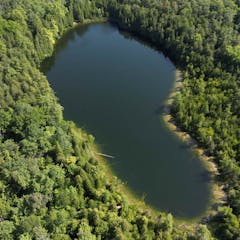
Anthropocene or not, it is our current epoch that we should be fighting for
Soren Brothers , University of Toronto
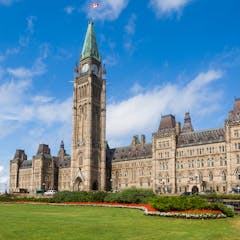
The stakes could not be higher as Canada sets its 2035 emissions target
Christopher Campbell-Duruflé , Toronto Metropolitan University

How do halibut migrate? Clues are in their ear bones
Charlotte Gauthier , Université du Québec à Chicoutimi (UQAC)
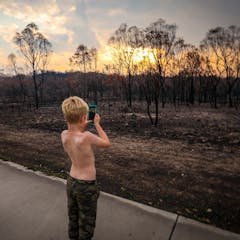
‘How long before climate change will destroy the Earth?’: research reveals what Australian kids want to know about our warming world
Chloe Lucas , University of Tasmania ; Charlotte Earl-Jones , University of Tasmania ; Gabi Mocatta , Deakin University ; Gretta Pecl , University of Tasmania ; Kim Beasy , University of Tasmania , and Rachel Kelly , University of Tasmania
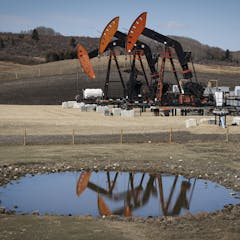
Bill C-372 : Banning fossil fuel ads does not go far enough
Peter Dietsch , University of Victoria

On a climate rollercoaster: how Australia’s environment fared in the world’s hottest year
Albert Van Dijk , Australian National University ; Shoshana Rapley , Australian National University , and Tayla Lawrie , The University of Queensland

Emissions impossible? How the transport sector can help make the 2050 net-zero goal a reality
Osman Alp , University of Calgary ; Maximiliano Udenio , KU Leuven , and Tarkan Tan , University of Zurich

Tennis anyone? Bad news for skiers as snow season could shrink by 78% this century
Adrian McCallum , University of the Sunshine Coast
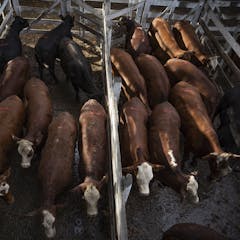
Climate-friendly beef? Argentina’s new ‘ carbon-neutral ’ certification could help reduce livestock emissions – if it’s done right
Paul Winters , University of Notre Dame

The world is not moving fast enough on climate change — social sciences can help explain why
Fayola Helen Jacobs , University of Minnesota ; Candis Callison , University of British Columbia , and Elizabeth Marino , Oregon State University
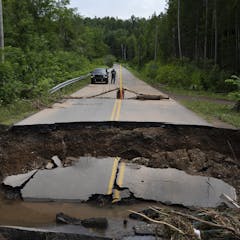
Flood risk mapping is a public good, so why the public resistance in Canada? Lessons from Nova Scotia
Kate Sherren , Dalhousie University
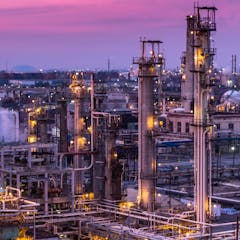
SEC approves first US climate disclosure rules: Why the requirements are much weaker than planned and what they mean for companies
Sehoon Kim , University of Florida

Campus garden initiatives can help grow the next generation of environmental change-makers
Blane Harvey , McGill University ; Emily Diane Sprowls , McGill University , and Zoë Deskin , University of Copenhagen

The Anthropocene is not an epoch − but the age of humans is most definitely underway
Erle C. Ellis , University of Maryland, Baltimore County
Related Topics
- Carbon dioxide (CO2)
- Carbon emissions
- Climate change
- Extreme weather
- Fossil fuels
- Greenhouse gas emissions (GHG)
- Intergovernmental Panel on Climate Change (IPCC)
- Paris Agreement
- Sea level rise
Top contributors
Senior Lecturer in Climate Science, The University of Melbourne
Chief Research Scientist, CSIRO Environment; Executive Director, Global Carbon Project, CSIRO
Distinguished Scholar, NCAR; Affiliate Faculty, University of Auckland, Waipapa Taumata Rau
Chief Investigator for the ARC Centre of Excellence for Climate Extremes; Deputy Director for the Australian Centre for Excellence in Antarctic Science; Deputy Director for the Centre of Excellence for 21st Century Weather, Australian National University
Research Fellow, Griffith Asia Institute, Griffith University
Adjunct professor, UNSW Sydney
Chief Investigator on the ARC Centre of Excellence for Climate Extremes; ARC Future Fellow, UNSW Sydney
Professor of International Relations, The University of Queensland
Professor and Climate Scientist, Department of Geography, Planning and Environment, Concordia University
Professor of Climate Science, University of Reading
A/Prof., School of Earth Sciences, The University of Melbourne
Climate Projections Scientist, CSIRO
Chair Professor, Climate Change Research Centre, UNSW Sydney
Scientia Professor and Deputy Director of the ARC Australian Centre for Excellence in Antarctic Science (ACEAS), UNSW Sydney
Director, ANU Institute for Climate, Energy & Disaster Solutions, Australian National University
- X (Twitter)
- Unfollow topic Follow topic

An official website of the United States government
Here’s how you know
Official websites use .gov A .gov website belongs to an official government organization in the United States.
Secure .gov websites use HTTPS A lock ( Lock A locked padlock ) or https:// means you’ve safely connected to the .gov website. Share sensitive information only on official, secure websites.
JavaScript appears to be disabled on this computer. Please click here to see any active alerts .
Climate Change Research
Fifth national climate assessment release.
Led by the U.S. Global Change Research Program and its 14 member agencies, including EPA, NCA5 is the most comprehensive analysis of the state of climate change in the United States.
Explore NCA5
EPA’s Climate Change Research seeks to improve our understanding of how climate change impacts human health and the environment.
Air Quality

Researching how changes in climate can affect air quality.
Community Resilience

Research to empower communities to become more resilient to climate change.
Ecosystems & Water Quality
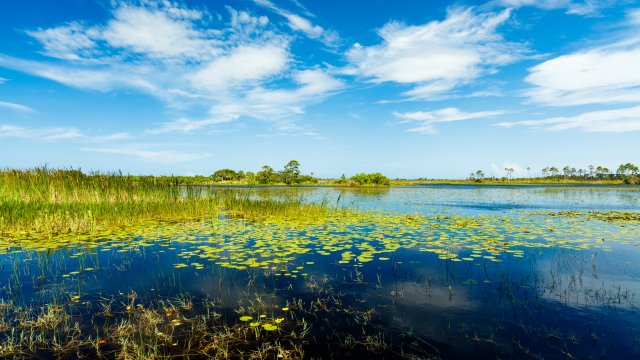
Research to understand how climate change is affecting these resources now and in the future.
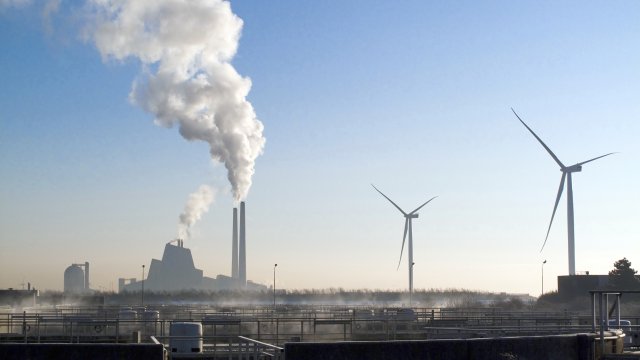
Researching how energy production will impact climate and the environment.
Human Health

Research to understand how a changing climate will impact human health.
Tools & Resources

Decision support tools, models & databases, research grants, outreach, and educational resources.
More Resources
- Publications, Presentations, and Other Research Products in Science Inventory
- Climate Change Research Milestones
- EPA's Climate Change Homepage
- EPA's Climate Adaptation Plan
- Share full article
Advertisement
Supported by
Heat Waves Are Moving Slower and Staying Longer, Study Finds
Climate change is making heat waves linger for longer stretches of time, exacerbating the effects of extreme temperatures.

By Delger Erdenesanaa
When heat waves swept across large parts of the planet last summer , in many places the oppressive temperatures loitered for days or weeks at a time. As climate change warms the planet, heat waves are increasingly moving sluggishly and lasting longer, according to a study published on Friday .
Each decade between 1979 and 2020, the rate at which heat waves travel, pushed along by air circulation, slowed by about 5 miles per day, the study found. Heat waves also now last about four days longer on average.
“This really has strong impacts on public health,” said Wei Zhang, a climate scientist at Utah State University and one of the authors of the study, which appeared in the journal Science Advances.
The longer heat waves stick around in one place, the longer people are exposed to life-threatening temperatures . As workers slow down during extreme heat, so does economic productivity . Heat waves also dry out soil and vegetation, harming crops and raising the risk of wildfires.
These changes to heat wave behavior have been more noticeable since the late 1990s, Dr. Zhang said. He attributes the changes in large part to human-caused climate change, but also in part to natural climate variability.
The study is among the first to track how heat waves move through both space and time.
Rachel White, an atmospheric scientist at the University of British Columbia who wasn’t involved in the paper, said she had been waiting to see research like this.
“We know that climate change is increasing the intensity of heat waves. We know climate change is increasing the frequency of heat waves,” Dr. White said. “But this study really helps us understand more about how that’s happening.”
Dr. Zhang and his colleagues analyzed temperatures around the world between 1979 and 2020. They defined heat waves as contiguous areas reaching a total of 1 million square kilometers (247 million acres) or more, where temperatures rose to at least the 95th percentile of the local historical maximum temperature (basically, enormous blobs of unusually hot air). The heat waves also had to last for at least three days. The researchers then measured how far these giant air masses moved over time to calculate their speed.
Over all the years they studied, heat waves slowed down by about 8 kilometers per day each decade, or nearly 5 miles per day each decade.
The average life span of heat waves has also stretched out: From 2016-20, they persisted for an average of 12 days, compared with eight days from 1979 to 1983. These longer-lived heat waves are also traveling farther, increasing the distance they travel by about 226 kilometers per decade.
The researchers also found that heat waves are becoming more frequent, to an average of 98 per year between 2016 and 2020, from 75 per year between 1979 and 1983.
There are some regional differences. Heat waves are lasting longer particularly in Eurasia and North America. And they are traveling farther particularly in South America.
To examine the role of climate change, the researchers used models to simulate temperatures in scenarios with and without the warming from human greenhouse gas emissions. They found that the scenario with these emissions was the best match for what has actually happened to heat wave behavior, indicating that climate change is a major force behind these trends.
Scientists have started to detect a larger pattern of air circulation and upper atmosphere winds like the jet streams getting weaker, at least during the summer at higher latitudes in the Northern Hemisphere. This could cause extreme weather events of all kinds to stall and overstay their welcome.
“It stands to reason that that would slow down the speed of heat waves,” said Stephen Vavrus, the state climatologist for Wisconsin. Dr. Vavrus studies atmospheric circulation but wasn’t involved in this research.
The new study did find a correlation between a weaker jet stream and slower heat waves. Dr. White, however, thinks more research is needed to determine whether the jet stream is truly the cause.
No matter the exact reasons for the slowdown, the harmful effects remain.
“It’s sort of multiple factors conspiring together,” Dr. Vavrus said. If heat waves become more frequent, more intense, last longer and cover a greater area, he said, “that really increases the concern we have for their impacts.”
Dr. Zhang is especially concerned about cities, which are often hotter than their surrounding areas because of the urban heat island effect . “If those heat waves last in the city for much longer than before, that would cause a very dangerous situation,” he said.
Alongside his atmospheric research, Dr. Zhang is helping with local efforts to plant more trees and grasses around bus stops in Salt Lake City, where people have to wait in the sun during increasingly hot summers. He suggested that cities build more cooling centers, especially for people experiencing homelessness.
“There are some things a community can do,” he said.
While waiting for international leaders to make progress on cutting greenhouse gas emissions and stopping climate change, Dr. Zhang said, local adaptation efforts are important to help keep people safer.
Delger Erdenesanaa is a reporter covering climate and the environment and a member of the 2023-24 Times Fellowship class, a program for journalists early in their careers. More about Delger Erdenesanaa
Learn More About Climate Change
Have questions about climate change? Our F.A.Q. will tackle your climate questions, big and small .
“Buying Time,” a new series from The New York Times, looks at the risky ways humans are starting to manipulate nature to fight climate change.
Big brands like Procter & Gamble and Nestlé say a new generation of recycling plants will help them meet environmental goals, but the technology is struggling to deliver .
The Italian energy giant Eni sees future profits from collecting carbon dioxide and pumping it into natural gas fields that have been exhausted.
New satellite-based research reveals how land along the East Coast is slumping into the ocean, compounding the danger from global sea level rise . A major culprit: the overpumping of groundwater.
Did you know the ♻ symbol doesn’t mean something is actually recyclable ? Read on about how we got here, and what can be done.
POLICY AND PRACTICE REVIEWS article
This article is part of the research topic.
Concept Papers from the World Climate Research Programme: The Future of Climate Research
Challenges for climate change adaptation in Latin America and the Caribbean region Provisionally Accepted

- 1 Departamento de Oceanografía Física, Center for Scientific Research and Higher Education in Ensenada (CICESE), Mexico
- 2 Departamento de Oceanografía Física, Centro de Investigación Científica y de Educación Superior de Ensenada, B.C., Mexico
- 3 Universidad de Buenos Aires-Consejo Nacional de Investigaciones Científicas y Técnicas, Departamento de Ciencias de la Atmósfera y los Océanos, Antigua and Barbuda
- 4 Department of Geography and Geology, Faculty of Science and Technology, University of the West Indies, Mona, Jamaica
- 5 Colegio de la Frontera Norte, Mexico
- 6 The University of the West Indies St. Augustine, Trinidad and Tobago
- 7 Grupo de Ingeniería y Gestión Ambiental (GIGA), Escuela Ambiental, Facultad de Ingeniería, Universidad de Antioquia, Colombia
- 8 CONICET Mendoza, Argentina
- 9 Federal University of Itajubá, Brazil
- 10 CONICET Centro de Investigaciones del Mar y la Atmósfera (CIMA), Argentina
- 11 Escuela de Física, Centro de Investigaciones Geofísicas y Centro de Investigación en Matemática Pura y Aplicada, Universidad de Costa Rica, Costa Rica
- 12 Faculty of Science and Technology, University of the West Indies, Mona, Jamaica
- 13 Institute of Engineering, National Autonomous University of Mexico, Mexico
- 14 Interamerican Institute for Global Change Research (IAI), Uruguay
- 15 ECLAC United Nations Economic Commission for Latin America and the Caribbean, Chile
The final, formatted version of the article will be published soon.
The limited success of international efforts to reduce global warming at levels established in the Paris Agreement, and the increasing frequency and strength of climate impacts, highlight the urgent need of adaptation, particularly in developing countries. Unfortunately, current levels of adaptation initiatives are not enough to counteract the observed impacts and projected risks from climate change in Latin America and the Caribbean (LAC). In this paper, we review and highlight relevant issues that have limited the capacity to transform climate knowledge and parties’ ambitions into action in the region. Current vulnerabilities and climatic impact-drivers in LAC are diverse, complex, and region-specific and their effects are expected to be exacerbated by climate change. However, the advancement of regional and domestic climate agendas has been hindered by scientific gaps, political support, institutional capacity, and financial, technical, human, and economic limitations that are common to many LAC countries. Transforming climate data into multidimensional metrics with useful thresholds for different sectors and understanding their contribution for feasible adaptation strategies are delayed by regional and local conundrums such as lack of inclusive governance, data availability, equity, justice, and transboundary issues. We discuss ways to move forward to develop local and regional climate resilient development actions and a more sustainable future in LAC. The climate science community in LAC needs to strengthen its local, national, and international connections and with decision/policymakers and society to establish a three-way engagement by proposing suitable adaptation actions and international negotiations to reduce the risks and vulnerability associated with climate extremes, climate variability and climate change in the region. The discussions and insights presented in this work could be extrapolated to other countries in the Global South.
Keywords: Adaptation challenges, Latin America and the Caribbean, Climate Change, climatic impact-drivers, gaps and commonalities, risks, Climate resilience
Received: 26 Feb 2024; Accepted: 03 Apr 2024.
Copyright: © 2024 Cavazos, Bettolli, Campbell, Sánchez Rodríguez, Mycoo, Arias, Rivera, Reboita, Gulizia, Hidalgo, Alfaro, Stephenson, Sörensson, Cerezo-Mota, Castellanos and Ley. This is an open-access article distributed under the terms of the Creative Commons Attribution License (CC BY) . The use, distribution or reproduction in other forums is permitted, provided the original author(s) or licensor are credited and that the original publication in this journal is cited, in accordance with accepted academic practice. No use, distribution or reproduction is permitted which does not comply with these terms.
* Correspondence: Mx. Tereza Cavazos, Center for Scientific Research and Higher Education in Ensenada (CICESE), Departamento de Oceanografía Física, Ensenada, Mexico
People also looked at
Thank you for visiting nature.com. You are using a browser version with limited support for CSS. To obtain the best experience, we recommend you use a more up to date browser (or turn off compatibility mode in Internet Explorer). In the meantime, to ensure continued support, we are displaying the site without styles and JavaScript.
- View all journals
Climate change articles from across Nature Portfolio
Climate change refers to a statistically defined change in the average and/or variability of the climate system, this includes the atmosphere, the water cycle, the land surface, ice and the living components of Earth. The definition does not usually require the causes of change to be attributed, for example to human activity, but there are exceptions.
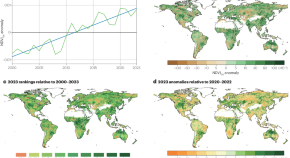
Vegetation greenness in 2023
Global greening continued into 2023, reaching near-record values that were dominated by regional enhancement in the mid-western USA, Europe, northern Australia and parts of equatorial Africa. In contrast, climatic events contributed to browning signals in Russia, Canada, Mexico and tropical drylands.
- Shilong Piao
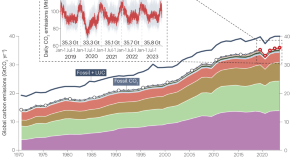
Global carbon emissions in 2023
Global CO 2 emissions for 2023 increased by only 0.1% relative to 2022 (following increases of 5.4% and 1.9% in 2021 and 2022, respectively), reaching 35.8 Gt CO 2 . These 2023 emissions consumed 10–66.7% of the remaining carbon budget to limit warming to 1.5°C, suggesting permissible emissions could be depleted within 0.5–6 years (67% likelihood).
- Philippe Ciais

Extreme terrestrial heat in 2023
Multiple relentless heatwaves occurred in 2023, with much of the world experiencing at least 20 more heatwave days than the 1991–2020 average. Prominent and record-breaking events included exceptional wintertime and spring heat in South America, large heatwaves over Europe, Africa and Asia, and a prolonged event over south-eastern USA and Central America.
- Sarah Perkins-Kirkpatrick
- David Barriopedro
- Kai Kornhuber
Related Subjects
- Attribution
- Climate and Earth system modelling
- Climate-change impacts
- Climate-change mitigation
- Projection and prediction
Latest Research and Reviews

Antarctic meteorites threatened by climate warming
Most of the meteorites on the Earth’s surface are found in Antarctica. Here the authors show that ~5,000 meteorites become inaccessible per year as they melt into the ice due to climate change.
- Veronica Tollenaar
- Harry Zekollari
- Frank Pattyn

Assessing the impact of climate change on water requirement and yield of sugarcane over different agro-climatic zones of Tamil Nadu
- K. Annadurai
- C. Navinkumar
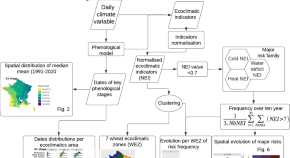
Mapping the race between crop phenology and climate risks for wheat in France under climate change
- Renan Le Roux
- Carina Furusho-Percot
- Marie Launay
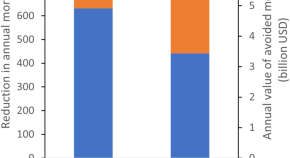
Current inequality and future potential of US urban tree cover for reducing heat-related health impacts
- Robert I. McDonald
- Tanushree Biswas
- Joseph E. Fargione

A set of guidelines as support for the integrated geo-environmental characterization of highly contaminated coastal sites
- Angela Rizzo
- Giovanni Scicchitano
- Giuseppe Mastronuzzi

Exacerbated summer European warming not captured by climate models neglecting long-term aerosol changes
Aerosol misrepresentations in many regional climate models largely explain why their simulations underestimate the summer warming in Western Europe in the past 40 years, according to a multi-model analysis.
- Dominik L. Schumacher
- Jitendra Singh
- Sonia I. Seneviratne
News and Comment
Turning a groundswell of climate action into ground rules for net zero.
Following a groundswell of voluntary net-zero targets by companies, regulators are increasingly introducing mandatory rules. If governments can overcome the barriers to rigour, coherence and fairness, such mandatory ‘ground rules’ have the potential to overcome the obstructionism that holds back a just climate transition.
- Thomas Hale
- Thom Wetzer
- Rupert Stuart-Smith

Chronicling the climate of 2023
Nature Reviews Earth & Environment launches a new series of articles — Climate Chronicles — that document the characteristics and changes of select climate variables each year.
Climate policy in 2023
In 2023, national and international climate policy advanced in many areas but also faced substantial domestic hurdles in others. Countries agreed on new global initiatives and many major emitters expanded national climate policies. However, others rolled back existing policies and continued to support fossil fuels, slowing down global progress.
- Leonardo Nascimento
- Catrina Godinho
- Niklas Höhne
Quick links
- Explore articles by subject
- Guide to authors
- Editorial policies
80 Best Global Warming Essay Topics and Ideas
Table of Contents
Do you need unique global warming essay topics and ideas? If yes, then you are at the perfect spot. For students like you, in this blog, we have compiled a list of interesting essay ideas on global warming. Additionally, we have also explained how to choose a good topic and prepare a brilliant global warming essay.
Global warming is one of the major issues that have been in this world since the pre-industrial period due to human activities. Mainly, because of global warming, the earth experiences a lot of negative effects such as the increasing sea levels, changing weather, and biodiversity threat. Furthermore, all these effects create a big impact on the social and economic status of a country.
Usually, when it comes to preparing a global warming essay, you may choose to write about different aspects of global warming and its causes and effects. Some themes you may consider for your essay examination on global warming are carbon dioxide emissions, industrialization, deforestation, sustainable practices, environment conservation efforts, and so on. Continue reading this blog and get exclusive global warming essay ideas.
Know How to Choose a Global Warming Essay Topic
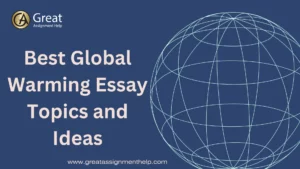
The topic you select will guarantee the success of your essay. So, put some effort into identifying the right global warming essay topics. The following are the steps that will help you spot the best topic for your global warming essay.
- First, determine the area or theme of your interest. For your global warming essay, you may choose any theme like industrialization, climate change, conservation strategies, etc.
- Next, in the selected theme, search and gather numerous global warming essay ideas to focus on. For data collection, you may refer to already published research papers, magazines, and journals.
- Analyze all the collected ideas and narrow down the list based on its scope of discussion and sources availability.
- Review the shortlisted ideas and pick one ideal topic that meets your essay writing guidelines.
- Before finalizing the topic, discuss it with your instructors and get their feedback.
Also Read: 75+ Top Global Issues Research Paper Topics
Steps for Writing a Global Warming Essay
Do you wonder how to write a global warming essay? If yes, then follow these steps.
- Identify a perfect topic for your global warming essay on any relevant theme that you are more interested in.
- On the chosen topic, conduct in-depth research and gather necessary ideas for discussion. When performing research, you may take support from relevant credible sources such as journals, articles, magazines, etc.
- Organize all the gathered ideas and come up with a neat global warming essay outline containing essential elements such as the introduction, body, and conclusion.
- Elaborate on the outline and create an informative global warming essay as per the provided essay writing guidelines. Remember, in your essay, you should make sure to present the arguments with valid facts, statistics, and evidence.
- Lastly, after you finish writing the essay, proofread it multiple times. The final draft of the essay that you are about to submit should be original, accurate, and flawless.
List of Global Warming Essay Topics and Ideas
Are you searching for the best global warming essay prompts? Take a look at the list published below. In the list, we have shared outstanding global warming essay ideas that are worth discussing.
Simple Global Warming Essay Topics
- Prepare an essay on the history of global warming.
- Discuss the long-term consequences that global warming may have for humanity.
- Explain the difference between climate change and global warming.
- Discuss the impact of global warming on plants.
- Write an essay on volcanic activity and global warming.
- Examine the social consequences of increasing temperature.
- Explain what natural disasters may result from global warming.
- Write about the technologies that can reduce global warming.
- Discuss the basic mechanism behind greenhouse gases.
- Analyze the impact of global warming on oceans.
Best Global Warming Essay Ideas
- Examine the consequences of global warming on the soil.
- Analyze the impact of surface-level ozone distortions on ecology.
- Discuss the anthropogenic factors of climate change.
- Examine how clouds amplify global warming.
- Analyze the natural factors that drive global warming.
- Explain the correlation between solar radiation and global warming.
- Discuss the future threats of global warming.
- Analyze the effects of global warming on marine wildlife.
- Examine the impact of fluorinated gases on the ecosystem.
- Discuss the impact of global warming on Arctic permafrost.
- Explain the difference between the greenhouse effect and global warming.
- Discuss the influence of global warming on oil prices.
- Examine the impact of global warming on the flowering season.
- Take a look at the pros and cons of carbon dioxide removal in global warming.
- Explain how global warming affects the composition of flora and fauna.
Top Global Warming Essay Topics
- Write about the theoretical models that can be used to research global warming.
- Examine the influence of environmental research on global warming.
- Discuss the effects of water vapor on global warming.
- Prepare an essay on global warming laws.
- Explain the biological repercussions of global warming.
- Analyze the effect of global warming on the American communities.
- Explain the relevance of Arctic warming to global warming.
- Discuss the impact of global warming on social change.
- Examine how global warming brings infectious diseases.
- Discuss the implications of global warming for future climate policies.
- Take a look at the socioeconomic consequences of global warming.
- Analyze the effects of urbanization on global warming in cities.
- Discuss the impact of fast fashion on global warming.
- Examine the relation between human population size and global warming.
- Examine how car emissions affect global warming.
Excellent Global Warming Essay Questions
- Examine renewable energy potential in combating global warming.
- Discuss the public health concerns due to global warming.
- Write an essay on global warming and tourism.
- Discuss the contribution of deforestation to global warming.
- Write about the world heritage sites that are under threat from global warming.
- Analyze the correlation between global warming and biodiversity threat.
- Discuss the relationship between desertification and global warming.
- Analyze ecological footprint in the context of global warming.
- Examine the carbon budget and global warming of existing models.
- Explain how global warming affects the world’s water supply.
- Analyze the influence of global warming on atmospheric circulation patterns.
- Write about heat waves and global warming.
- Analyze the impact of global warming on tropical cyclone intensity.
- Write about global warming and capitalism.
- Discuss the threat of global warming to food security.
Latest Global Warming Essay Topics
- Discuss the influence of global warming on polar vortex patterns.
- Examine the link between global warming and vector-borne diseases.
- Discuss the cause-effect relationship between global warming and carbon dioxide emissions.
- Write about the input of the transport industry to global warming.
- Explain the role of global warming in expanding desert areas.
- Discuss the economic aspects of global warming and climate change.
- Explain what accelerates and counteracts global warming.
- Examine how the public engages with global warming.
- Analyze the spatial economic impact of global warming.
- Explain how global warming affects tropical rainforests.
- Investigate the biological consequences of global warming.
- Write about global warming and decreased crop production.
- Explain how global warming affects polar bears.
- Examine the principle behind iron seeding oceans in resolving global warming.
- Discuss the effects of global warming on coastal cities.
Also Read: 90 Latest Global Issues Essay Topics and Ideas
Outstanding Global Warming Essay Topics
- Explain the prospects of the Kyoto Protocol.
- Suggest some promising ideas to prevent global warming.
- Analyze the factors that affect the temperature of the Earth.
- Examine the consequences of rising temperature at the Ocean’s surface.
- Discuss the impact of Aerosol production on air temperatures.
- Examine the link between Earth’s rotation and increasing air temperatures.
- Analyze the impact of greenhouse gases.
- Explain the key features of climate theories.
- Analyze the impact of pollution on the marine ecology.
- Discuss the role of hydropower usage in halting climate change.
Wrapping Up
Hopefully, by now, you will have selected a topic for your global warming essay. In case, you need any other amazing global warming essay topics or if you need global warming essay writing help from an expert, call us quickly.
At greatassignmenthelp.com, we have the finest essay writers with strong knowledge of global warming to provide the best essay writing services that include topic selection, writing, and editing. By using, their expertise they will assist you in composing a high-quality and plagiarism-free global warming essay as per your requirements. Most importantly, by getting our global warming assignment help , you can complete your work ahead of the deadline, gain more knowledge of the subject, and achieve top grades.
Related Post

100 Funny Speech Topics To Entertain the Audience

90 Latest Global Issues Essay Topics and Ideas

100 Best Qualitative Research Topics To Deal With
About author.
Jacob Smith
Jacob Smith guides students with writing research paper topics and theses at greatassignmenthelp.com. Read about the author from this page
https://www.greatassignmenthelp.com/
Leave a Reply Cancel reply
Your email address will not be published. Required fields are marked *
- Featured Posts
200 Impressive Business Essay Topics
175 unique bioethics topics to consider for academic paper, apa vs. mla: know the major differences between the citation styles, top 155 java project ideas for beginners and experts, 150+ unique psychology research topics and ideas, 190 unique philosophy research topics, 119 excellent high school essay topics for students, nim vs. rust: get to know the key differences, 190 excellent sustainability research topics, get help instantly.
Raise Your Grades with Great Assignment Help
Using pulp and paper waste to scrub carbon from emissions
Researchers at McGill University have come up with an innovative approach to improve the energy efficiency of carbon conversion, using waste material from pulp and paper production.
The technique they've pioneered using the Canadian Light Source at the University of Saskatchewan not only reduces the energy required to convert carbon into useful products, but also reduces overall waste in the environment.
"We are one of the first groups to combine biomass recycling or utilization with CO 2 capture," said Ali Seifitokaldani, Assistant Professor in the Department of Chemical Engineering and Canada Research Chair (Tier II) in Electrocatalysis for Renewable Energy Production and Conversion. The research team, from McGill's Electrocatalysis Lab, published their findings in the journal RSC Sustainability .
Capturing carbon emissions is one of the most exciting emerging tools to fight climate change. The biggest challenge is figuring out what to do with the carbon once the emissions have been removed, especially since capturing CO 2 can be expensive. The next hurdle is that transforming CO 2 into useful products takes energy. Researchers want to make the conversion process as efficient and profitable as possible.
- Energy and Resources
- Energy Technology
- Energy and the Environment
- Environmental Science
- Renewable Energy
- Global Warming
- Hazardous waste
- Photosynthesis
- Climate change mitigation
- Radioactive waste
- Carbon cycle
- Carbon dioxide
Story Source:
Materials provided by McGill University . Note: Content may be edited for style and length.
Journal Reference :
- Roger Lin, Haoyan Yang, Hanyu Zheng, Mahdi Salehi, Amirhossein Farzi, Poojan Patel, Xiao Wang, Jiaxun Guo, Kefang Liu, Zhengyuan Gao, Xiaojia Li, Ali Seifitokaldani. Efficient integration of carbon dioxide reduction and 5-hydroxymethylfurfural oxidation at high current density . RSC Sustainability , 2024; 2 (2): 445 DOI: 10.1039/D3SU00379E
Cite This Page :
Explore More
- Soft, Flexible 'Skeletons' for 'Muscular' Robots
- Toothed Whale Echolocation and Jaw Muscles
- Friendly Pat On the Back: Free Throws
- How the Moon Turned Itself Inside Out
- A Welcome Hug Is Good for Your Health
- Climate Change Threatens Antarctic Meteorites
- Precise Measurement of Our Expanding Universe
- Little Research On 'Polycrisis' Humanity Faces
- Prebiotic Molecular Kitchen
- A Neurodegenerative Disease Triggered by Virus
Trending Topics
Strange & offbeat.

IMAGES
VIDEO
COMMENTS
Worldwide observed and anticipated climatic changes for the twenty-first century and global warming are significant global changes that have been encountered during the past 65 years. ... 55 articles are reviewed systematically and analyzed for research topics and other aspects, such as the methods, contexts, and theories used in these studies ...
MAIN IDEAS. Climate chang e refers to long-term shifts in weather patterns. Global warming is the increase in the planet's average surface temperatures caused by human activities such as the burning of fossil fuels. Causes of climate change related to human activity are referred to as anthropogenic.
Modern global warming is the result of an increase in magnitude of the so-called greenhouse effect, a warming of Earth's surface and lower atmosphere caused by the presence of water vapour, carbon dioxide, methane, nitrous oxides, and other greenhouse gases. In 2014 the IPCC first reported that concentrations of carbon dioxide, methane, and ...
Increasing exposure to climate hazards under climate change will disproportionately impact poor communities. This study shows that disruptions to infrastructure service threaten progress towards ...
How researchers can help fight climate change in 2022 and beyond. COP26 energized the global effort to halt global warming. Research is now crucial to monitoring progress and creating solutions ...
research articles. Research articles. Filter By: Article Type. All. All; Analysis (8) ... Matters Arising (2) Year. 2021 (115) All; 2021 (115) Global warming decreases connectivity among coral ...
In particular, the search for solutions to climate change forces us to examine the way different disciplines interact in this process, most prominently through interdisciplinary research approaches (Castree et al. 2014 ). In response to pressure for concrete, urgent, and actionable information, however, researchers often shear away detail, and ...
Climate Explained, a part of Yale Climate Connections, is an essay collection that addresses an array of climate change questions and topics, including why it's cold outside if global warming is real, how we know that humans are responsible for global warming, and the relationship between climate change and national security.
What is global warming? Global warming causes, effects, extreme weather, facts, and relation to climate change. ... including a 2018 paper published in the journal Environmental Research Letters, ...
About Global Warming. Though the terms global warming and climate change are often used interchangeably, they have different meanings. Climate change describes long-term shifts in the earth's weather patterns that affect such factors as temperature, humidity, wind, cloud cover, and precipitation levels. Global warming specifically refers to an ...
The main activity of the IPCC is to, at regular intervals, provide Assessment Reports of the state of knowledge on climate change. The IPCC is now in its sixth assessment cycle, in which it is producing the Sixth Assessment Report (AR6) with contributions by its three Working Groups and a Synthesis Report, three Special Reports, and a refinement to its latest Methodology Report.
A few decades later, a paper by Guy Callendar in 1938 linked the increase in carbon dioxide concentration over the previous 50 years to rising temperatures. Entitled, "The artificial production of carbon dioxide and its influence on temperature," the paper marked an important step forward in climate change research, says Andrew Solow, director of the Woods Hole Marine Policy centre and ...
The paper introduces global warming, elaborates its causes and hazards and presents some solutions to solve this hot issue. Above all, alternative energy sources (solar, wind, hydro, geothermal ...
183 Global Warming Essay Topics. NASA named July 2023 as the hottest month ever since 1880. This news cannot be ignored, and we suggest delving into this urgent issue that is reshaping our planet. In this compilation of global warming essay topics, you will find title ideas about how human activities impact the environment, what collective ...
Nature Climate Change is dedicated to publishing the most significant research across the physical and social sciences on the impacts of global climate change and its implications for the economy ...
Global Warming Causes, Effects and Solutions. This paper is an in-depth evaluation of the facts surrounding global warming, and it seeks to establish the causes and effects of the phenomenon, and proposes solutions for mitigating the effects of global warming. Global Warming and Climate Change: Annotated Bibliography.
Abstract: The Paris Agreement established that global warming should be limited to "well below" 2?C and encouraged efforts to limit warming to 1.5?C. Achieving this goal presents a significant challenge, especially given the presence of (i) economic inertia and adjustment costs, which penalize a swift transition away from fossil fuels, and (ii) climate uncertainty that, for example ...
Global warming is the long-term warming of the planet's overall temperature. Though this warming trend has been going on for a long time, its pace has significantly increased in the last hundred years due to the burning of fossil fuels.As the human population has increased, so has the volume of . fossil fuels burned.. Fossil fuels include coal, oil, and natural gas, and burning them causes ...
Charles-Francois de Lannoy, McMaster University; Bassel A. Abdelkader, McMaster University, and Jocelyn Riet, University of Toronto. Global warming is making the oceans more acidic. Our work aims ...
Led by the U.S. Global Change Research Program and its 14 member agencies, including EPA, NCA5 is the most comprehensive analysis of the state of climate change in the United States. EPA's Climate Change Research seeks to improve our understanding of how climate change impacts human health and the environment.
Our paper, Global Warming in the Pipeline,1 was greeted by a few scientists, ... This topic provides an example of why our three-pronged research approach is ... Kharecha P, Sato, M. Global warming acceleration, research and publication priorities, 14 Feb 2024 3 Jin Q, Grandey BS, Rothenberg D et al. Impacts on cloud radiative effects induced ...
March 29, 2024. When heat waves swept across large parts of the planet last summer, in many places the oppressive temperatures loitered for days or weeks at a time. As climate change warms the ...
The limited success of international efforts to reduce global warming at levels established in the Paris Agreement, and the increasing frequency and strength of climate impacts, highlight the urgent need of adaptation, particularly in developing countries. ... This article is part of the Research Topic. Concept Papers from the World Climate ...
Global CO 2 emissions for 2023 increased by only 0.1% relative to 2022 (following increases of 5.4% and 1.9% in 2021 and 2022, respectively), reaching 35.8 Gt CO 2. These 2023 emissions consumed ...
Write about global warming and decreased crop production. Explain how global warming affects polar bears. Examine the principle behind iron seeding oceans in resolving global warming. Discuss the effects of global warming on coastal cities. Also Read: 90 Latest Global Issues Essay Topics and Ideas.
Using pulp and paper waste to scrub carbon from emissions. ScienceDaily . Retrieved April 8, 2024 from www.sciencedaily.com / releases / 2024 / 04 / 240408130636.htm
2. Uploaded by AmbassadorNeutron12037 on coursehero.com. VIEW FULL DOCUMENT. Jordan Altreche Evaluating Global Warming 1. Proposed research topic: a. What is the proposed topic of your paper? El Nino. (Ocean and Weather cycles) b. Why did you choose this topic? I chose this topic because we experienced El Nino in 2023, a warmer, drier season.